
BY ORDER OF THE
SECRETARY OF THE AIR FORCE
DEPARTMENT OF THE AIR FORCE
PAMPHLET 63-123
14 APRIL 2022
Acquisition
PRODUCT SUPPORT BUSINESS CASE
ANALYSIS
ACCESSIBILITY: This publication is available on the e-Publishing website at www.e-
publishing.af.mil for downloading or ordering.
RELEASABILITY: There are no releasability restrictions on this publication.
OPR: SAF/AQD Certified by: SAF/AQD
(Ms. Angie Tymofichuk)
Supersedes: AFPAM 63-123, 1 June 2017 Pages: 124
This Department of the Air Force Pamphlet (DAFPAM) complements Air Force Instruction (AFI)
63-101/20-101, Integrated Life Cycle Management. It provides informational guidance and
recommended procedures for executing a Product Support Business Case Analysis (PS-BCA).
Additional non-mandatory guidance on best practices, lessons learned, and expectations are
available in the Department of Defense Product Support BCA Guidebook. To ensure
standardization, any United States Space Force (USSF) or United States Space Force (USAF)
organization supplementing this publication will send the implementing publication to the
Assistant Secretary of the Air Force/Product Support and Logistics (SAF/AQD) for review and
coordination before publishing. This publication applies to the Regular Air Force, the Air Force
Reserve, the Air National Guard, and, unless and until such time as independent guidance is issued,
the United States Space Force. It also applies to other individuals or organizations as required by
binding agreement or obligation with the Department of the Air Force (DAF). Note: Until such
time as the USSF issues its own guidance, all references to United States Air Force (USAF)
terminology, units, and positions will also apply to the equivalent in the USSF, as appropriate. For
example, references to Airmen will also apply to Guardians. References to MAJCOMs or NAFs
will also apply to Field Commands. References to wings will also apply to deltas/garrisons. Air
Staff roles and responsibilities (i.e. AF/A4) may also apply to the equivalent Office of the Chief
of Space Operations (Space Staff) office (i.e. SF/COO, etc), as appropriate. For nuclear systems
or related components ensure the appropriate nuclear regulations are applied as specified in AFI
63-101/20-101. Refer recommended changes and questions about this publication to the OPR
listed above using Air Force (AF) Form 847, Recommendation for Change of Publication; route
AF Forms 847 from the field through the appropriate chain of command. Ensure that all records
created as a result of processes prescribed in this publication are maintained in accordance with

2 DAFPAM63-123 14 APRIL 2022
AFI 33-322, Records Management and Information Governance Program, and disposed of in
accordance with the Air Force Records Disposition Schedule (RDS) in the Air Force Records
Information Management System (AFRIMS). The use of the name or mark of any specific
manufacturer, commercial product, commodity, or service in this publication does not imply
endorsement by the Air Force.
SUMMARY OF CHANGES
This document has been substantially revised and should be completely reviewed. It reflects
process improvements, evolving best practices, organizational structure changes, and
administrative updates.
Chapter 1—OVERVIEW 7
1.1. Product Support Business Case Analysis (PS-BCA) Pamphlet Overview. ............. 7
1.2. Business Case Analysis (BCA). ............................................................................... 7
1.3. Product Support Business Case Analysis (PS-BCA). .............................................. 8
Figure 1.1. Product Support BCA Elements. ............................................................................. 9
Figure 1.2. Four Major Areas for 12 IPS Elements. ................................................................... 10
1.4. When to Conduct a PS-BCA.................................................................................... 11
Figure 1.3. PS-BCA Schedule Throughout the Life Cycle. ....................................................... 12
Figure 1.4. Step #1 of the PS-BCA Decision Tree. .................................................................... 13
Table 1.1. Step #1 Decision Tree Process Flow. ...................................................................... 13
Figure 1.5. Step #2 of the PS-BCA Decision Tree. .................................................................... 15
Table 1.2. Step #2 Decision Tree Process Flow. ...................................................................... 15
Figure 1.6. Step #3 of the PS-BCA Decision Tree. .................................................................... 17
Table 1.3. Step #3 Decision Tree Process Flow. ...................................................................... 17
Figure 1.7. Step #4 of the PS-BCA Decision Tree. .................................................................... 19
Table 1.4. Step #4 Decision Tree Process Flow. ...................................................................... 19
Figure 1.8. Step #5 of the PS-BCA Decision Tree. .................................................................... 21
Table 1.5. Step #5 Decision Tree Process Flow. ...................................................................... 21
Figure 1.9. Step #6 of the PS-BCA Decision Tree. .................................................................... 23
Table 1.6. Step #6 Decision Tree Process Flow. ...................................................................... 24
1.5. PS-BCA Process Overview...................................................................................... 25
Figure 1.10. PS-BCA Process Map. ............................................................................................. 25
Chapter 2—ROLES AND RESPONSIBILITIES 26
2.1. PS-BCA IPT Members. ........................................................................................... 26
DAFPAM63-123 14 APRIL 2022 3
2.2. Approval Level. ....................................................................................................... 26
2.3. Milestone Decision Authority (MDA). .................................................................... 26
2.4. Governance Structure. ............................................................................................. 27
Figure 2.1. MDAP/MAIS ACAT I and Special Interest OSD Programs. .................................. 28
Figure 2.2. ACAT II and III Programs. ...................................................................................... 29
2.5. PS-BCA IPT Roles, Responsibilities, and Functions. ............................................. 31
Chapter 3—PLANNING FOR THE PRODUCT SUPPORT BUSINESS CASE ANALYSIS. 38
3.1. PS-BCA IPT Kickoff Meeting. ................................................................................ 38
3.2. Preparation for Kickoff Meeting. ............................................................................. 38
3.3. Identify and Establish the PS-BCA IPT. .................................................................. 39
Table 3.1. IPT Membership. ..................................................................................................... 39
3.4. Kickoff Meeting. ...................................................................................................... 41
Table 3.2. Integrated Product Support (IPS) Element Categorization. ..................................... 43
Chapter 4—COURSES OF ACTION 48
4.1. Introduction. ............................................................................................................. 48
4.2. Status Quo ................................................................................................................ 48
4.3. Future State COAs. .................................................................................................. 48
Table 4.1. Holistic Approach. ................................................................................................... 49
Table 4.2. Modular Approach. .................................................................................................. 49
4.4. Reasonableness and Feasibility. ............................................................................... 50
Chapter 5—BENEFITS AND NON-FINANCIAL ANALYSIS 53
5.1. Benefits Introduction. .............................................................................................. 53
5.2. Selecting Benefits. ................................................................................................... 53
Table 5.1. Category Metric Attribute. ....................................................................................... 54
5.3. Quantitative Benefits and Metrics. .......................................................................... 54
Table 5.2. Quantitative Benefits and Associated Metrics. ........................................................ 55
5.4. Qualitative Benefits and Metrics. ............................................................................ 55
Chapter 6—COST AND FINANCIAL ANALYSIS 57
6.1. PS-BCA Cost Estimates. .......................................................................................... 57
6.2. Criteria 1 – Guided by the Problem Statement. ....................................................... 57
6.3. Criteria 2 – GR&As are Reasonable and Documented. ........................................... 57
6.4. Criteria 3 – Properly Utilizes the Various Types of Analysis. ................................. 58
4 DAFPAM63-123 14 APRIL 2022
6.5. Criteria 4 – Properly Utilizes the Highest Quality Data Available. ......................... 59
6.6. Criteria 5 – Data is Normalized, Projected and Used Correctly. ............................. 59
Figure 6.1. Illustration of Inflation, Price Escalation, and Real Price Change. .......................... 60
Figure 6.2. Considerations When Normalizing Data for Usage or Quantity (or Duration). ...... 61
6.7. Criteria 6 – Cost Estimates Accurately Represent the PSS for Each COA. ............ 62
6.8. Criteria 7 – Ensure Cost Risk is Handled Consistently for Each COA. .................. 62
6.9. Criteria 8 – Enables Decision Maker to Make the Most Informed Decision
Possible. ................................................................................................................... 63
Chapter 7—RISK ASSESSMENT 64
7.1. Introduction to Risk Assessment. ............................................................................ 64
7.2. Defining Risk. .......................................................................................................... 64
7.3. Progression of Risk. ................................................................................................. 64
7.4. Classifications of Risk. ............................................................................................ 65
7.5. Risk Management Planning. .................................................................................... 65
7.6. Risk Identification. ................................................................................................... 65
7.7. Risk Analysis. .......................................................................................................... 65
7.8. Risk Handling Planning & Implementation. ............................................................ 66
7.9. Risk Tracking. .......................................................................................................... 67
7.10. Risk Management Summary. ................................................................................... 67
Chapter 8—DETERMINING EVALUATION FRAMEWORK, WEIGHTING, AND
SCORING 68
8.1. Weighted Utility Score (WUS) and Multi-Objective Decision Analysis (MODA). 68
8.2. COA Evaluation. ...................................................................................................... 68
Figure 8.1. Weighted Utility Score (WUS). ............................................................................... 68
Figure 8.2. WUS Framework - No Weighting Assigned. .......................................................... 69
Figure 8.3. WUS Framework – Criteria Weighting (Notional Data). ........................................ 69
Figure 8.4. MODA Framework – Criteria Weighting (Notional Data). ..................................... 70
8.3. Steps to Build the WUS or MODA Framework. ..................................................... 70
Figure 8.5. Cumulative Impacts of WUS. .................................................................................. 72
Figure 8.6. Updated WUS Framework. ...................................................................................... 73
8.4. Displaying the Results – WUS and MODA (Cost Capability Analysis). ................ 74
Figure 8.7. Risk Cube. ................................................................................................................ 75
Figure 8.8. COA Weighting. ...................................................................................................... 75
DAFPAM63-123 14 APRIL 2022 5
Figure 8.9. WUS Display (Example 1). ..................................................................................... 76
Figure 8.10. WUS Display (Example 2). ..................................................................................... 76
Figure 8.11. MODA. .................................................................................................................... 78
Chapter 9—DATA SELECTION, COLLECTION AND ASSESSMENT 79
9.1. Quality Data Collection. .......................................................................................... 79
9.2. Data Selection. ......................................................................................................... 79
Table 9.1. Milestone Data Maturity. ......................................................................................... 79
Table 9.2. Data Quality Tiers. ................................................................................................... 81
Table 9.3. Potential PS-BCA Data Sources. ............................................................................. 81
Table 9.4. Example – Data Requirements and Selection. ......................................................... 83
Table 9.5. Data Plan Considerations. ........................................................................................ 84
Chapter 10—SENSITIVITY ANALYSIS AND EVALUATION 88
10.1. Sensitivity Analysis Defined.................................................................................... 88
10.2. Risk and Uncertainty. .............................................................................................. 88
10.3. Variables. ................................................................................................................. 88
10.4. Steps in Conducting a Sensitivity Analysis. ............................................................ 88
10.5. Examples for Using Sensitivity Analysis. ............................................................... 89
10.6. Applying Sensitivity Analysis to Weighting and Scoring of Benefits. .................... 90
Table 10.1. COAs and Attributes. ............................................................................................... 90
Table 10.2. Raw Weights. ........................................................................................................... 90
Table 10.3. Scaled Weights. ....................................................................................................... 90
Table 10.4. COAs, Attributes, Raw and Scaled Weights............................................................ 91
Figure 10.1. COAs Weighted Benefit Scores vs Their Cost. ....................................................... 91
Table 10.5. Sensitivity Analysis Adjustment. ............................................................................. 92
Figure 10.2. COAs Weighted Benefit Scores vs Their Cost after Weight Changes. ................... 92
Figure 10.3. Sensitivity Analysis Displays. ................................................................................. 93
10.7. Applying Sensitivity Analysis to Benefits. .............................................................. 93
10.8. Shifting Attribute Scores. ........................................................................................ 93
Figure 10.4. Global Sensitivity Analysis for Supply Support. ..................................................... 94
Figure 10.5. Global Sensitivity Analysis for Sustaining Engineering. ......................................... 94
10.9. Tipping Point. .......................................................................................................... 95
6 DAFPAM63-123 14 APRIL 2022
Chapter 11—FINDINGS, RECOMMENDATION, APPROVAL AND
IMPLEMENTATION FOR THE FINAL PRODUCT SUPPORT
BUSINESS CASE ANALYSIS REPORT 96
11.1. PS-BCA Report. ....................................................................................................... 96
Table 11.1. PS-BCA Report Process. ......................................................................................... 96
11.2. PS-BCA Findings. ................................................................................................... 96
Table 11.2. Findings Summary. .................................................................................................. 96
Table 11.3. Cost to the Program Output Example. ..................................................................... 99
Table 11.4. Alternative Comparisons. ........................................................................................ 99
Figure 11.1. COA Example for Transition Plans. ........................................................................ 100
Table 11.5. Outline for PS-BCA Out-Brief. ............................................................................... 100
Table 11.6. PS-BCA Final Report Outline. ................................................................................ 102
Table 11.7. Implementation Plan Outline. .................................................................................. 103
Attachment 1—GLOSSARY OF REFERENCES AND SUPPORTING INFORMATION 105
Attachment 2—LEGACY PROGRAM PRODUCT SUPPORT BUSINESS CASE
ANALYSIS SUFFICIENCY MEMORANDUM 112
Attachment 3—PROCESS NARRATIVE 113

DAFPAM63-123 14 APRIL 2022 7
Chapter 1
OVERVIEW
1.1. Product Support Business Case Analysis (PS-BCA) Pamphlet Overview. Product
Support Business Case Analysis (PS-BCA) Pamphlet. This is designed to assist the PS-BCA Team
in developing comprehensive Product Support (PS) strategies that achieve the optimal balance
between warfighter capabilities and affordability (i.e., best-value). The pamphlet covers key areas
that the PS-BCA Team needs to consider when developing an effective PS-BCA. The pamphlet
provides a standardized format, assists in developing and evaluating courses of action (COAs),
recommends useful decision support methodologies that enhance defendable decision making
processes, and provides guidance on developing the PS-BCA report. Additionally, the pamphlet
provides examples and best practices, identifies existing laws, integrates Department of Defense
(DoD) guidance located in the DoD Product Support BCA Guidebook (April 2011), and
supplements existing Air Force Manuals (AFMANs) such as AFMAN 65-506, Economic Analysis
(September 2019). The focus of the pamphlet is on Major Defense Acquisition Programs
(MDAPs), however, the techniques provided can also be applied to any program using any
acquisition pathway.
1.2. Business Case Analysis (BCA). A Business Case Analysis (BCA) is a decision support
document that identifies COAs and then presents convincing business (both financial and non-
financial) impacts, risks, sensitivities, and technical arguments for selecting a specific COA that
will achieve desired objectives. A BCA provides a fair and objective study that leads to a decision,
not justify a decision after the fact. Specifically, a BCA is a comparative analysis product that fits
under the umbrella of the economic analysis approach. All BCAs are required to follow the
guidance in AFI 65-501, Economic Analysis, and AFMAN 65-506.
AFMAN 65-506 provides more detailed information on the elements that must be addressed as
part of the economic analysis approach whereas this pamphlet provides the standardized format
for completing BCAs as well as lessons learned and best practices.
1.2.1. Introduction. Defines what the business case is about (subject), why (purpose) it is
necessary, what the objectives are, and who the decision maker is for the BCA.
1.2.2. Problem Statement. Concisely defines the problem, requirement or opportunity being
analyzed. What problem is trying to be solved and is it realistic? What is the scope of the
analysis? The problem statement helps define the analysis framework.
1.2.3. Methods and Parameters. States the analysis methods and rationale that will fix the
boundaries of the business case (the costs and benefits examined over what time period). This
section also outlines the rules for deciding what belongs in the analysis and what does not.
Facts, ground rules, and assumptions are parameters that must be explicitly stated on what is
believed to be true of a current or identify future state of affairs. Further details regarding each
of these parameters can be found in AFMAN 65-506, Section 2.4.
1.2.4. Business and Operational Impacts. Documents costs, benefits and non-monetary
benefits impacting business and operational results for each COA.
1.2.5. Risk Analysis. Evaluates the probability of negative events occurring in each COA and
their impact on desired objectives.

8 DAFPAM63-123 14 APRIL 2022
1.2.6. Sensitivity Analysis. Demonstrates how the BCA results are affected by changes in key
variables such as assumptions, weightings, and key data drivers in the analysis. AFMAN 65-
506 requires a sensitivity analysis to test the effect that major assumptions have on analysis
results.
1.2.7. Recommendation and Implementation Plan. Recommends a preferred COA and the
action plan required to achieve desired objectives.
1.2.7.1. Per the DoD Product Support BCA Guidebook and AFMAN 65-506, a BCA does
not replace the judgment of the decision maker, but rather provides an analytic and uniform
foundation that allows decision makers to make informed decisions. A BCA can vary in
size and scope, is developed in an unbiased manner, and is not constructed to justify a
preordained decision. A key element in constructing an effective BCA is acquiring
sufficient data from reliable sources and then analyzing the information utilizing a
consistent methodology. With the same data and comprehensive documentation, readers
not familiar with the analysis should be able to replicate the analysis and arrive at the same
conclusions.
1.3. Product Support Business Case Analysis (PS-BCA).
1.3.1. Decision Support Document. A PS-BCA is a decision support document that assists
Product Support Managers (PSMs) in developing COAs for product support strategies using
the best value approach, which incorporates Integrated Product Support (IPS) elements.
Attachment 1 defines best value per the Federal Acquisition Regulation (FAR).
1.3.2. PS-BCA Process. The PS-BCA is an iterative process that incorporates organizational
or programmatic changes. PS-BCAs can be used for a number of purposes to include the
following:
Determine whether or not to change Product Support Strategy (PSS)
Determine whether or not to invest in product support
Determine whether or not to select among COAs
Validate proposed scope, schedule, or budget changes during the course of the program
1.3.3. Product Support Decisions. The PS-BCA supports major product support decisions,
especially those that result in new or changed resource requirements. Program Managers
(PMs) are responsible for deploying the PSS and monitoring its performance according to the
Life Cycle Sustainment Plan (LCSP). While the PS-BCA assists in the leaders’ decision
making process, it does not supersede or overturn other statutory requirements (e.g., 10 USC
§2464, Core Logistics Capabilities, 10 USC §2466, Limitations on the performance of depot-
level maintenance of materiel.
1.3.4. Major Elements. The PS-BCA has three major elements: purpose, process components,
and quality foundation (see Figure 1.1 below) that work together to ensure the PS-BCA targets
the relevant subject matter, analyzes and reports the results, and integrates into the
organization’s mission and vision.
1.3.4.1. Purpose. Identifies the problem statement, objectives, metrics, desired outcomes,
and requirements. The purpose annotates what problem the PS-BCA is attempting to solve
and how to measure success.
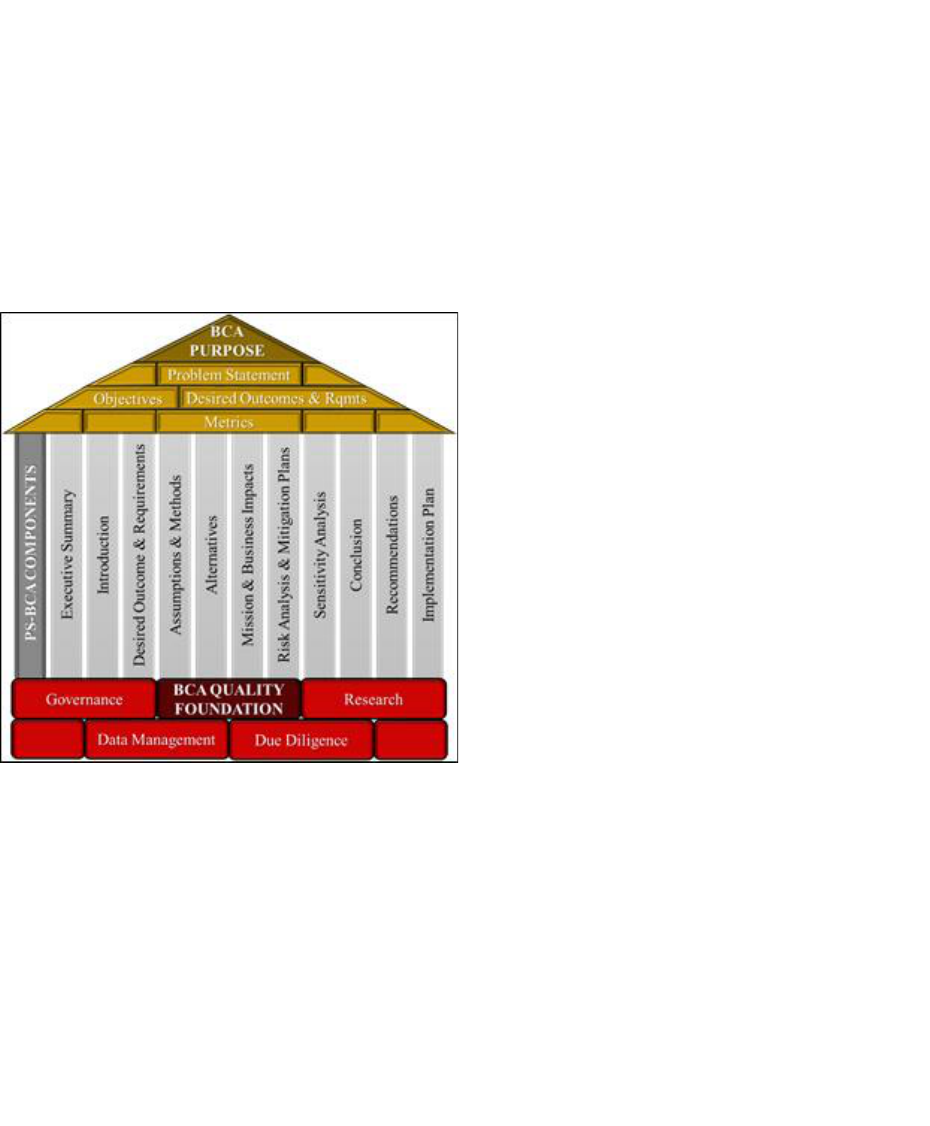
DAFPAM63-123 14 APRIL 2022 9
1.3.4.2. Process Components. Subsections of the PS-BCA that directly execute and report
on analytical actions. PSMs should refer to the DoD PS-BCA Guidebook and must follow
guidance in AFMAN 65-506 to determine what to include in the components section. Of
particular note, within the implementation plan, a PS-BCA should include predetermined
off-ramps. These off-ramps are actions to be taken when the desired objectives are not
being achieved for the selected COA.
1.3.4.3. Quality Foundation. Directly affects the quality and completeness of the analysis.
This section consists of research, due diligence (verifying the accuracy of the information),
governance (provides oversight), documentation, and data management.
Figure 1.1. Product Support BCA Elements.
1.3.5. Integrated Product Support (IPS) Elements. The PS-BCA is used to analyze a program’s
PSS and are represented by the 12 IPS elements, as identified in Appendix A of the DoD
Product Support Manager Guidebook. Each program is unique and the IPS elements to be
analyzed are dependent upon the specific sustainment requirements of the weapon system.
Rationale should be provided for each of the 12 IPS elements whether utilized or not within
the PS-BCA. The IPS elements categorize major support areas and provide standardized
definitions. One recommended approach in addressing the 12 IPS elements is shown in Figure
1.2 The 12 IPS elements are 1) Product Support Management; 2) Design Interface; 3)
Sustaining Engineering (SE); 4) Supply Support; 5) Maintenance Planning and Management;
6) Packaging, Handling; Storage & Transportation; 7) Technical Data; 8) Support Equipment;
9) Training and Training Support; 10) Manpower and Personnel; 11) Facilities and
Infrastructure; and 12) Computer Resources. Of the 12 IPS elements, those most often
compared between COAs within a PS-BCA are the following:
1.3.5.1. Product Support Management. Focuses on integrating all sources of product
support, public and private, within the scope of a product support arrangement.
1.3.5.2. Sustaining Engineering. Examines the technical tasks (i.e., engineering and
logistics investigations and analysis) required to ensure continued operation and
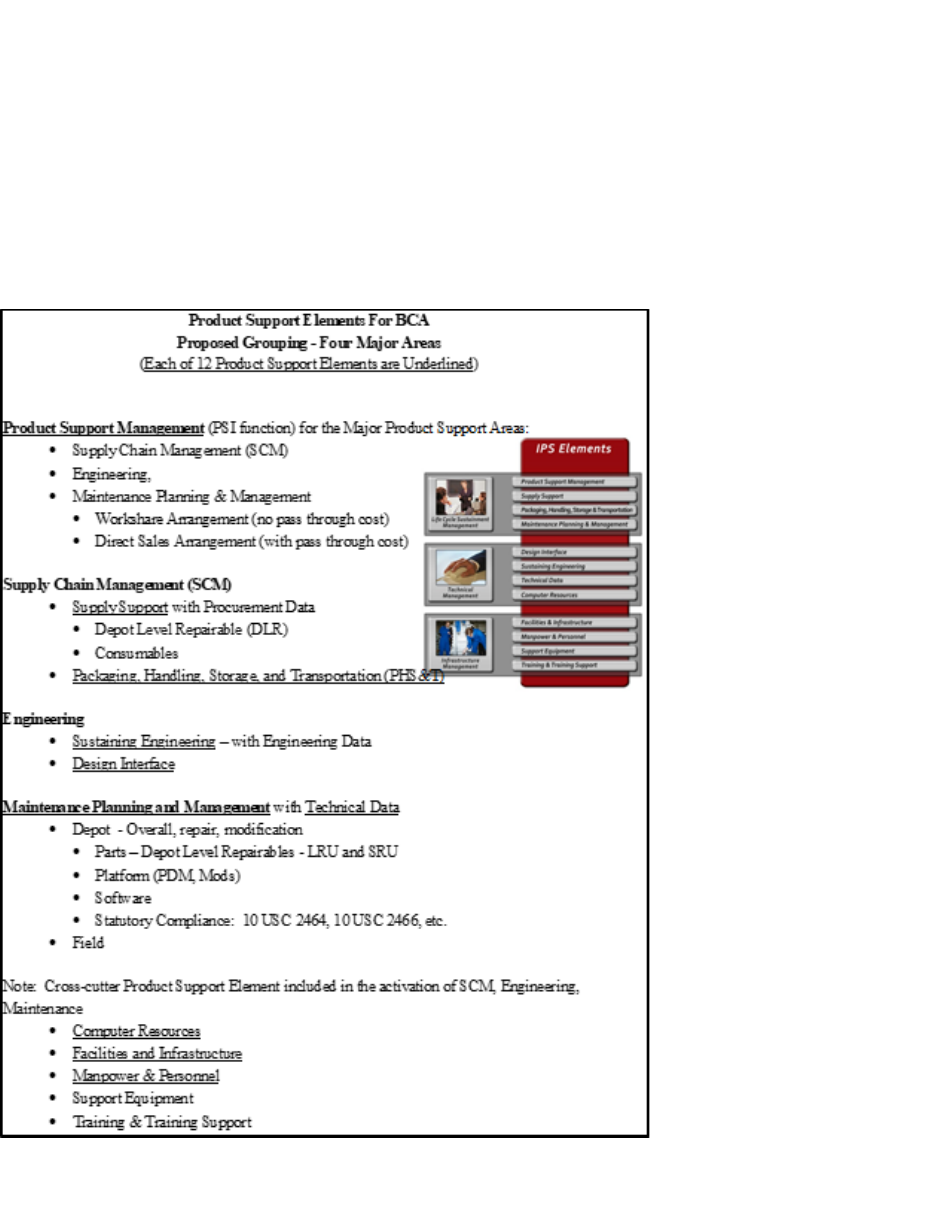
10 DAFPAM63-123 14 APRIL 2022
maintenance of a system. See AFI 63-101/20-101, Chapter 5, “Systems Engineering,” for
guidance on the engineering requirements that PMs will address to ensure the continued
operation and maintenance of a system.
1.3.5.3. Supply Support. Focuses on procuring, producing, and delivering products and
services to customers as well as the flow of funds.
1.3.5.4. Maintenance Planning and Management. Focuses on the maintenance of parts,
assemblies, sub-assemblies, and end items. This might include manufacturing parts,
making modifications, testing, and reclamation, as needed.
Figure 1.2. Four Major Areas for 12 IPS Elements.
1.3.5.5. The PS-BCA should follow the cost estimating guidance outlined in the DoD
“Cost Assessment and Program Evaluation (CAPE) Operating and Support Cost
Estimating Guide 2014” and be structured according to the IPS elements and the CAPE
Cost elements.

DAFPAM63-123 14 APRIL 2022 11
1.3.5.5.1. Best Practice. The Program Management Office (PMO) should also plan to
acquire government data rights and delivery of technical data as required by 10 USC
§2320, Rights in Technical Data. Prior to Milestone (MS)-B, the PMO should develop
a PS-BCA data collection plan that identifies the data requirements and data system
access requirements for the analysis. Information such as demand history for supply
chain (which parts are replaced or repaired and how often), maintenance repair
procedures/process, and product support performance metrics (e.g., Customer Wait
Time (CWT), engineering request response time) are types of information that can be
captured. In addition, cost reporting and priced bill of materials with the appropriate
amount of fidelity should be obtained if available.
1.4. When to Conduct a PS-BCA. The PS-BCA is a statutory requirement for all major weapon
systems based on 10 USC §2337, Life-Cycle Management and Product Support. Air Force
Instruction (AFI) 63-101/20-101 further identifies PS-BCA requirements as mandatory for
Acquisition Category (ACAT) I and ACAT II programs and at the discretion of the Milestone
Decision Authority (MDA) for ACAT III programs.
1.4.1. MDA Discretion. For existing platforms/systems, the MDA also has the discretion to
initiate a PS-BCA. All modification programs that are classified as ACAT I or ACAT II
programs also require a PS-BCA. PS-BCAs for modifications to ACAT III programs are at
the discretion of the MDA. However, once modifications are in the sustainment phase,
consolidate the modification PS-BCA into the system/platform level PS-BCA. The PS-BCA
should begin as early as pre-MS-A or initial entry into the acquisition life cycle.
1.4.2. Objectives and Approach. PS-BCA objectives and approach are determined by the point
at which they are accomplished within the program’s life cycle.
1.4.2.1. Prior to MS-A and MS-B. Department of Defense Instruction (DoDI) 5000.02
states a BCA will be included as an annex to the LCSP. While there are challenges to
completing a BCA early in the acquisition life cycle due to the lack of data and system
information available, DoDI 5000.02 directs a BCA to be accomplished in support of the
MS-A decision. This BCA includes “the assumptions, constraints, and analysis used to
develop the product support strategy documented in the LCSP.” This comprises the BCA
scope and methodology, laying the groundwork for product support management and
integration, supply chain management, and maintenance planning. Defining these areas
early provides the framework to assess options for potential future COAs and solidifies the
methodology for conducting the PS-BCA. PS-BCAs prior to MS-A and B may be limited
in depth and detail when compared to a PS-BCA at MS-C and later.
1.4.2.2. Between MS-B and MS-C. A PS-BCA that fully examines the system’s PSS
should be completed prior to MS-C using a best value approach for PSS development that
addresses each IPS element. A “revalidation” of previous PS-BCAs is statutorily required
if five years or more will span between milestones. The revalidation should confirm the
strategy is progressing and update the data and analytical results.
1.4.2.3. Post MS-C. A PS-BCA requires revalidating/updating prior to any proposed
change in the PSS or at a minimum every five years. Follow the decision tree in section
1.3.1 to determine if a program should accomplish a PS-BCA if a PS-BCA has not been
accomplished previously. The same level of analysis may not be required in all cases for
a Post MS-C PS-BCA. If the situation allows, a PS-BCA may only require “revalidation”
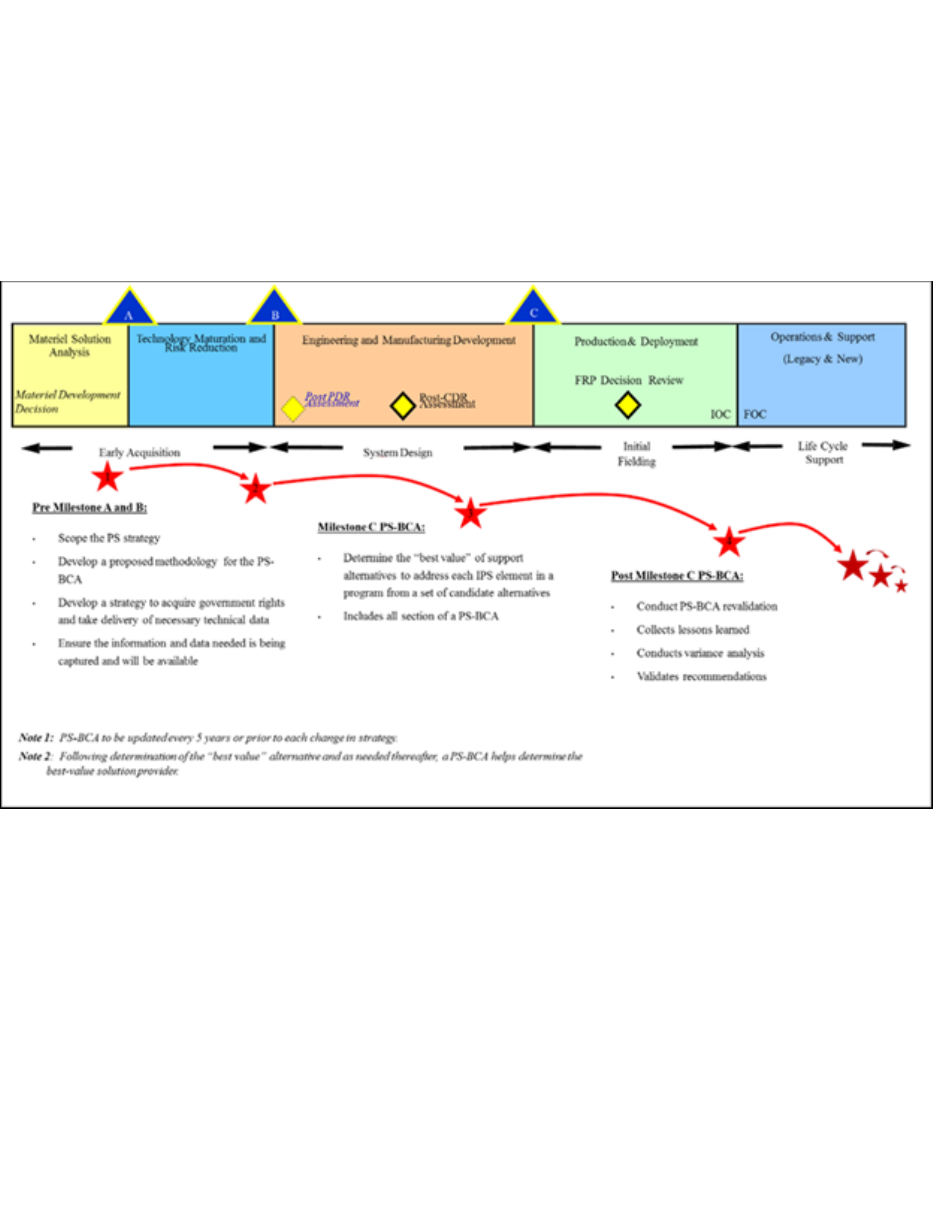
12 DAFPAM63-123 14 APRIL 2022
of the previous analysis, by confirming the strategy is progressing and updating the data
and analytical results. Note: Programs that are post MS-C prior to the enactment of 10
USC §2337, Life-Cycle Management and Product Support, did not have the legislated
requirement to develop a PS-BCA prior to
MS- C. As a result, they are not required to perform a PS-BCA as part of their 5-year
revalidation. A PS-BCA is still required when determining a change to the PSS.
1.4.2.4. The level of detail in a PS-BCA differs according to where the program is in the
life cycle, as shown in Figure 1.3:
Figure 1.3. PS-BCA Schedule Throughout the Life Cycle.
1.4.2.5. Given the product support COAs may evolve as the life cycle progresses, there is
no standard set of support COAs for a PS-BCA. Best value product support approach may
include some mix of organic (e.g., government) and contractor support, as well as Public-
Private Partnerships (PPP). DoD Public-Private Partnering (PPP) for Product Support
Guidebook provides greater fidelity on PPP. The potential COAs should materialize
through the execution of the PS-BCA process. The merits of various sourcing and
partnering options should be identified as system support capabilities are analyzed across
the IPS elements and various support COAs are weighted against desired support
requirements and objectives.
1.4.2.6. The PS-BCA decision tree in section 1.4.3.1 is designed to assist the PSM in
determining what actions are required with respect to either developing a PS-BCA or
revalidating/updating the previously completed PS-BCA. At each step within the process
the narrative addresses the requirements and expected objectives. Revalidating/updating
the PS-BCA does not mean completely redoing the PS-BCA every five years. As the PSM
works through each step, the decision tree process assists in determining the requirements
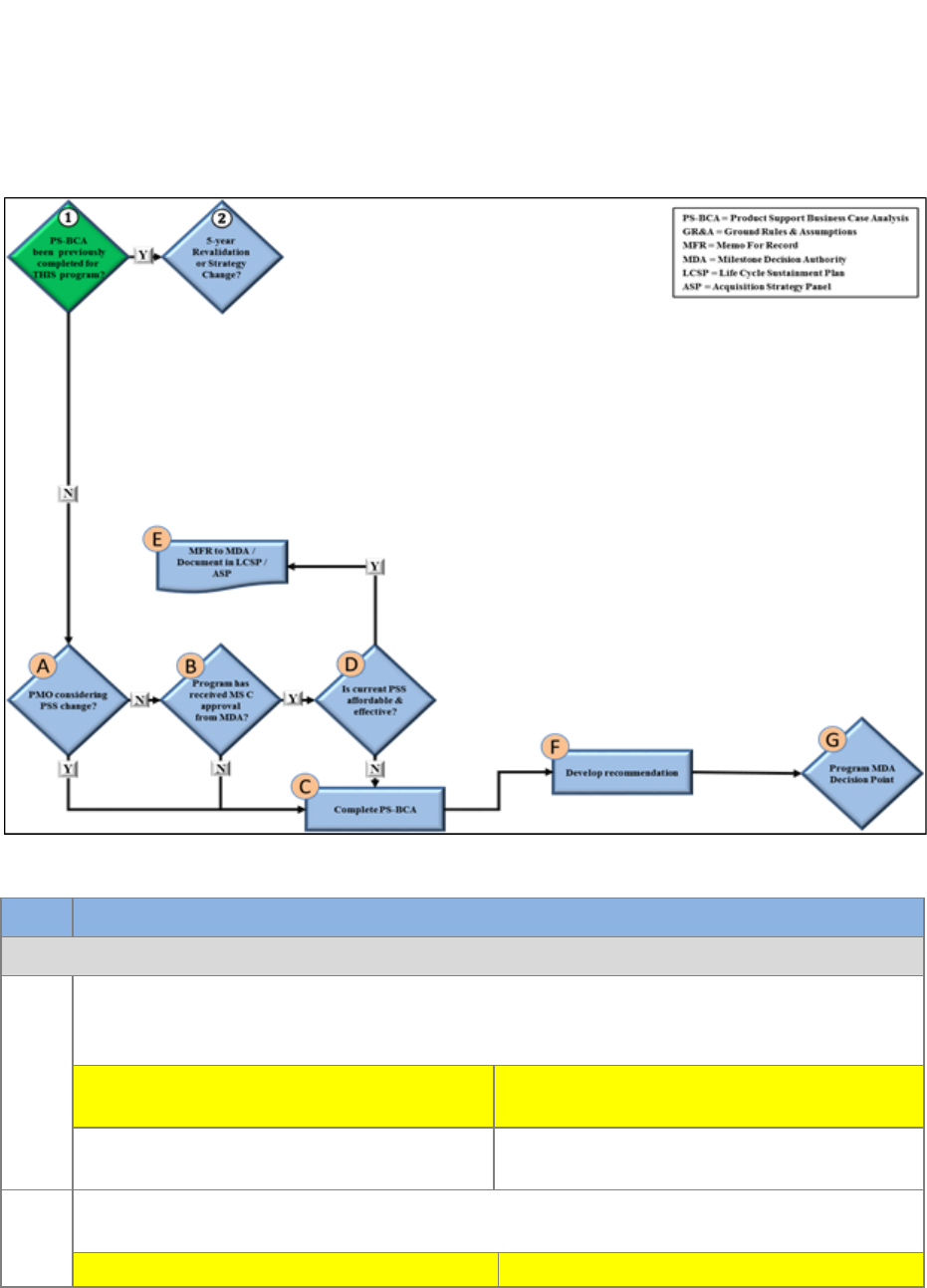
DAFPAM63-123 14 APRIL 2022 13
(i.e., Memorandum for Record (MFR) to document findings or update previous PS-BCA)
and outputs.
1.4.3. PS-BCA Decision Tree
1.4.3.1. Step 1: PS-BCA been previously completed for THIS program?
Figure 1.4. Step #1 of the PS-BCA Decision Tree.
Table 1.1. Step #1 Decision Tree Process Flow.
Step
What Happens
❶ PS-BCA BEEN PREVISOULY COMPLETED FOR THIS PROGRAM?
Establish if a PS-BCA was previously completed. If a PS-BCA was completed,
consider this effort an update. Utilize the previously completed PS-BCA as the
starting point.
If Yes (Previous PS-BCA completed)
If No (No previous PS-BCA)
Continue to “Step (2) 5-year
Revalidation or Strategy Change”
Continue to “(A) PMO Considering PSS
Change”
A
Determine if the PMO is considering a change to the existing Product Support
Strategy
If Yes (Change to PSS Change)
If No (No change to PSS)

14 DAFPAM63-123 14 APRIL 2022
Step
What Happens
Continue to “(C) Complete PS-BCA
Continue to “(B) Program has received
MS-C approval from MDA?
B
Determine if program has received MS-C approval?
If Yes (Program has received MS-C from
MDA?)
If No (Program does not have MS-C
approval from MDA)
Continue to “(D) Is current PSS
affordable & effective?
Continue to “(C) Complete PS-BCA
C
Complete PS-BCA
Complete a PS-BCA in accordance with the following guidance:
AF PS-BCA Pamphlet
AFI 65-501
AFMAN 65-610
DoD PS-BCA Guidebook
Continue to Activity (F)
D
Establish if current PSS is within expected costs and metrics are achieving warfighter
requirements.
If Yes (PSS achieving goals)
If No (PSS not achieving goals)
Continue to “(E) MFR to MDA /
Document in LCSP”
Return to Activity “(C) and complete PS-
BCA”
E
MFR to MDA / Document in LCSP
Prepare a memo for the record that documents the results of the analysis performed.
Memo for record includes rationale for the assessment of affordability and
effectiveness of the program. This documentation should be included in an annex
within the LCSP. MDA documentation and updates should be annexed within LCSP.
Attachment 2 provides a sample Legacy Program PS-BCA Sufficiency Memo.
Process ends after this step.
F
Develop Recommendation
Summarize the findings in a clear and concise manner that explains the recommended
solution and why it is recommended. Make reference to the other COAs and how
they compare to the recommended COA in costs, benefits, and risks. The
recommendation should be specific, comprehensive, measurable, consistent, accurate,
timely, unbiased, and achievable.
Continue to activity (G)
G
Program MDA Decision Point
Present the recommendation to the MDA for approval. The MDA should document
the rationale for the PS-BCA final decision. This final decision documentation serves
as an archive, and combined with the PS-BCA, provides the baseline for the next
iteration of the PS-BCA. The MDA decision provides closure to the process and
initiates the transition to the selected PSS. MDA documentation (MFR to MDA) and
updates should be annexed within LCSP.
Process ends after this step.
1.4.3.2. Step 2: 5-year Revalidation or Strategy Change
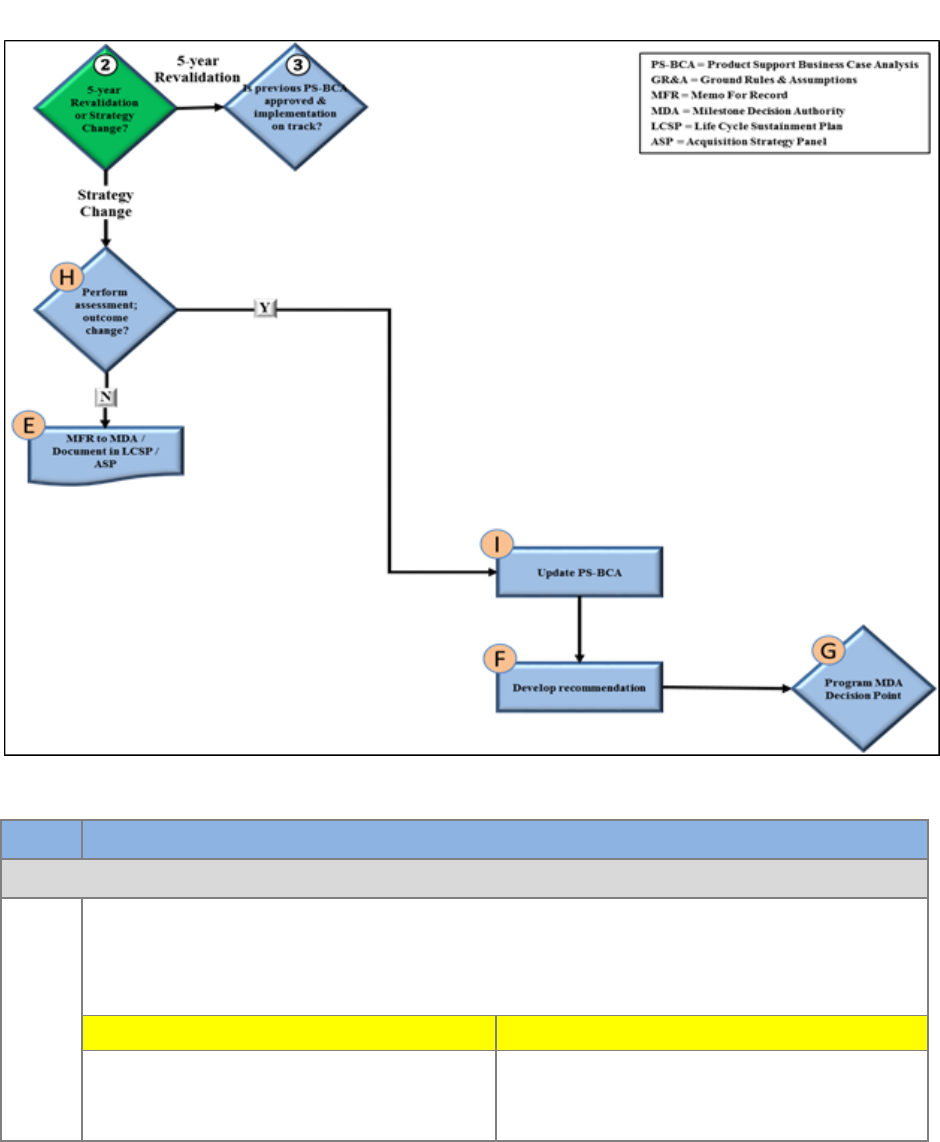
DAFPAM63-123 14 APRIL 2022 15
Figure 1.5. Step #2 of the PS-BCA Decision Tree.
Table 1.2. Step #2 Decision Tree Process Flow.
Step
What Happens
❷ 5-YEAR REVALIDATION or STRATEGY CHANGE?
If a PS-BCA was completed previously, determine the reason for updating the PS-
BCA. There are generally two reasons to update a PS-BCA: 1) five years have
lapsed since the most recent PS-BCA was accomplished or 2) there is a change in the
PSS.
If 5-Year Revalidation
If a Strategy Change
Continue to “Step 3) Is previous PS-
BCA approved & implementation on
track?”
Continue to “(H) Perform assessment;
outcome change?”

16 DAFPAM63-123 14 APRIL 2022
H
Perform assessment; outcome change?
Determine how changing the PSS impacts the previous PS-BCA, by determining
what changed and then assess how the changes impact costs, benefits, and risks.
Next, assess if the changes would lead to a different recommendation. This can be
done in a variety of ways, one of which is to determine how much the previous
results would have to change in order for the recommendation to change. Then
determine if the current changes fall within those bounds. This is equivalent to
performing a sensitivity analysis on the prior PS-BCA.
If Yes (Change in outcome)
If No (No change in outcome)
Continue to “(I) Update Previous PS-
BCA”
Continue to “(E) MFR to MDA /
Document in LCSP”
I
Update Previous PS-BCA
Update the previous PS-BCA using the most current data available. Since the
outcome has changed, this should require reviewing all areas within the PS-BCA
(i.e., costs, benefits, and risks). Incorporate any new information (e.g., extension of
the service life since the last PS-BCA) that has come available since the previous PS-
BCA was completed and update ground rules and assumptions as appropriate.
Continue to activity (F)
F
Develop Recommendation
Summarize the findings in a clear and concise manner that explains the
recommended solution and why it is recommended. Make reference to the other
COAs and how they compare to the recommended COA in costs, benefits, and risks.
The recommendation should be specific, comprehensive, measurable, consistent,
accurate, timely, unbiased, and achievable.
Continue to activity (G)
G
Program MDA Decision Point
Present the recommendation to the MDA for approval. The MDA should document
the rationale for the PS-BCA final decision. This final decision documentation
serves as an archive, and combined with the PS-BCA, provides the baseline for the
next iteration of the PS-BCA. The MDA decision provides closure to the process
and initiates the transition to the selected PSS. MDA documentation (MFR to MDA)
and updates should be annexed within LCSP.
Process ends after this step.
E
MFR to MDA / Document in LCSP
Prepare a memo for the record that documents the results of the analysis performed.
Memo for record includes rationale for the assessment of affordability and
effectiveness of the program. This documentation should be included in an annex
within the LCSP. MDA documentation and updates should be annexed within LCSP.
Attachment 2 provides a sample Legacy Program PS-BCA Sufficiency Memo.
Process ends after this step.
1.4.3.3. Step 3: Was the Recommendation Implemented?
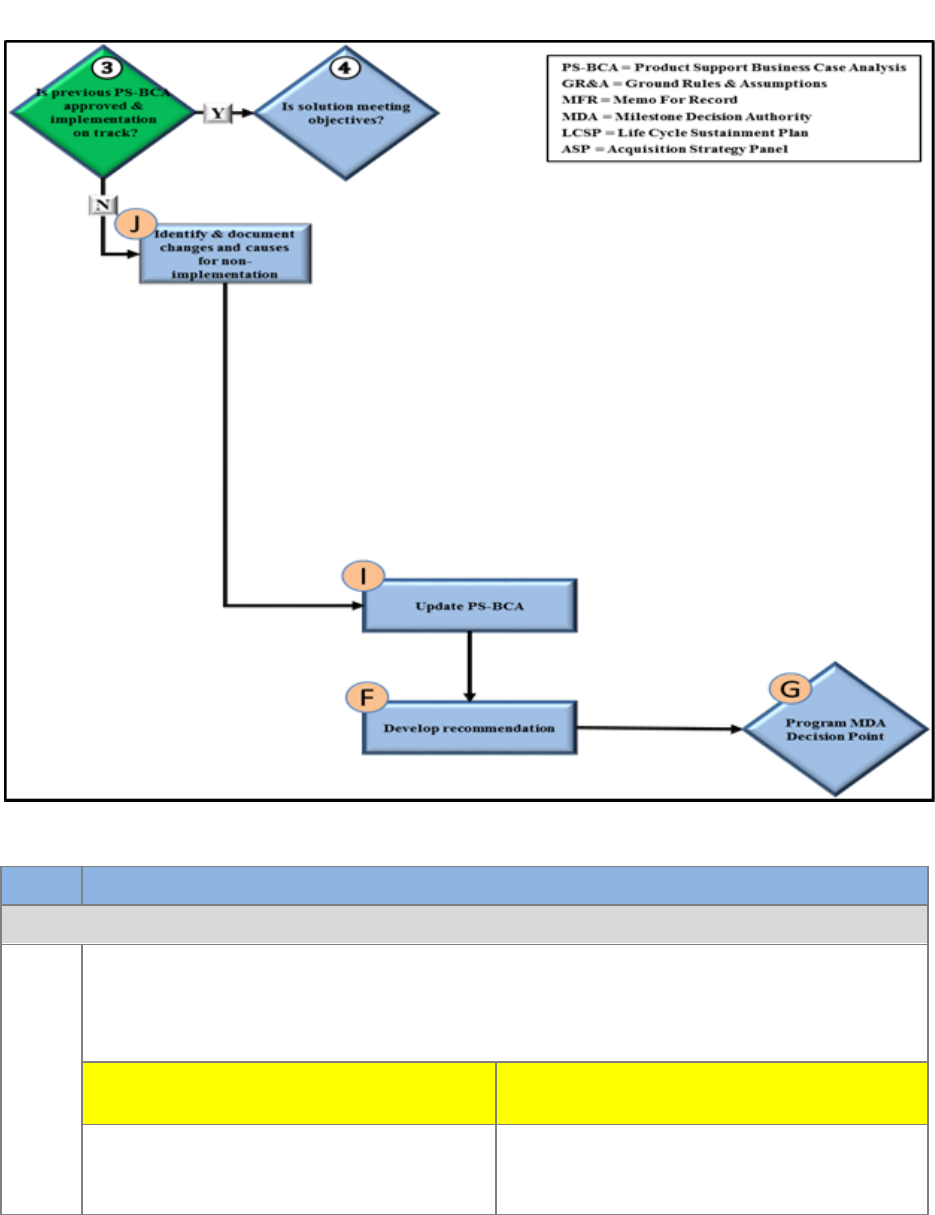
DAFPAM63-123 14 APRIL 2022 17
Figure 1.6. Step #3 of the PS-BCA Decision Tree.
Table 1.3. Step #3 Decision Tree Process Flow.
Step
What Happens
❸ WAS THE RECOMMENDTION IMPLEMENTED?
If five years has passed since the latest PS-BCA was completed, an update is
required. Updating the PS-BCA does not mean the PS-BCA should be completely
redone. Decide first if the PS-BCA recommendation was implemented or is being
implemented.
If Yes (Recommendation was
implemented)
If No (Recommendation not
implemented)
Continue to “Step 4) Is the Solution
Meeting Program Objectives?”
Continue to “(J) Identify & document
changes and causes for non-
implementation”

18 DAFPAM63-123 14 APRIL 2022
Step
What Happens
J
Identify & document changes and causes for non-implementation
Assess and document the reasons why the recommendation was not implemented.
Those reasons could include lack of funding, changes in the political environment,
programmatic changes, inability to obtain required technical data, etc. If the
implementation date slipped, update the implementation plan accordingly and
document the reason for the slippage. Once the reason for non-implementation is
identified and documented, an assessment should be performed to determine if the
recommendation is still valid. If the recommendation is no longer valid, update the
previous PS-BCA in order to determine the appropriate PSS based on current ground
rules, assumptions, program environment and current data.
Continue to activity (I)
I
Update Previous PS-BCA
Update the previous PS-BCA using the most current data available. Since the
outcome has changed, this should require reviewing all areas within the PS-BCA
(i.e., costs, benefits, and risks). Incorporate any new information (e.g., extension of
the service life since the last PS-BCA) that has come available since the previous PS-
BCA was completed and update ground rules and assumptions as appropriate.
Continue to activity (F)
F
Develop Recommendation
Summarize the findings in a clear and concise manner that explains the
recommended solution and why it is recommended. Make reference to the other
COAs and how they compare to the recommended COA in costs, benefits, and risks.
The recommendation should be specific, comprehensive, measurable, consistent,
accurate, timely, unbiased, and achievable.
Continue to activity (G)
G
Program MDA Decision Point
Present the recommendation to the MDA for approval. The MDA should document
the rationale for the PS-BCA final decision. This final decision documentation
serves as an archive, and combined with the PS-BCA, provides the baseline for the
next iteration of the PS-BCA. The MDA decision provides closure to the process
and initiates the transition to the selected PSS. MDA documentation (MFR to MDA)
and updates should be annexed within LCSP.
Process ends after this step.
1.4.3.4. Step 4: Is the Solution Meeting Program Objectives?
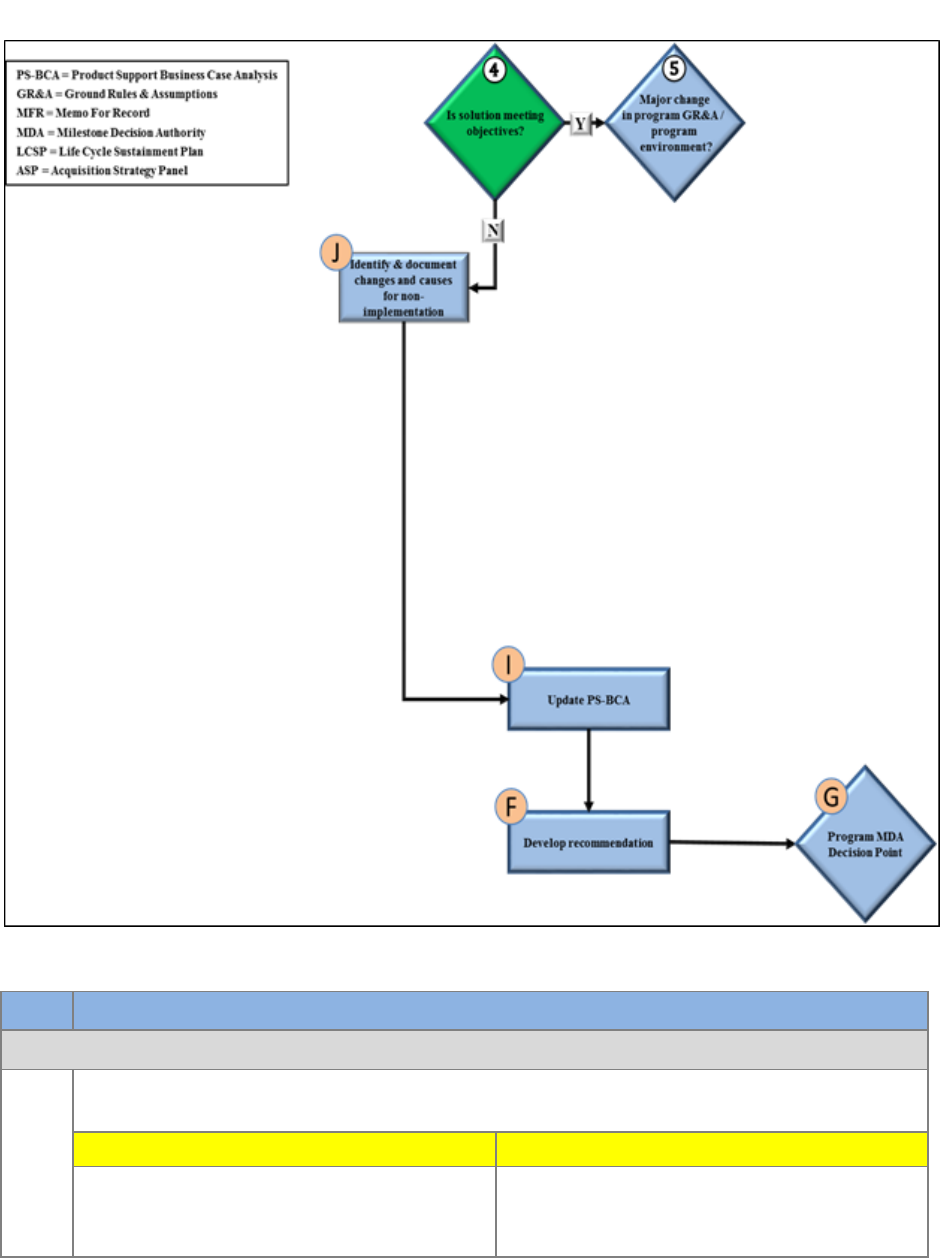
DAFPAM63-123 14 APRIL 2022 19
Figure 1.7. Step #4 of the PS-BCA Decision Tree.
Table 1.4. Step #4 Decision Tree Process Flow.
Step
What Happens
❹ IS SOLUTION MEETING OBJECTIVE?
Assuming the recommendation was implemented, determine if the solution is meeting
the objectives as stated in the PS-BCA.
If Yes (Solution is meeting objective)
If No (Solution is not meeting objective)
Continue to “Step 5) Major Change in
Program Ground Rules and Assumptions
(GR&A) or Program Environment?”
Continue to “(J) Identify & document
changes and causes for non-performance”

20 DAFPAM63-123 14 APRIL 2022
Step
What Happens
J
Identify & document changes and causes for non-performance
Identify and document the reasons why the solution is not meeting the objectives set
forth in the PS-BCA. An example could be that a single work stream is not
performing as projected (e.g., maintenance organizations not meeting flow days,
supply organizations inability to fill customer requisitions in a timely manner or cost
increases have caused budgetary impacts to the program).
Continue to Activity (I)
I
Update Previous PS-BCA
Update the previous PS-BCA using the most current data available. Since the
outcome has changed, this should require reviewing all areas within the PS-BCA (i.e.,
costs, benefits, and risks). Incorporate any new information (e.g., extension of the
service life since the last PS-BCA) that has come available since the previous PS-
BCA was completed and update ground rules and assumptions as appropriate.
Continue to activity (F)
F
Develop Recommendation
Summarize the findings in a clear and concise manner that explains the recommended
solution and why it is recommended. Make reference to the other COAs and how
they compare to the recommended COA in costs, benefits, and risks. The
recommendation should be specific, comprehensive, measurable, consistent, accurate,
timely, unbiased, and achievable.
Continue to activity (G)
G
Program MDA Decision Point
Present the recommendation to the MDA for approval. The MDA should document
the rationale for the PS-BCA final decision. This final decision documentation serves
as an archive, and combined with the PS-BCA, provides the baseline for the next
iteration of the PS-BCA. The MDA decision provides closure to the process and
initiates the transition to the selected PSS. MDA documentation (MFR to MDA) and
updates should be annexed within LCSP.
Process ends after this step.
1.4.3.5. Step 5: Major Change in Program GR&A or Program Environment?
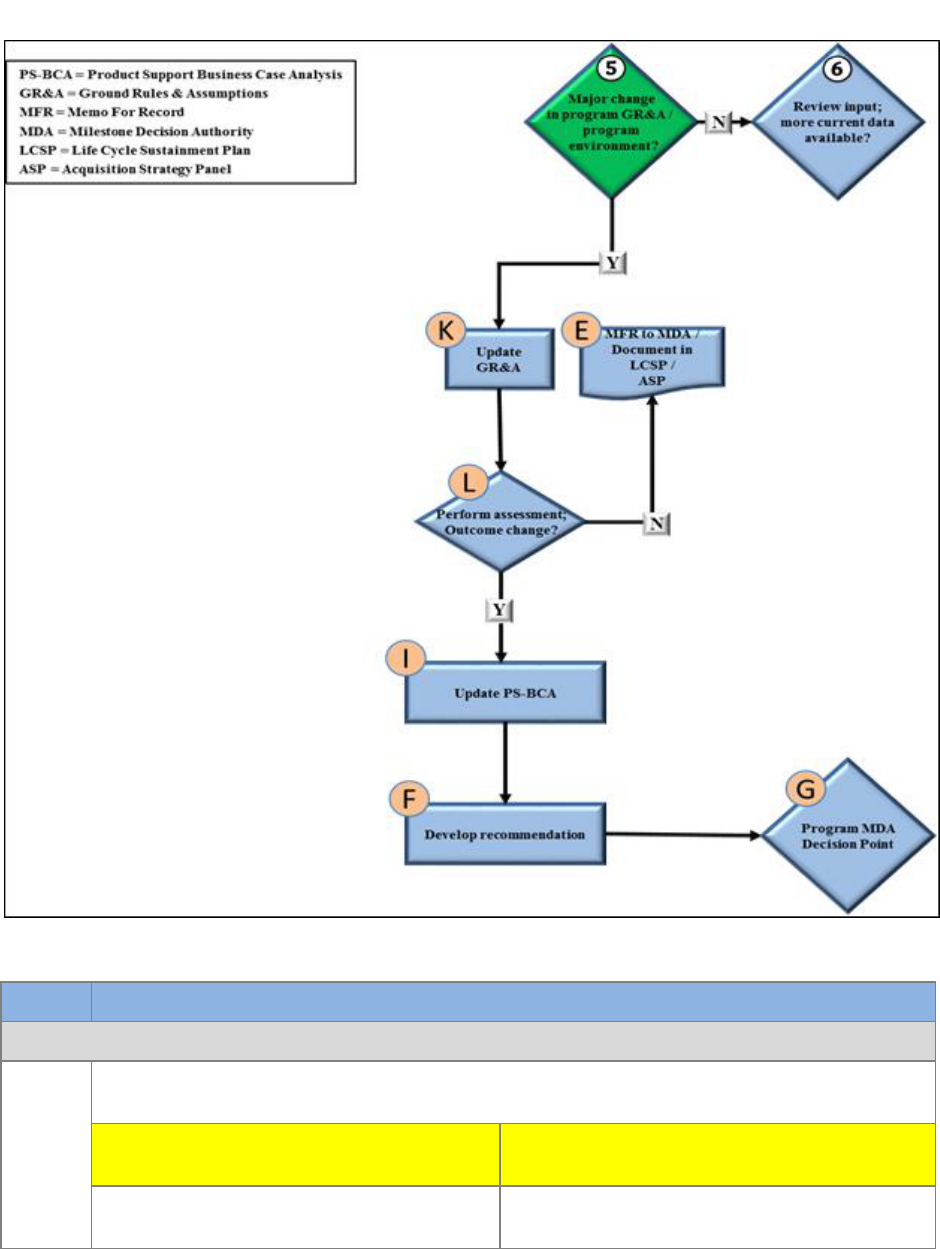
DAFPAM63-123 14 APRIL 2022 21
Figure 1.8. Step #5 of the PS-BCA Decision Tree.
Table 1.5. Step #5 Decision Tree Process Flow.
Step
What Happens
❺ MAJOR CHANGE IN PROGRAM GR&A / PROGRAM ENVIRONMENT?
Assuming the solution is meeting the objective, assess if the PS-BCA GR&As and/or
operating environment have changed.
If Yes (GR&A or environment
changed)
If No (GR&A or environment not
changed)
Continue to “(K) Update GR&A”
Continue to “Step 6) Review Input; More
Current Data Available?”

22 DAFPAM63-123 14 APRIL 2022
Step
What Happens
❺ MAJOR CHANGE IN PROGRAM GR&A / PROGRAM ENVIRONMENT?
K
Update GR&A
To determine how changes in the GR&A and/or program environment impact the
PS-BCA, review the existing PS-BCA GR&A. The Integrated Project Team (IPT)
should document any changes to the GR&A and/or program environment. If new
information is available that would drive additional GR&As that were not previously
captured, those would be included in the update.
Continue to activity (L)
L
Perform assessment; outcome change?
Identify if and how those changes/additions in the GR&A and/or program
environment affect costs, benefits, and risks. Determine if the recommendation
would change based on the updated information. There are several methods that can
be used, however, the method used and results should be documented. No one
method is prescribed, but the method and logic used should be thoroughly
documented to the degree that it is repeatable.
If Yes (Change in outcome)
If No (No change in outcome)
Continue to “(I) Update PS-BCA”
Continue to “(E) MFR to MDA”
I
Update Previous PS-BCA
Update the PS-BCA to reflect the revised GR&A and/or program environment.
Update the previous PS-BCA using the most current data available. Since the
outcome has changed, this should require reviewing all areas within the PS-BCA
(i.e., costs, benefits, and risks). Incorporate any new information (e.g., extension of
the service life since the last PS-BCA) that has come available since the previous PS-
BCA was completed and update ground rules and assumptions as appropriate.
Continue to activity (F)
F
Develop Recommendation
Summarize the findings in a clear and concise manner that explains the
recommended solution and why it is recommended. Make reference to the other
COAs and how they compare to the recommended COA in costs, benefits, and risks.
The recommendation should be specific, comprehensive, measurable, consistent,
accurate, timely, unbiased, and achievable.
Continue to activity (G)
G
Program MDA Decision Point
Present the recommendation to the MDA for approval. The MDA should document
the rationale for the PS-BCA final decision. This final decision documentation
serves as an archive, and combined with the PS-BCA, provides the baseline for the
next iteration of the PS-BCA. The MDA decision provides closure to the process
and initiates the transition to the selected PSS. MDA documentation (MFR to MDA)
and updates should be annexed within LCSP.
Process ends after this step.
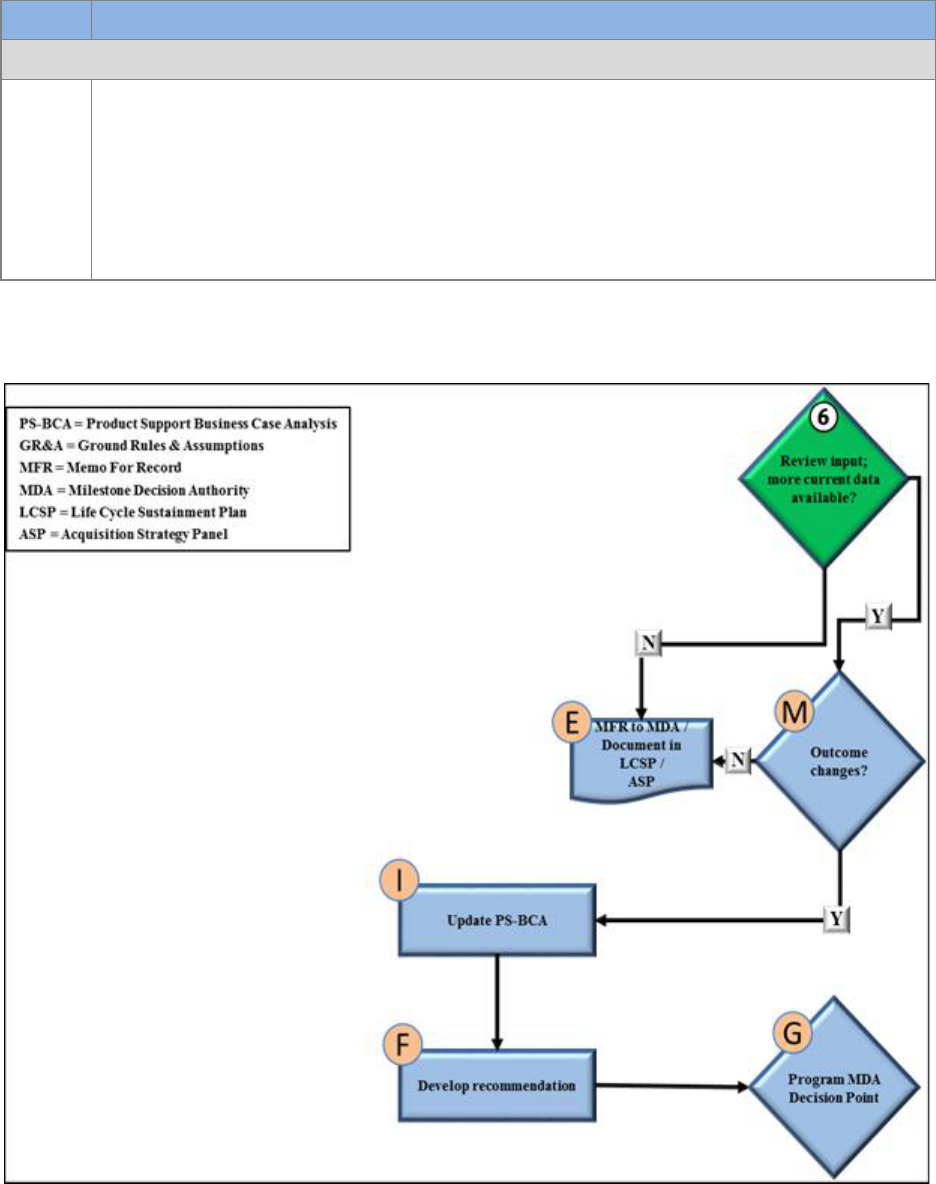
DAFPAM63-123 14 APRIL 2022 23
Step
What Happens
❺ MAJOR CHANGE IN PROGRAM GR&A / PROGRAM ENVIRONMENT?
E
MFR to MDA / Document in LCSP
Prepare a memo for the record that documents the results of the analysis performed.
Memo for record includes rationale for the assessment of affordability and
effectiveness of the program. This documentation should be included in an annex
within the LCSP. MDA documentation and updates should be annexed within LCSP.
Attachment 2 provides a sample Legacy Program PS-BCA Sufficiency Memo.
Process ends after this step.
1.4.3.6. Step 6: Review Input; More Current Data Available?
Figure 1.9. Step #6 of the PS-BCA Decision Tree.

24 DAFPAM63-123 14 APRIL 2022
Table 1.6. Step #6 Decision Tree Process Flow.
Step
What Happens
❻ REVIEW INPUT; MORE CURRENT DATA AVAILABLE?
Assuming there are no major changes in program GR&A and/or program
environment, review the data used within the PS-BCA and update to reflect the most
current data available.
If Yes (More current data available)
If No (Data is current)
Continue to “(M) Outcome changes?”
Continue to “(E) MFR to MDA”
M
Outcome changes?
Identify if and how the more current data will affect costs, benefits, and risks.
Determine if the recommendation would change based on the updated information.
There are several methods that can be used, however, the method used and results
should be documented. No one method is prescribed but the method and logic used
will be thoroughly documented to the degree that it is repeatable.
If Yes (Change in outcome)
If No (No change in outcome)
Continue to “(I) Update PS-BCA”
Continue to “(E) MFR to MDA”
I
Update PS-BCA
Update the PS-BCA using the most current data available. As the system progresses
through the life cycle, additional data will become available. If the previous PS-
BCA was based predominately on analogous systems, the update should replace
analogous data with actual data. Since the outcome has changed, this should require
reviewing all areas within the PS-BCA (i.e., costs, benefits, and risks). Incorporate
any new information (e.g., extension of the service life since the last PS-BCA) that
has come available since the previous PS-BCA was completed and update ground
rules and assumptions as appropriate.
Continue to activity (F)
F
Develop Recommendation
Summarize the findings in a clear and concise manner that explains the
recommended solution and why it is recommended. Make reference to the other
COAs and how they compare to the recommended COA in costs, benefits, and risks.
The recommendation should be specific, comprehensive, measurable, consistent,
accurate, timely, unbiased, and achievable.
Continue to activity (G)
G
Program MDA Decision Point
Present the recommendation to the MDA for approval. The MDA should document
the rationale for the PS-BCA final decision. This final decision documentation
serves as an archive, and combined with the PS-BCA, provides the baseline for the
next iteration of the PS-BCA. The MDA decision provides closure to the process
and initiates the transition to the selected PSS. MDA documentation (MFR to MDA)
and updates should be annexed within LCSP.
Process ends after this step.
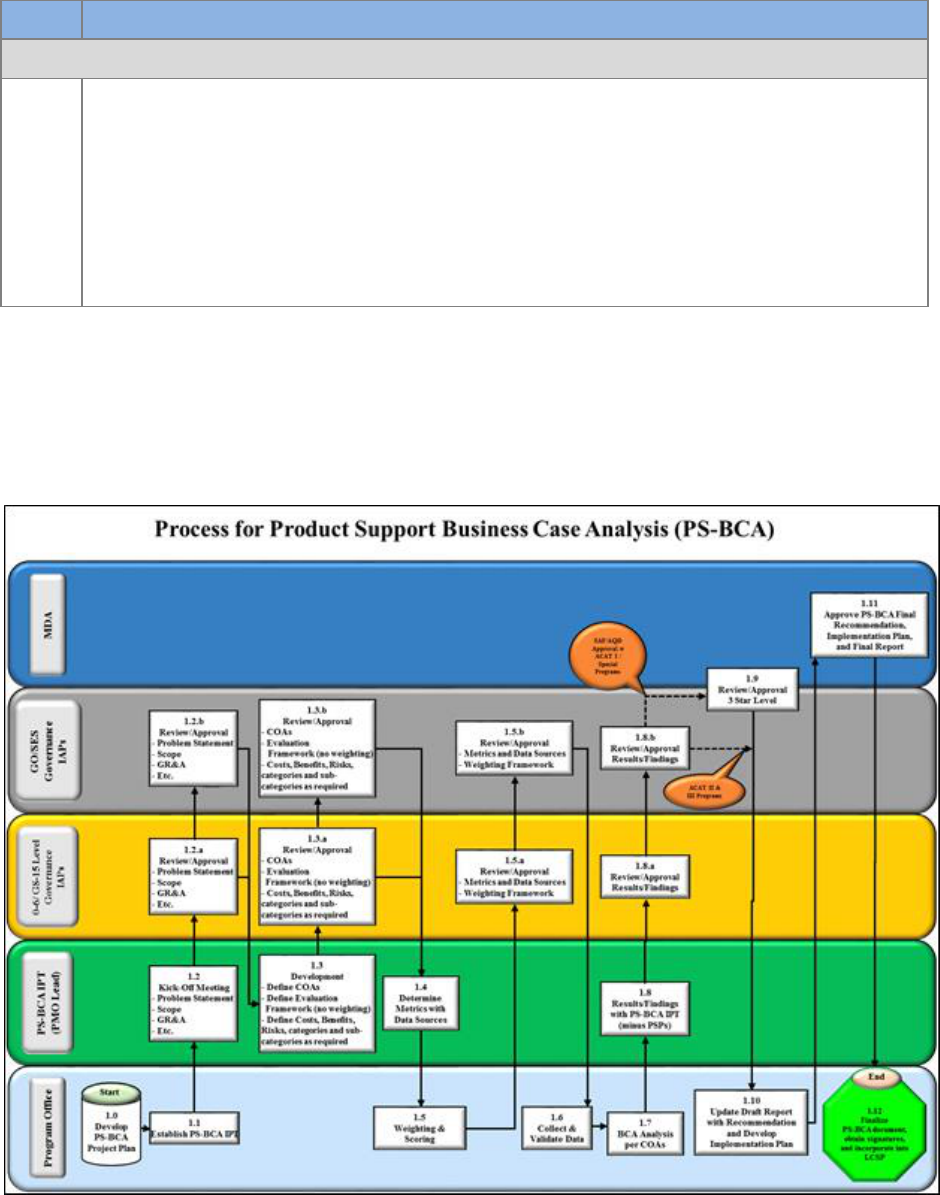
DAFPAM63-123 14 APRIL 2022 25
Step
What Happens
❻ REVIEW INPUT; MORE CURRENT DATA AVAILABLE?
E
MFR to MDA / Document in LCSP
Prepare a memo for the record that documents the results of the analysis performed.
This include rationale includes assessment of affordability and effectiveness of the
program. This documentation should be included in an annex within the LCSP.
MDA documentation and updates should be annexed within LCSP. Attachment 2
provides a sample Legacy Program PS-BCA Sufficiency Memo. Process ends after
this step.
Process ends after this step.
1.5. PS-BCA Process Overview.
1.5.1. PS-BCA Process Map. The PS-BCA process map shown in Figure 1.10 assists the
PMO in identifying the individual steps of the PS-BCA process. Greater fidelity of the PS-
BCA process is described in Attachment 3.
Figure 1.10. PS-BCA Process Map.

26 DAFPAM63-123 14 APRIL 2022
Chapter 2
ROLES AND RESPONSIBILITIES
2.1. PS-BCA IPT Members. Developing a PS-BCA represents a major effort that involves
comparing a variety of COAs in order to support major resource decisions in an effort to obtain
the best value for the product support strategy. Given the scope, scale, and complexity involved,
participation is required from a number of stakeholders (to include the warfighter), support subject
matter experts (SMEs), and advisors. The consolidated participants are led by the PSM and are
referred to as the PS-BCA IPT. The IPT should include major command/Field Command
(MAJCOM/FIELDCOM), Headquarters Air Force (HAF) and United States Space Force (USSF)
representatives. Additional information on the roles, responsibilities, and functions of the PS-
BCA IPT are located in paragraph 2.5.
2.2. Approval Level. The approver of the PS-BCA is the MDA. Depending on the scope and
sensitivity of the decision, the MDA can be the Under Secretary of Defense for Acquisition,
Technology and Logistics (USD (A&S)), Head of the DoD Service Component, Service
Acquisition Executive (SAE), or Program Executive Officer (PEO). Additionally, the MDA can
delegate the responsibility to make the PS-BCA final decision as outlined in section 2.3 and
maintain compliance with AFI 65-501 and AFMAN 65-506.
2.3. Milestone Decision Authority (MDA). The MDA has overall responsibility for the
acquisition program. The MDA has the authority to approve the entry of an acquisition program
into the next phase of the acquisition process and is accountable to authorities such as Congress
for costs, schedule, and performance. The MDA is based on ACAT levels as listed below:
ACAT ID and ACAT IAM: USD (A&S) or as delegated.
ACAT IC and ACAT IAC: Head of the DoD Service Component or, if delegated, the
SAE (not further delegable).
ACAT II: SAE or the individual designated by the SAE.
ACAT III: Designated by the SAE. This category includes Automated Information
System (AIS) programs that do not meet the criteria for MAIS programs.
2.3.1. Under Secretary of Defense for Acquisition, Technology and Logistics (USD (A&S)).
The USD (A&S) is responsible for supervising the Defense Acquisition System. The USD
(A&S) is the principal staff assistant and advisor to the Secretary of Defense and the Deputy
Secretary of Defense for all matters concerning acquisition.
2.3.2. United States Air Force Service Acquisition Executive (SAE). The USAF SAE, also
known as the Component Acquisition Executive (CAE), is responsible for all Air Force
research, development, and acquisition activities in accordance with DoDI 5000 series
directives. This executive provides direction, guidance, and supervision of all matters
pertaining to the formulation, review, approval and execution of acquisition plans, policies and
programs. The SAE can serve as the MDA on ACAT IC programs, if delegated, and
recommends decisions on ACAT ID programs. The SAE represents the Air Force to USD
(A&S) and Congress on all matters relating to acquisition policy and programs.
2.3.3. Program Executive Officer (PEO). The PEO is responsible for cost, schedule and
performance in an acquisition program and/or portfolio. Additionally, the PEO ensures PMs
are coordinating with appropriate stakeholders and representatives to develop capabilities

DAFPAM63-123 14 APRIL 2022 27
based requirements, technical level architectures, integrated test plans, technology transition
plans, product support strategies, and acquisition strategies throughout the entire life cycle.
The PEO validates the PMs’ recommendations and implementation plans. Validation answers
the question, “Is it the right solution to the problem?” A PEO is typically delegated as the
ACAT II and III MDA for programs in their portfolios. The PEO may delegate ACAT III
MDA authorities to any appropriately qualified individual(s). In addition, the PEO, or their
delegate, chairs the Executive Level Incremental Approval Point (IAP) sessions.
2.4. Governance Structure. For ACAT I (MDAP or MAIS) and selected Office of the Secretary
of Defense (OSD) programs, the coordination/approval structure depicted in Figure 2.1 below
should be followed during the development, review, and approval of the PS-BCA. The PMO is
responsible for identifying a coordination approval structure for the PS-BCA that is commensurate
with the ACAT level of the program. The PMO may leverage existing boards or steering groups
or utilize an existing MDA chain as final review and approval authority for the the PS-BCA. Prior
to the PS-BCA kick-off meeting, the PMO also identifies organizations (i.e., recommended
stakeholders) that should participate in the IAP steps to ensure enterprise level requirements are
addressed. In addition, IAP reviews should be leveraged to ensure “buy-in” throughout the PS-
BCA development process.
2.4.1. PS-BCA Engagement. The following section provides the PS-BCA team insight to
ensure a wide range of diverse perspectives prior to and in support of making major decisions.
The people and organizations representing this diversity are the foundation for governance,
validation, and approval type bodies. Figure 2.1 depicts the governance structure for
MDAP/MAIS ACAT I and special interest OSD programs. Figure 2.2 depicts the governance
structure for ACAT II & III programs.
2.4.1.1. DoD Policy: An acquisition program is categorized based on the criteria in DoDI
5000.02. All defense acquisition programs are designated by an ACAT (i.e., I through III)
and type (e.g., MDAP, MAIS, or Major System). Once an ACAT is established, it remains
throughout the lifecycle of the program. Once sub-programs are incorporated into system
level, all expenditures are included into the higher level system.
2.4.1.2. For ACAT I (MDAP or MAIS) and selected OSD programs, the governance
structures depicted in the Figure 2.1 should be utilized by the PMO during the
development, validation, and approval of the PS-BCA.
2.4.1.3. For ACAT II/III programs, the coordination/approval structure depicted in Figure
2.2 below should be followed during the development, review, and approval of the PS-
BCA.
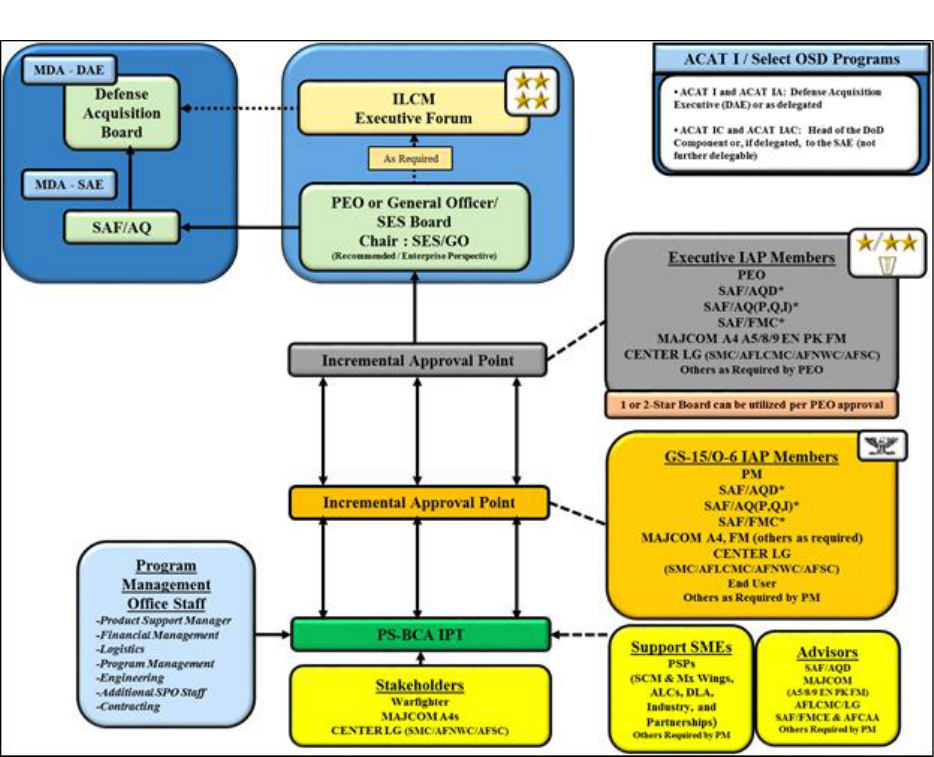
28 DAFPAM63-123 14 APRIL 2022
Figure 2.1. MDAP/MAIS ACAT I and Special Interest OSD Programs.
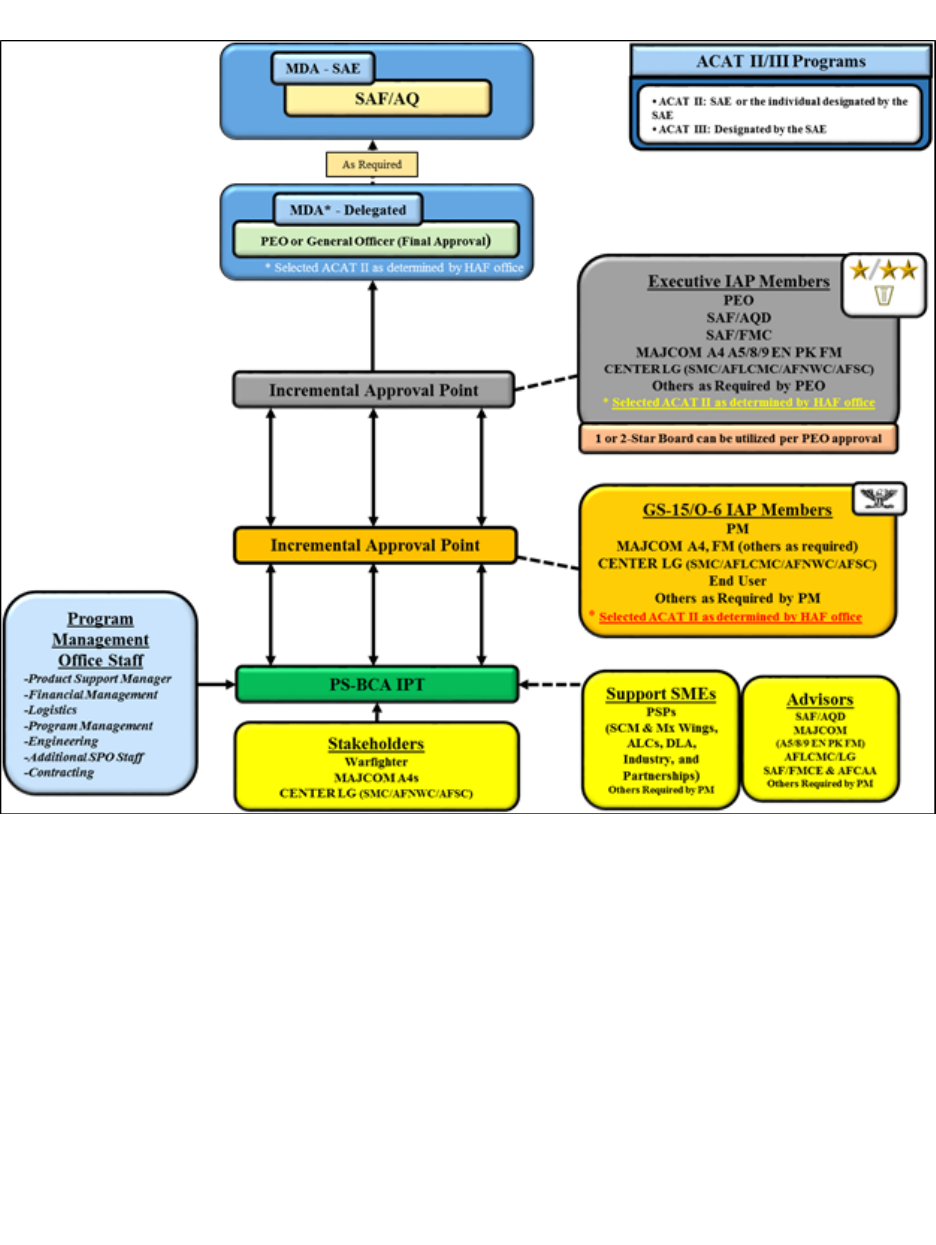
DAFPAM63-123 14 APRIL 2022 29
Figure 2.2. ACAT II and III Programs.
2.4.2. Defense Acquisition Board (DAB). The Defense Acquisition Board (DAB) is the senior
advisory board for the DoD acquisition system and provides advice on critical acquisition
decisions. The board is chaired by the USD (A&S) and includes the Vice Chairman of the
Joint Chiefs of Staff, the Service Secretaries, and a number of Under Secretaries of Defense.
Members of the DAB are responsible for approving MDAPs and serve as the most important
executive review of expensive acquisition projects in the DoD. The DAB is also the principal
review forum enabling USD (A&S) to fulfill 10 USC Chapter 144 responsibilities concerning
ACAT I programs.
2.4.2.1. Best Practice: Presenting/coordinating the PS-BCA recommendation to the
appropriate stakeholders/advisors and within the chain of command is the responsibility of
the PMO. While not technically in the PM-PEO-MDA chain of command, it is
recommended for all ACAT IC/D and ACAT IAC/AM programs to ensure product support
validation within sustainment command centers prior to making recommendation to the
SAE. (e.g., Programs within Air Force Materiel Command (AFMC) should ensure Air
Force Sustainment Center (AFSC) / Air Force Life Cycle Management Center (AFLCMC)

30 DAFPAM63-123 14 APRIL 2022
Air Force Nuclear Weapons Center (AFNWC) commanders are presented with the PS-
BCA recommendation.) Coordinate ACAT IC programs with SAF/FMC per AFI 65-501.
2.4.3. Assistant Secretary of the Air Force (Acquisition) (SAF/AQ). The SAF/AQ has the
authority, responsibility and accountability for all Air Force acquisition programs and for
enforcement of USD (A&S) procedures. The SAF/AQ may choose to enact a decision based
on their inherent knowledge of a program for ACAT IC, ACAT IAC, and ACAT II programs
(if not delegated).
2.4.4. Incremental Approval Points (IAPs). IAPs are vector checks designed to provide
directional guidance and concurrence throughout the process on such matters as the scope,
GR&A, evaluation criteria, problem statement, COA selection, data sources, risk mitigation
strategies, and all other critical factors contained within the PS-BCA. IAPs ensure the PS-
BCA strategy integrates an enterprise wide perspective. IAPs help identify and gain
concurrence on key GR&As, constraints, and most notably the weighting and scoring
methodology. IAP members are determined by the impact and level of the decisions being
made, as well as the PSM’s chain of command.
2.4.5. IAP Frequency. There is no limit for the number of IAPs during development of the PS-
BCA. Discretion as to how many IAPs to conduct is left to the PSM. The PSM needs to ensure
all aspects of the PS-BCA are well communicated and shared with appropriate stakeholders,
SMEs, and advisors. The PSM should have this governance body in mind when developing
the PS-BCA. These periodic meetings, and/or coordination activities, should ensure that no
stakeholder or approval authority is surprised by the final PS-BCA recommendation.
2.4.5.1. Executive (GO/SES) Level Incremental Approval Point. The Executive General
Officer/Senior Executive Service (GO/SES) level IAP includes multi-functional senior
executives who provide an enterprise perspective to enhance decision making for the
MDA. The Executive IAP members provide senior level review balancing requirements,
resources, priorities, and mandates. Executive IAP members also provide guidance to the
acquisition execution chain from an integrated and enterprise perspective. This includes
providing insight and ensuring statutory and regulatory compliance and providing support
to the PS-BCA team as requested. The PEO may choose to utilize existing command 1-
Star governance boards or virtually coordinate with the Executive IAP members.
Executive IAP members include, as applicable:
2.4.5.1.1. PEO
2.4.5.1.2. Directorate of Logistics and Product Support (SAF/AQD)
2.4.5.1.3. Directorate of Information Dominance (SAF/AQI)
2.4.5.1.4. Directorate of Global Power (SAF/AQP)
2.4.5.1.5. Directorate of Global Reach (SAF/AQQ)
2.4.5.1.6. Directorate of Cost and Economics (SAF/FMC)
2.4.5.1.7. MAJCOM A4 A5/8/9 Engineering (EN), Contracting (PK), Financial
Management (FM) (or USSF equivalent)

DAFPAM63-123 14 APRIL 2022 31
2.4.5.1.8. Center LG (Space Systems Command (SSC)/Air Force Life Cycle
Management Center (AFLCMC)/Air Force Nuclear Weapons Center (AFNWC)/Air
Force Sustainment Center (AFSC))
2.4.5.1.9. Space Systems Command (SSC)/Space Logistics Directorate (S4)
2.4.5.1.10. Others as required by PEO
2.4.5.2. O-6/GS-15 Level Incremental Approval Point. The multi-functional O-6/GS-15
IAP reviews the GR&A, constraints, and weighting/scoring criteria and advises on the
authoritative data sources used by the PS-BCA IPT to conduct the financial and non-
financial analysis. The criteria for the authoritative data source should be: accurate,
comprehensive, consistent, timely, available, and accepted. This approval step may occur
numerous times in the course of the PS-BCA process as data sources are revealed as
determined by the PM. The O-6/GS-15 IAP members include, as applicable:
2.4.5.2.1. PM
2.4.5.2.2. MAJCOM A4 A5/8/9 Engineering (EN), Contracting (PK), Financial
Management (FM) (others as required)
2.4.5.2.3. Center LG (SSC/AFLCMC/AFNWC/AFSC)
2.4.5.2.4. End-User
2.4.5.2.5. Others as required by the PM
2.4.5.2.6. SAF/AQD (Only ACAT I / Select OSD Programs)
2.4.5.2.7. SAF/AQ (I, P,Q) (Only ACAT I / Select OSD Programs)
2.4.5.2.8. SAF/FMC (Only ACAT I / All OSD Programs)
2.5. PS-BCA IPT Roles, Responsibilities, and Functions. The following section provides
guidance on assembling a PS-BCA IPT. The section addresses involving the right stakeholders,
support SMEs, and advisors at the kickoff meeting and assembling the governance structures. A
PS-BCA is a team effort undertaken by experienced participants across a wide range of specialties.
From the initial stages of accomplishing the background research and gathering the data, through
the final stages of staffing a PS-BCA for senior decision makers, completing an effective PS-BCA
requires significant effort by all those involved.
2.5.1. PS-BCA IPT Structure. Product support encompasses a range of disciplines including,
but not limited to, logistics, requirements, operational mission planning, financial
management, contracts, legal, and integrated product support elements. The structure of the
PS-BCA IPT varies depending on the maturity and the mission of the program. The PSM
should be cognizant of where the program is in the life cycle, understand the major
milestones/events, and provide useful information to the decision makers for the program to
move successfully forward through the life cycle. The team should leverage the cross-
functional expertise of its members to ensure all support COAs are considered and the best
value PSS is selected.
2.5.2. PS-BCA IPT Characteristics. PSS are comprehensive and require early and frequent
discussion and planning efforts across and between all key stakeholders and advisors. An
effective PS-BCA IPT has these characteristics:

32 DAFPAM63-123 14 APRIL 2022
All functional disciplines influencing the weapon system throughout its lifetime are
represented.
All the members buy into the team's goals, plans of actions and milestones,
responsibilities, and authorities.
All staffing, funding, and facilities requirements are identified and resourced.
2.5.3. PS-BCA Role and Responsibilities. The following sections describe roles and
responsibilities of key IPT members that may be involved in the PS-BCA depending on the
program’s life cycle phase. The PMO should maintain an IPT membership plan which should
use all of the information collected to lead IPT membership. The IPT membership plan is a
key component of executing and completing a successful PS-BCA. A large portion of IPT
management focus is on communication. The cornerstone of stakeholder and advisor
management is understanding who needs what information and when or how often they need
it. The PS-BCA process map (see Figure 1.10) incorporates relationships between activities
and functional units. This diagram focuses on the logical relationship of the value activities
and shows opportunities for open dialogue across multiple levels. The various stakeholders
representing organizations, SMEs, advisors, approval authorities, etc. should all work together
from the initial development of the problem statement through the final PS-BCA report
incorporating the MDA decision and attaching the PS-BCA to the LCSP.
2.5.3.1. Program Management Office (PMO). The PMO staff assists the PM and PSM in
developing the PS-BCA. Within the PMO, the PSM is responsible for planning,
developing, implementing, and executing the PSS, informed by the PS-BCA. Each
member of the PMO staff should actively participate in the PS-BCA kickoff meeting and
in developing the scope, GR&As, and problem statement. PS-BCA roles and
responsibilities should generally remain consistent regardless of whether the role is
performed by a government employee or a contractor, but ultimately the PMO staff is
responsible for the content and PS-BCA deliverables.
2.5.3.1.1. The PMO staff should determine what individuals or groups can influence
and affect the PS-BCA or be affected by its performance and outcome. IPT member
identification is the process used to identify all stakeholders, SME support, and
advisors for a PS-BCA. It is important to understand that not all IPT members have
the same influence or effect on a PS-BCA, nor will they be affected in the same manner.
There are many ways to identify IPT members, however, it should be done in a
methodical and logical way to ensure that IPT members are not easily omitted. The
selection process may be done by looking at IPT members organizationally,
geographically, or by involvement with various phases or objectives. Another way of
determining IPT members is to identify those who are directly impacted by the PS-
BCA and those who may be indirectly affected. Examples of directly impacted IPT
members are the project team members or the MAJCOM who directed the PS-BCA is
being done for. Those indirectly affected may include an adjacent organization or
members on the local community. Directly affected IPT members should usually have
greater influence and impact of the PS-BCA than those indirectly affected.
2.5.3.1.2. Support contractors (extension of the PMO) may participate in the PS-BCA
IPT, but they cannot commit the PMO they support to a specific position. The PMO is
responsible for ensuring support contractors are employed in ways that do not create
the potential for a conflict of interest. Contractor support staff may participate in PS-

DAFPAM63-123 14 APRIL 2022 33
BCA IPT discussions, however, they are not permitted to represent the position of the
supported organization and it is recommended they be asked to sign non-disclosure
agreements prior to deliberations. The PMO should consult with the legal advisor to
determine whether an organizational conflict of interest exists.
2.5.3.2. Program Manager (PM). The owner of the PS-BCA is the PM and he/she is the
primary initiator of the actions and recommendations derived out of the PS-BCA. The PM
also obtains the resources necessary for accomplishing the PS-BCA.
2.5.3.3. Product Support Manager (PSM). While the PSM reports directly to the PM,
he/she has statutory responsibility, per 10 USC §2337, to lead the PS-BCA. This includes
overseeing the team that is conducting and writing the PS-BCA. The OSD PSM guidebook
and the DoD PS-BCA guidebook can assist the PSM in defining the roles and
responsibilities of the team members. PSMs are also responsible for managing support
functions required to field and maintain the readiness and operational capability of major
weapon systems, subsystems, and components. Ultimately, the PSM serves as the overall
lead for the development of the PS-BCA:
Responsible for assembling the governance structure, appropriate board members,
stakeholders, support SMEs and advisors
Identify PS-BCA IPT members (to include Contractors, Original Equipment
Manufacturers (OEMs), depot/operations/logistical units)
Key player in the problem statement development and approval
Provides insight on support strategy and integration of the IPSEs.
Key player on development of COAs and identification of data sources
2.5.3.4. Data Manager. One of the primary responsibilities of the data manager is
maintaining and keeping historical records of PS-BCAs. These records include research,
performance outcomes, cost estimates and methodology, and sources of data. Effective
configuration management of acquisition documents supports the decision making
processes by allowing decision makers to have information available throughout the
present and future PS-BCA process. The functions a data manager performs can be
accomplished utilizing existing resources. Some members of the PS-BCA may perform
multiple roles and responsibilities.
2.5.3.5. Cost Analyst. The cost analyst has the training and skills to develop the
financial/cost analysis section, the analytical methodology for the PS-BCA, and
comparative analysis of both quantitative and qualitative factors for each COA. The cost
analyst works with the budget analyst who analyzes historical funding and develops the
budget plan with regards to the recommended PS-BCA approach. The cost analyst
prepares and organizes the PS-BCA cost estimate in accordance with (IAW) applicable
AFI, AFMANs, OSD, and Office of Management & Budget (OMB) guidance, actively
participates in the formation of the cost scope and baseline, and performs PS-BCA
calculations to include life cycle cost estimates, benefit analyses, risk assessments,
affordability, and sensitivity analyses. The cost analysis is a primary duty of the PS-BCA
IPT and highlights the cost differences between support or sustainment strategies. PS-
BCA cost analysts should follow the cost estimating guidance outlined in the DoD “Cost
Assessment and Program Evaluation (CAPE) Operating and Support Cost Estimating
Guide (September 2020).”

34 DAFPAM63-123 14 APRIL 2022
2.5.3.6. Logistician (Requirements, Logistics, and Supportability Manager). The
logistician is responsible for ensuring the sustainment strategy, requirements, and
performance measures are in the PS-BCA. The logistician also provides COA specifics
and ensures sustainment requirements are comprehensively met. Additionally, this person
is responsible for completing the mission impact section, including the non-financial
analysis of the PS-BCA as well as collecting and calculating system/program logistics
metrics such as failure projections, operating hours and sparing requirements. The PMO
may have to obtain Space Operations Command (SpOC), Headquarters Air Force Materiel
Command (HQ AFMC) or AFSC SMEs for Supply Management, Deployment/
Distribution/Transportation, Maintenance support, and Life Cycle Logistics (LCL)
expertise.
2.5.3.7. Chief Engineer. The Chief Engineer and the PSM work together to align the
program’s strategies for systems engineering and product support so they are mutually
supportive, avoid duplication, and take advantage of available synergies. The Chief
Engineer develops COAs with the PSM and works with the PM and the PSM to select the
program’s comprehensive life cycle engineering approach.
2.5.3.8. Contract Officers/Managers. Contracting officers/managers are active IPT
members to ensure contractually viable strategies.
2.5.3.9. Stakeholders. A stakeholder is a person or group of people who can affect or be
affected by the PS-BCA. Depending on the complexity and scope of the PS-BCA, there
may be very few or an extremely large number of stakeholders. The PS-BCA lead should
look at each stakeholder to gather more in depth information in order to understand their
impact, involvement, communication requirements, and preferences. Are they a cohesive
team? Do they support this PS-BCA or are they critical of it? What is this stakeholder’s
interest in this project? These are the types of questions that should be answered in order
to provide a complete analysis.
2.5.3.10. Warfighter. PS-BCA impacts on the warfighter are the primary considerations.
The warfighter provides the performance requirements for the weapon system which are
taken into account for the PSS. The warfighter also provides feedback on the system and
PSS.
2.5.3.11. AFMC
2.5.3.11.1. AFMC/A4. PS-BCA impacts on the enterprise sustainment infrastructure
are the primary considerations of AFMC from a command perspective. AFMC ensures
statutory compliance for core, 50-50, 6% capital investments, and achieve best value
while ensuring support to the warfighter.
2.5.3.11.2. Air Force Sustainment Center Logistics Directorate (AFSC/LG).
Responsible and accountable for managing AFSC’s overall planning, resource, process
& performance execution to achieve Air Force Sustainment Center Commander
(AFSC/CC) integrated vision for a strategy focused organization. AFSC/LG has
inherent authority to oversee, integrate, standardize, and direct processes, resources,
and organizations to achieve AFSC goals and objectives.
2.5.3.12. Space Systems Command (SSC)

DAFPAM63-123 14 APRIL 2022 35
2.5.3.12.1. SpOC/S4. Responsible for PS-BCA impacts on the acquisition and
sustainment of space capabilities, including life cycle management planning,
sustainment planning and sustainment management for all assigned AF space and
missile systems.
2.5.3.12.2. Space Systems Command, Product Support Enterprise Directorate
(SSC/ECP). Responsible for acquisition and sustainment of space capabilities,
including life cycle management planning, sustainment planning and sustainment
management for all assigned AF space and missile systems. SSC/ECP is the single
focal point for life cycle management of space systems logistics and sustainment
functions for AF PEO Space delivered systems. SSC/ECP consolidates, coordinates,
and provides a single focal point for logistics/sustainment activities including cross
system integration, acquisition logistics, logistics readiness, SE, and program support
of assigned PSMs.
2.5.3.13. Subject Matter Experts (SMEs). SMEs are recognized experts with specialized
knowledge applicable to the analysis and preparation of the PS-BCA components
(logistics, engineering, contracting, budget analysis, etc.). The PS-BCA IPT should
leverage SMEs within the PMO, and from functional areas with specific expertise in the
focus area or life cycle phase of the program (e.g., software or materials or risk SMEs).
This includes other relevant members that provide inputs to and/or impact the PS-BCA
analysis. SMEs are typically found among those who have been in their roles long enough
for the knowledge and experience to be “second nature,” or in other words, they know how
to do their jobs without having to look up information. In the case of extremely complex
roles, they might have to look up information even as a SME, but they know exactly where
to find that information. Evidence of sound SMEs include – but is not limited to – the
following:
Correctly determines what levels of performance are acceptable and can identify
and clearly describe performance objectives.
Knows the order in which successful performance steps are to be performed, and
may have made recommendations for improvement that have been adopted.
Has a high degree of familiarity with the technical jargon in his/her area of
expertise.
For work that is less about performing tasks and more about mastering knowledge
required to make effective decisions or to prioritize and assign work to teams, a
SME is very familiar with the requisite knowledge that underlies effective
decision-making.
Can produce many cases that illustrate “good” versus “poor” decisions in his/her
area of expertise.
Knows how to explain his/her area of expertise clearly to others and may serve as
a coach, mentor or supervisor within his/her area of expertise.
2.5.3.14. Product Support Providers (PSPs). Organic organizations (Supply Chain
Management Groups (SCMGs), Maintenance Groups, Defense Logistics Agency, etc.)
Private Sector (Industry), and Partnership representatives may be invited to PS-BCA IPT
meetings to provide information, advice, and recommendations to the IPT, however, the
following guidelines should govern their participation:

36 DAFPAM63-123 14 APRIL 2022
PSPs should not be formal members of the PS-BCA IPT.
PSPs should not be present during IPT deliberations on acquisition strategy or
competition sensitive matters, nor during any other discussions that would give
them a marketing or competitive advantage.
At the beginning of each meeting, the IPT lead should introduce each PSP
representative, including their affiliation, and their purpose for attending.
The PS-BCA lead should inform IPT members of the need to restrict discussions
while PSPs are in the room, and/or the IAP chair should request the
representatives to leave before matters are discussed that are inappropriate for
them to hear.
2.5.3.14.1. Best Practice: Given the sensitive nature of PS-BCA IPT discussions, PSPs
may not be permitted to participate in certain discussions. The PSM may permit PSPs
to make presentations to the PS-BCA IPT, when such views will better inform the IPT
and do not involve the PSPs directly in government decision making.
2.5.3.15. Advisors. The role of an advisor is to provide guidance and assistance to the PS-
BCA IPT. Advisors provide the IPT with an objective point of view during the decision
making process with logical and holistic context considering product support strategies.
2.5.3.16. SAF/AQD (Required). Provides enterprise oversight of all matters pertaining to
product support, Supply Chain Management (SCM), maintenance of military materiel, and
all support functions required to field and maintain the readiness and operational capability
of weapon systems, including all functions related to weapon system readiness. Supports
programs with oversight, guidance and assistance relative to product support during the
development of programmatic documentation and the execution of program reviews
throughout the life cycle. Responsible for enterprise oversight of all matters pertaining to
Air Force depots throughout the life cycle and advises the Assistant Secretary of the Air
Force (Acquisition) (SAF/AQ).
2.5.3.17. SAF/FM and/or MAJCOM FM (Required). Provides expert cost, economic,
comparative analysis, and financial decision support to the Air Force, DoD, and Congress,
thereby enhancing Air Force warfighting capabilities and maximizing available resources.
Responsible for cost analysis, budget formulation, distribution of budget and execution
oversight for base infrastructure and space weapon systems sustainment, funds control and
distribution for all appropriations and overall financial resource management, accounting
and oversight. Supports the requirements definition process, specifically in leading the
cost analysis working group for studies for satisfying warfighter requirements and
furnishing expertise for independent review, when applicable, of cost estimates produced
by other entities.
2.5.3.18. AFCAA (Required). The Air Force Cost Analysis Agency (AFCAA) provides
independent component cost analyses for major space, aircraft, and information system
programs as required by public law and DoD policy, or those of special interest. It is
responsible for cost estimating and for enhancing the state-of-the-art methodologies in cost
analysis. It provides guidance, analytical support, and quantitative cost risk analyses to 11
major commands and the Air Force corporate staff on development of cost per flying-hour
factors and resource requirements. AFCAA performs special studies supporting long-
range planning, force structure, analysis of COAs, and life-cycle cost analyses. For ACAT

DAFPAM63-123 14 APRIL 2022 37
I and special programs, AFCAA along with the Directorate of Economics and Business
Management (SAF/FMCE) perform the SAF/FMC review and coordination/certification
of products that include comparative analyses.
2.5.3.19. AFLCMC/LG or SSC/ECP or AFNWC/LG. Provides product support and life-
cycle logistics capability through functional management and training of logisticians
SMEs. Also provides hands-on assistance planning, workforce management and
development support for all logisticians. Provides an analytical capability to support PMOs
and Center leadership and integration with other AFMC Centers.
2.5.3.20. SSC/S4. Provides product support and life-cycle logistics capability through
functional management and training of logisticians and SMEs. Also provides hands-on
assistance planning, workforce management and development support for all logisticians.
Provides an analytical capability to support PMOs and Center leadership and integration
with the Space Systems Command (SSC).
2.5.3.21. AFMC A5/8/9 SSC/S5/8/9. Responsible for the requirements definition process
for core sustainment command capabilities. Responsible for operational requirements
development and oversight of the development, acquisition and fielding of new
capabilities. Assists with command-wide and functional assessments of current and future
plans, operations, logistics and sustainment requirements. Provides oversight of modeling
and simulation efforts, as well as scientific analyses and assessments.
2.5.3.22. Legal Officers/Advisors. Legal officers/advisors should be involved early and
frequently in the PS-BCA process to ensure compliance with laws and regulations, to aid
in COA analysis, and in risk identification and analysis.

38 DAFPAM63-123 14 APRIL 2022
Chapter 3
PLANNING FOR THE PRODUCT SUPPORT BUSINESS CASE ANALYSIS.
3.1. PS-BCA IPT Kickoff Meeting. The PS-BCA IPT kickoff meeting is a working level
meeting focused on providing training and guidance. Organize, Train, & Equip (OT&E)
organizations such as AFLCMC/LG, AFSC/LG, AFNWC, and SSC/ECP should provide PS-BCA
training and the PMO should provide program description and overview. The PMO works with
stakeholders and mandatory advisors to ensure the right IPT members are identified for the kickoff
meeting and provides input in preparation of the kickoff meeting. IPT members should review
and finalize the charter, draft a problem statement, develop GR&As, identify and document desired
objectives, discuss COAs, set up the structure of analysis, and review action items and way
forward.
3.2. Preparation for Kickoff Meeting. The PMO should identify appropriate stakeholders and
mandatory advisors to begin preparing for the PS-BCA IPT Kickoff Meeting as soon as practical.
This PS-BCA framework includes developing an agenda, problem statement, scope, desired
outcome(s), schedule, and the initial GR&As which become part of the PS-BCA charter. The
appropriate governance structure should eventually approve the elements of the framework.
3.2.1. Determine PMO PS-BCA Staffing Requirements. The PMO determines if the PS-BCA
will be executed entirely with organic resources or if contractors will be used to assist in the
analysis. The PMO should coordinate with Acquisition Center Logistics Directorate personnel
to obtain guidance for conducting the Product Support Business Case Analysis, to include
using government personnel to the maximum extent possible, prior to awarding contracts for
the analysis. If contractors are used, then prior to the kickoff meeting, the PMO should ensure
the contractors are contacted and required Associated Contractor Agreements are in place. It
is recommended the agreements include pre-priced extensions, if needed, to complete the final
out-brief and PS-BCA report in case there are unforeseen schedule extensions.
3.2.2. Identify PS-BCA IPT Membership. The PMO determines which organizations (defined
in Section 2: Roles and Responsibilities) are required to support the PS-BCA effort. Prior to
the PS-BCA IPT kickoff meeting, the PMO requests Point of Contact (POCs) from each
organization that will be part of the PS-BCA IPT and provides any background or relevant
program information.
3.2.3. Identify the Governance Structure and Approval Authority. The PSM should have an
established approval structure for the PS-BCA. The PSM may use existing PM/PEO/MDA
chain or establish a separate governance structure to approve a PS-BCA. The PSM may choose
to use existing boards to serve as part of the governance structure. The PSM is responsible to
contact the secretariat and coordinate the intent to use the board as part of the PS-BCA
governance. It is important that the PSM leverages the IAP to ensure the PS-BCA is fully
coordinated prior to seeking approval from the chosen PS-BCA governance structure.
3.2.4. Preliminary Assessment. Conduct preliminary assessment of potential COAs and
required data needed to support the analysis.
3.2.5. Data Collection Plan. The data collection plan will be discussed in more detail in
Section 9 (Data Selection, Collection and Assessment Plan), however, the PMO should
conduct a review of potential data sources (both organic and contractor) and identify potential

DAFPAM63-123 14 APRIL 2022 39
authoritative data sources (e.g.: LIMS-EV, AFTOC, CEMS, etc.) prior to the kickoff meeting.
If a gap in data exists, the PMO should determine if it is feasible to mitigate the gap (i.e.:
request data via Contract Data Requirements List (CDRL), establish contractual agreement, or
develop potential workaround/alternative data sources). In the event the data is not available
and no workaround exists, this gap identification should be addressed at the kickoff meeting
and may impact the development of potential COAs/metric selection processes.
3.2.6. Data Quality. By collecting useful technical and cost data early in the life-cycle,
decision makers should have the information necessary to make the best assessment possible
of the current product support plan with respect to any COA, placing the program leadership
in a better position to complete the PS-BCA requirement. Since the PS-BCA is periodically
required to be revalidated, it is in the PM’s best interest to have the highest quality data
available. As a result, the team should anticipate and plan for adequate updates to firmly
address the usual risks associated with a PS-BCA, such as a lack of platform specific historical
cost data, or a change in procurement quantity, scope, or service life.
3.2.7. Situational Awareness. Review prior product support related analyses and determine if
any additional analysis should be completed/ updated/reviewed prior to the PS-BCA kickoff
meeting (i.e.: 5-year Depot Source of Repair (DSOR) review, Independent Logistics
Assessment (ILA), Depot Activation Prioritization Model assessment, Program Office
Estimate (POE), etc.).
3.2.8. Determine Realistic Schedule. As noted previously, a PS-BCA requires significant
effort to complete and establishing an appropriate and achievable schedule is critical to mission
success. Experience has shown that schedules can be influenced by the size of the program,
the current life cycle phase of the program, whether new documentation or revalidated
documentation will be used, access to leadership, review time required by the leadership, to
name but a few.
3.3. Identify and Establish the PS-BCA IPT. The PS-BCA IPT should consist of stakeholders,
support SMEs, and advisors who have a stake or interest in the outcome of the PS-BCA.
Stakeholders represent organizations or entities that play an active role in the execution of the
program throughout the life cycle. Advisors represent organizations or entities that support either
the program or the PS-BCA process but do not play an active role in the execution of the program.
3.3.1. IPT Membership. Table 3.1 provides a list of organizations that can provide program
specific PS-BCA IPT members upon request. Request for team member participation should
be sent to the various organizations prior to the kickoff meeting.
Table 3.1. IPT Membership.
Organization
Role
Support Responsibility
PMO
Stakeholder
PS-BCA author and IPT lead (PSM)
Provides program unique data and resources
(e.g. program management, data
management, financial management, cost
analysis, logistics, systems engineering,
legal, contracting)
Supports PSM in development and execution
of the PS-BCA

40 DAFPAM63-123 14 APRIL 2022
Organization
Role
Support Responsibility
Reviews analyses
Warfighter
Stakeholder
Provides the performance requirements for
the weapon system which are taken into
account for the PSS
HQ AFMC/A4 or HQ
SpOC/S4
Stakeholder
Provides operational and supportability
requirements
Provides operational data to support analysis
Ensures statutory compliance
Develop PS-BCA implementing guidance
Function as part of incremental approval
point process
Provide expertise as requested to PEOs in
support of PS-BCA IPT functions
Provide training as required to workforce
related to PS-BCA implementation, ensure
workforce possesses knowledge, skills,
abilities, and tools necessary for PS-BCA
implementation
Collaborate with SAF/AQD, AFMC/A4,
AFIT and Defense Acquisition University as
required to develop/refine training specific
for PS-BCA implementation
AFSC/LG
Stakeholder
Responsible and accountable for reviewing
proposed COAs to ensure AFSC capabilities
are being considered and addressed
Consolidates, validates, and verifies
information and data provided by AFSC
support SMEs to PS-BCA IPT
Entry/exit point for AFSC for subject matter
expertise and specific data requests
Supply Chain
Management Wings
Support SME
Provides data as required via AFSC/LG as
required
Air Logistics Complex
Support SME
Provides data as required
DLA
Support SME
Provides data as required
Contractor/(OEM)
Support SME
Provides data as required
Partnership
Representatives
Support SME
Provides data as required
SAF/AQD
Advisor
Assists with PSS development
SAF/FMC
Advisor
Advises with PS-BCA methodology and cost
model development for ACAT I level and all
OSD programs
SSC/ECP
Advisor
Consolidates, validates, and verifies
information and data provided by AFSC
Functional Stakeholders

DAFPAM63-123 14 APRIL 2022 41
Organization
Role
Support Responsibility
Provide the latest PS-BCA guidance to all
Space programs
Archive and share samples and best practices
with PMOs
Review draft PS-BCAs and provide
comments
MAJCOM FM
Advisor
Validates all cost analysis prior to final
report coordination/briefings
AFCAA
Advisor
Provide guidance, analytical support, and
cost risk analyses for ACAT I level and all
OSD programs
AFLCMC/LG
Advisor
Enterprise level PS-BCA process lead for
their command
SpOC/S4
Advisor
Enterprise level PS-BCA process lead for
their command
AFMC A5/8/9
SpOC/S5/8/9
Advisor
Requirements definition process for core
sustainment command capabilities
Oversight of modeling and simulation
efforts, as well as scientific analyses and
assessments
3.4. Kickoff Meeting.
3.4.1. Introductions. The PSM conducts roll call and allows stakeholders, support SMEs, and
advisors to introduce themselves by name, organization and their role in the PS-BCA process.
3.4.2. Agenda Review. The PSM provides an overview of the agenda.
3.4.3. Program Overview. The PSM provides a program overview that includes a brief history
of the program, the phase within the acquisition life cycle, industry/market conditions,
significant program events, and any product support challenges or performance deficiencies
the program is experiencing. Additionally, the overview includes relevant information on
historical precedents, previous BCA or PSS attempts, acquisition documentation and
stakeholders. The overview should provide enough background to give a general
understanding of the program. This step facilitates defining the baseline, or “as is” COA, and
provides context for development of the problem statement. Background information should
include:
3.4.3.1. Program description.
3.4.3.2. Mission.
3.4.3.3. Acquisition phase.
3.4.3.4. Reason for PS-BCA (Milestone phase in the acquisition life cycle, New weapon
system or platform, Proposed change in PSS, Five-year revalidation).
3.4.4. Significant changes. Any significant changes to the following since previous analyses
were accomplished (revalidation):
3.4.4.1. Operating environment.

42 DAFPAM63-123 14 APRIL 2022
3.4.4.2. Operating tempo.
3.4.4.3. Modifications to contracting language.
3.4.4.4. Basing.
3.4.4.5. Budgetary environment.
3.4.5. Review Charter. The PS-BCA IPT reviews and updates the charter to summarize the
PS-BCA IPT’s direction and approval process. Elements of the charter include authority,
purpose, problem statement, scope, desired outcome(s), baseline determination, governance
structure, and schedule.
3.4.6. Baseline Determination. Describe the “as is” state in sufficient detail to establish cost,
and for new systems identify analogous systems for comparative cost analysis. Refer to Section
4 (COAs) for additional information.
3.4.7. Framework Development
3.4.7.1. Problem Statement. The PS-BCA problem statement should provide an accurate
and concise reason for conducting the PS-BCA, as well as define the analysis framework
for the current deficiencies, additional requirements, or opportunities for improvement.
The problem statement is also commonly referred to as the “objective.” For additional
detail, refer to guidance in AFMAN 65-506, Section 2.2. The PS-BCA should also focus
on identifying the best value PSS by balancing requirements (i.e.: Operational Availability
(Ao)) and affordability to meet the warfighters’ requirements. The PSS for a specific
program or component should be tailored to the operational and support requirements of
the system. However, readiness and availability should be balanced with affordability,
taking budget realities into account. There is no “one size fits all” approach to PSS
development. During the PS-BCA IPT problem statement development, the IPT needs to
consider the following key questions:
3.4.7.1.1. What is the desired end state?
3.4.7.1.2. What is the purpose of the analysis?
3.4.7.1.3. What is required to meet statute?
3.4.7.1.4. Is there an existing PSS in place? If so, are requirements/expectations being
met?
3.4.7.1.5. Are their deficiencies, additional requirements, or opportunities to improve
system support?
3.4.7.1.6. What decision(s) is/are the analysis intended to support?
3.4.7.1.7. Has appropriate product support analysis been completed (such as Level of
Repair Analysis, Depot Source of Repair, Supportability Analysis)
3.4.7.1.8. Caution/Pit Fall: PS-BCA problem statements should not assume a specific
means of achieving the desired result. Rather, problem statements contain an objective
description of the desired end-state or outcome (i.e., not biased toward any one COA).
Biases or unfounded assumptions in problem statements undermine the analytical
purpose of the PS-BCA by jumping to conclusions.

DAFPAM63-123 14 APRIL 2022 43
3.4.7.2. Scope. A well-defined problem statement aids in establishing the scope of the PS-
BCA. The scope will then aid the IPT in setting and maintaining the boundaries for the
analysis. Scope includes what product support capability and timeframes will be analyzed.
The scope should also state what aspects of the program are not included in the analysis
and why (i.e.: covered under separate analysis, not a differentiator across the COAs,
outside the area of responsibility of the PMO, etc). The scope of the analysis describes the
content that is included in the analysis and the content that is excluded from the analysis.
In order to determine the scope, the PS-BCA IPT needs consider the following:
3.4.7.2.1. Will the analysis be conducted for the entire system or only on certain sub-
systems?
3.4.7.2.2. Will the analysis include both common and peculiar components?
3.4.7.2.3. Will the analysis include associated equipment not managed by the PMO
conducting the analysis (i.e.: training systems, weapons, system
engineering/automated test systems (ATS), etc.)?
3.4.7.2.4. Will all 12 IPS elements be analyzed? If one or more of the IPS elements
are not applicable to the PS-BCA, a rationale should be provided that describes the
exclusion.
3.4.7.2.5. What organizations are impacted/involved in the analysis?
3.4.7.2.6. What geographical areas, sites, and locations are impacted/involved in the
analysis?
3.4.7.2.7. Is this a peacetime or wartime operating environment?
3.4.7.2.8. Are there other categories that might have a potential impact on the decision?
3.4.7.2.9. Will the PS-BCA consider all 12 IPS elements? Table 3.2 shows a second
recommended categorization of the 12 IPS elements combined into higher
level/overarching categories. The asterisks (*) within Table 3.2 annotates cross-
cutting elements and should be considered across all categories. This second
categorization is very similar to the breakout of the 12 IPS elements previously
discussed in Section 1 (Overview) of the pamphlet.
Table 3.2. Integrated Product Support (IPS) Element Categorization.
Product Support
Management
Maintenance
Supply Chain
Management
Sustaining
Engineering
Technical Data
Computer Resources
(except for S/W
Maintenance)
Facilities and
Infrastructure*
Support Equipment*
Training and Training
Systems*
Computer Resources
(S/W Maintenance
Only)
Maintenance
Planning and
Management
Supply Support
PHS&T
Design Interface
Sustaining
Engineering

44 DAFPAM63-123 14 APRIL 2022
Manpower and
Personnel*
Product Support
Management
3.4.7.2.10. Has the PS-BCA IPT clearly explained and documented why an area of the
program was included or excluded and the rationale needs to link back to the PS-BCA
problem statement?
3.4.7.3. Desired Objectives and Requirements. The desired objectives for requirements
identified by the PS-BCA IPT should be coordinated at the O-6/GS-15 IAP. The PS-BCA
IPT needs to come to consensus on the desired objectives and periodically review them to
remain on track. IAP members should also concur with the desired objectives. Some
possible sources of program requirements may be the Key Performance Parameters (KPP),
Key System Attributes (KSA), performance metrics already identified by the Capability
Development Document (CDD), and Capabilities Production Document (CPD).
3.4.7.3.1. The desired objectives and documented requirements may take the form of
a Product Support Arrangement (PSA). A PSA is an implementing agreement, such as
a contract, memorandum of understanding (MOU), memorandum of agreement
(MOA), commercial service agreement (CSA), service level agreement (SLA), and
similar formal agreements to ensure performance expectations (on both sides) are
clearly articulated.
3.4.7.3.2. Desired Objectives Examples.
3.4.7.3.2.1. MAJCOM perspective: Increase in Aircraft Availability (AA) to meet
mission requirements without increasing fleet size.
3.4.7.3.2.2. A reduction of Mission Impaired Capability Awaiting Parts (MICAP)
across the platform that supports an increase in AA to meet mission requirements
without increase in cost or logistics footprint.
3.4.7.3.2.3. Reduction in Operation & Support (O&S) costs.
3.4.7.3.3. Best Practice. It is difficult to create a good problem statement without
thinking through the scope and desired objectives. The problem statement creation is
iterative. A good problem statement provides a clear description of the issue areas to
be evaluated and how success will be evaluated. The problem statement should be
approved by the appropriate governance structure at/or around the time of the kickoff
meeting, i.e. PEO and/or PM. Leadership concurrence early in the PS-BCA process
can mitigate unnecessary rework and ensure the analysis covers the assigned subjects.
Make sure problem statement scope and objectives are properly aligned. Clearly
identify if multiple ACAT program(s) are associated with the analysis and include in
GR&A (i.e.: If the PS-BCA is planned to include a weapon system and any associated
modernization efforts, need to state what modernization efforts are included in the
baseline.) Ensure that desired objectives can be properly addressed in the analysis. For
example, if one of the desired objectives is an increase in AA, ensure that
methodologies and relevant data will be available to provide this information.

DAFPAM63-123 14 APRIL 2022 45
3.4.7.4. Ground Rules & Assumptions (GR&As). This section provides guidance on
documenting GR&As and methodology used for a PS-BCA. GR&As and methodologies
should be examined early in the PS-BCA process and the draft GR&As and methodology
should be developed prior to the kickoff meeting. Putting the GR&As in the charter helps
frame the analysis and supports the rules of engagement for the PS-BCA IPT. The initial
GR&As may be modified as the analysis progresses. Any change to GR&As after the
charter is signed should be vetted and agreed to by the IAP members prior to
implementation.
3.4.7.4.1. Ground Rules. The ground rules document known or dictated parameters
and conditions for the PS-BCA. Prior to formulating assumptions, what is known for
certainty should be stated under the ground rules: facts, laws, defined criteria,
constraints, regulations, OSD and/or Service guidance. Included in the ground rules
are any factors known to be true that may affect the current or future business
conditions. Constraints are those factors known or discovered that are beyond the
control of the PM or PSM and bound the PS-BCA analysis. The PS-BCA IPT needs
to understand these constraints before beginning the analysis. Constraints should be
presented to the governance board and decision maker of the PS-BCA. An example of
a constraint could be funding constraints originated by a congressional mandate.
Programs should have an initial DSOR at MS-A, and an updated DSOR at MS-B. For
programs at or past MS-C, they should have completed their DSOR and preceding Core
determination. These DSOR and Core determinations should not be superseded by the
PS-BCA. The ground rules should be compliant with all applicable laws including but
not limited to 10 USC §2460, §2464 and §2466. A non-exhaustive list of major PS-
BCA ground rules includes:
3.4.7.4.1.1. Legislation, regulations, and policy
3.4.7.4.1.2. Financial data in base-year or then-year dollars
3.4.7.4.1.3. Directed inflation index
3.4.7.4.1.4. Quantity of fielded systems
3.4.7.4.1.5. Expected flying hour program and service life
3.4.7.4.1.6. The XX Fleet size is ### with an expected service life of YY years.
3.4.7.4.1.7. Flying hours per system is ###.
3.4.7.4.1.8. Engines will average initial and subsequent overhaul intervals of
~XX,XXX flying hours.
3.4.7.4.1.9. MAJCOM Ao threshold is ##% and Objective is ##%.
3.4.7.4.1.10. Other DoD agencies (i.e. Navy, Army, Defense Logistics Agency
(DLA), etc.) will manage/repair common (stock listed) spare parts and/or support
equipment that applies to the (name of program) system.
3.4.7.4.1.11. The (program name) will be maintained using what maintenance
concept – organizational level (O-level) and depot level (D-level); however, there
will be some O-level back shop work to be defined.
3.4.7.4.1.12. All costs will be presented in Base Year 20XX (BYXX) dollars and

46 DAFPAM63-123 14 APRIL 2022
Then-Year (TY) dollars.
3.4.7.4.1.13. All comparative cost dollars will be presented in Net Present Value
(NPV) or Present Value (PV) Costs, as appropriate.
3.4.7.4.1.14. The O&S Element Structure used in the cost analysis will be based
on the guidance provided in the Operating and Support Cost Estimating Guide and
prepared by the OSD CAPE.
3.4.7.4.2. Assumptions. An assumption is an informed position about what is true of a
current or future state of affairs for a situation where explicit factual knowledge is
unobtainable (i.e., inflation rates). Assumptions define aspects that are beyond the
control of the PS-BCA team. They are explicit statements about the conditions on
which the PS-BCA IPT bases the analysis. After stating factors in the ground rules
section, list assumptions and document why those assumptions were selected. If a
stakeholder or advisor non-concurs with any selected assumption, document the
rationale for the non-concurrence. Assumptions are also vital for the risk and
sensitivity analysis. It is important to note that GR&As may be changed throughout the
analysis process. GR&As do not need to be 100% complete for charter inclusion.
GR&As in the charter should be used to help frame the analysis and support rules of
engagement for the IPT. However, any changes to GR&As after the charter is signed
should be vetted and agreed to by the IPT prior to implementation. In the sensitivity
analysis section, evaluate each major assumption to determine its impact on the PS-
BCA recommendation. Omitting, changing, or misusing of assumptions can directly
influence which COA is recommended. A non-exhaustive list of major PS-BCA
assumptions includes:
3.4.7.4.2.1. Financial metrics and inputs (inflation).
3.4.7.4.2.2. Physical environment.
3.4.7.4.2.3. Contingency vs. non-contingency operations.
3.4.7.4.2.4. Expected useful life of a weapon system.
3.4.7.4.2.5. The “as-is” COA should represent the current POE and LCSP.
3.4.7.4.2.6. (List additional items) should be considered as part of the PS-BCA.
3.4.7.4.2.7. (List additional items) not considered as part of the PS-BCA.
3.4.7.4.2.8. Benefits metrics span the same time period as the cost estimate to
provide uniformity in comparing cost to benefits.
3.4.7.4.2.9. Programmed Depot Maintenance (PDM) / Analytical Condition
Inspection (ACI) / modification line will remain on an X-year cycle for the study
scope of YYYY-YYYY.
3.4.7.4.3. Exclusions and Inclusions. Exclusions are those areas outside the scope of
the analysis and/or those areas that would be the same for all scenarios. Examples of
areas that could be excluded from the analysis are as follows:
3.4.7.4.3.1. Sunk costs
3.4.7.4.3.2. Realized benefits

DAFPAM63-123 14 APRIL 2022 47
3.4.7.4.3.3. Modification programs under development
3.4.7.4.3.4. Programs that required a standalone study
3.4.7.4.4. Inclusions identify areas specifically considered as applicable to the study.
Examples of areas that could be included in the analysis are as follows:
3.4.7.4.4.1. Non-recurring start-up costs
3.4.7.4.4.2. Material cost
3.4.7.4.4.3. Depot Maintenance Cost (incremental rate and full cost to recover rate)
3.4.7.4.4.4. Support equipment
3.4.7.4.4.5. Training/simulators
3.4.8. Update Charter. The PS-BCA IPT updates the charter to summarize the PS-BCA IPT’s
activities per the IPT kickoff meeting.

48 DAFPAM63-123 14 APRIL 2022
Chapter 4
COURSES OF ACTION
4.1. Introduction. COAs, also known as alternatives, are various options to achieve the desired
objective. Selection of the proper product support COA is essential to the success of the PS-BCA.
There is no set maximum number, however, a minimum of two COAs is required for a PS-BCA.
The decision maker, however, should have a representative range of COAs to make a well
informed decision. If too many COAs are evaluated for example, the costs and time to perform
the PS-BCA analysis will increase and the quality of the analysis for each COA will likely be
negatively impacted. Therefore, the team should carefully consider the breadth and variety of
COAs to be selected for analysis.
4.1.1. COA Development. COAs can be intuitively obvious or they may take a determined
effort to define. Creativity is key to developing effective COAs and many times groups are
more creative than individuals. All alternatives that are reasonable and feasible shall be fully
analyzed (AFMAN 65-506, Paragraph 3.3.2). Those developing COAs should have knowledge
of the program in question and an understanding, or at least a solid foundation, of the different
IPS elements.
4.1.2. COA Detail. COAs need to be described in sufficient detail to facilitate proper analysis
(cost, benefit and risk). COAs should also be defined so that appropriate IPS and costs elements
can be identified and evaluated in terms of the scope of work and who will perform the work.
Even those unfamiliar with the COAs should be able to read the descriptions and fully
understand the concepts and what is required to implement the COAs. Additionally, each COA
needs to be clearly distinguishable from other COAs.
4.2. Status Quo COA. The PS-BCA should include a COA which is the status quo as
documented in the LCSP. This is the “change nothing” or “as-is” COA that describes how the
function or process under study currently exists. The PS-BCA is about action, inaction and
consequences. Changing nothing for now is not necessarily "neutral" - there can be both negative
and positive consequences - and a full consideration of all factors should strengthen any
subsequent findings. For assessments completed prior to MS-C, the PMO should utilize the PSS
approved at the previous MS as the “as-is” COA.
4.2.1. COA Baseline. The status quo or “as-is” COA should serve as a baseline against which
all other COAs are compared. This COA also takes into account the future plan of the
organization, such as planned and scheduled changes and/or enhancements to the existing
program, and should reflect a review of the mission and strategic goals.
4.3. Future State COAs. Future state COAs, also known as the “to-be” COAs, establish other
options that should be evaluated. As stated previously, these COAs need to be clearly
distinguishable from each other and also provide sufficient variety to give decision makers options
to choose from.
4.3.1. COA Formulation. Future state COAs are formulated by the PS-BCA IPT. The IPT
utilizes brainstorming techniques or structured techniques such as the Decision Support Matrix
for Product Support, as described in the DoD Product Support PS-BCA Guidebook, to assist
them throughout the process. There are two primary methods to structure COAs, holistic and
modular.
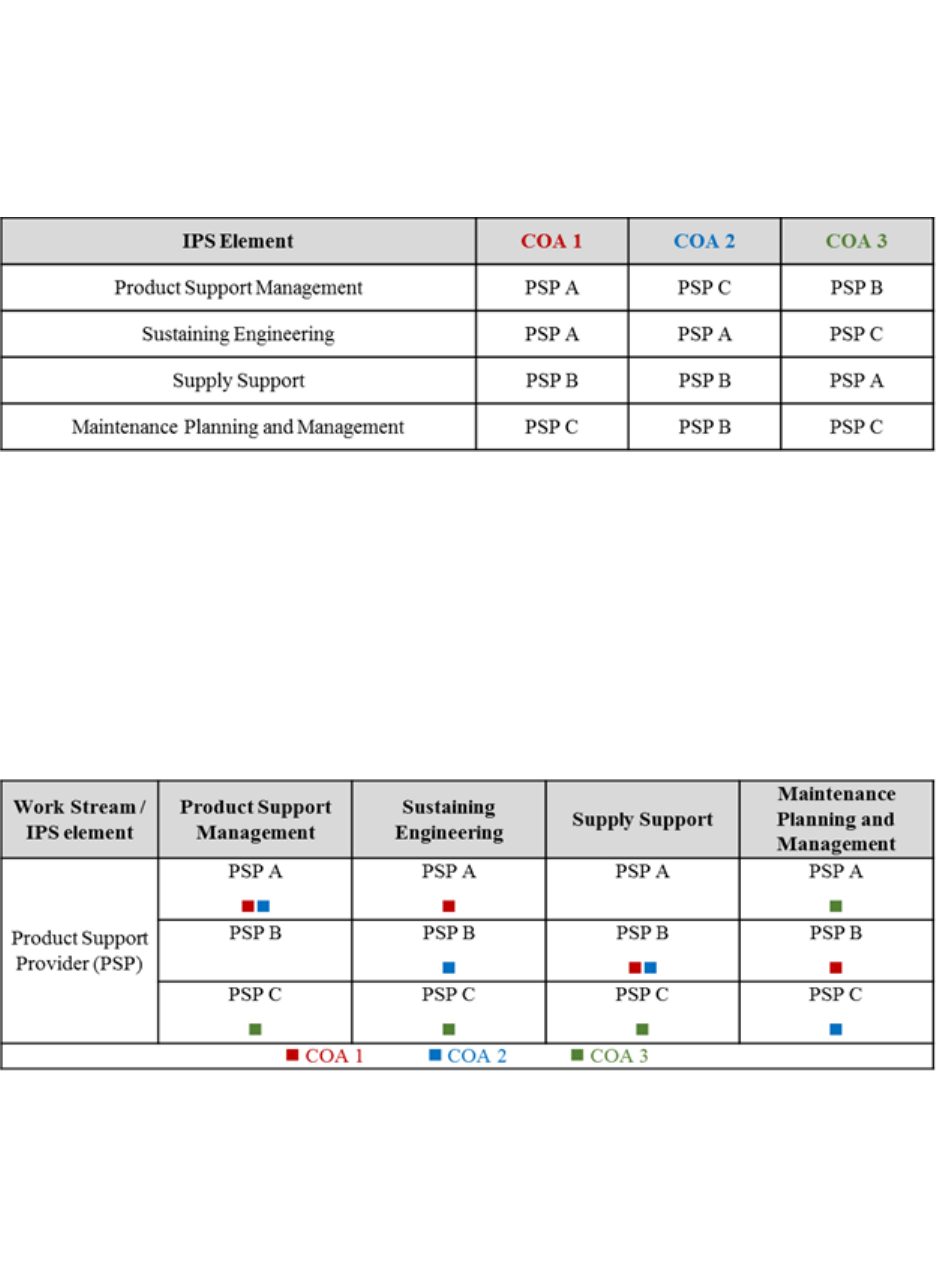
DAFPAM63-123 14 APRIL 2022 49
4.3.2. Holistic Approach. The holistic approach views the work streams, or IPS elements, as
interrelated and are not analyzed independent of each other. This is essentially an “all or
nothing” perspective to developing COAs. When using a holistic approach costs, benefits, and
risks are assessed across all IPS elements at the same time. If a PS-BCA is being performed
after MS-C, a holistic approach is generally used due to overlapping work streams. Table 4.1
shows how this approach would be represented for the individual IPS elements.
Table 4.1. Holistic Approach.
4.3.3. Modular Approach. The modular approach, views the work streams or IPS elements as
standalone elements which can be combined to form a COA. An example of a modular
approach, shown in the Table 4.2, assesses costs, benefits, and risks associated with each work
stream and then combining those work streams in a variety of combinations to determine the
best overall COA. The IPT should examine each of the IPS elements to ensure the proprietary
nature of data and intellectual property does not inhibit potential combinations. If a PS-BCA
is being performed prior to MS-C, a modular approach is generally used due to the analogous
data that is used and this should provide flexibility to decision makers by allowing them to
customize a COA for their decisions.
Table 4.2. Modular Approach.
4.3.4. Comprehensive View. The best solution is not necessarily the most obvious solution,
and some innovative thought is often required to develop other possible solutions to a problem.
In defining COAs, the IPT should take a comprehensive view and include considerations
related to each COA.
4.3.5. COA Limitations. To begin defining COAs, the IPT should establish the limits of viable
COAs (bookends) in order to establish boundaries for a diverse set of COAs to analyze. While

50 DAFPAM63-123 14 APRIL 2022
COAs can be defined in terms of capabilities and performance, they are usually defined in
terms of the source of product support (i.e., organic or contractor). All organic or all contractor
supported systems are rare and are generally limited to mission driven operational environment
factors (all organic) or commercial or commercial-derivative systems (all contractor). Even
though all organic or contractor source of product support are often not viable, the rationale
for their exclusion from evaluation should be included in the PS-BCA. The alternative analysis
focuses on achieving the appropriate mix of organic and contractor capabilities through finding
the best value solution for each of the IPS elements required for sustainment.
4.3.6. COA Evaluation. When defining future state COAs, the IPT needs to explain how each
“to-be” COA operates, how it provides value to the organization, and how it compares to the
current “as-is” COA. Other questions the IPT needs to consider include: How do future state
COAs address shortfalls in the current state? How does one future COA relate to other “to-
be” COAs being examined? For each COA considered, the IPT describes the future state of
operations that the proposed decision should help achieve. Additionally, the PS-BCA contains
the rationale decisions on how COAs were developed and how COAs were eliminated as part
of a down-select process.
4.3.7. Additional Factors. Other factors to consider when identifying and defining future state
COAs include the following.
4.3.7.1. Identify the reasonableness and feasibility of product support providers across the
different IPS elements. For additional detail, refer to AFMAN 65-506, Section 3.3.
4.3.7.2. Consider various feasible combinations of workload percentages, such as 50–50,
25–75, 75–25.
4.3.7.3. Consider the possibility of developing competitive contractor COAs using both
the OEM and Third Party Logistics (3PL) options.
4.3.7.4. Consider various contract types and specify the degree to which it impacts the
analysis.
4.3.7.5. When applicable, use PPP to leverage the capabilities of both organic and
contractor sectors. See DoD PPP for Sustainment Guidebook for further information on
each type of PPP. Tailor partnerships to IPS elements at the component, sub-assembly, or
system/platform level.
4.3.7.6. Address items that have been identified as a requirement to establish repair
capability, including considerations of facilities, personnel and data rights.
4.3.7.7. Ensure COAs are in compliance with Title 10 U.S. Code §2464, Core logistics
capabilities, the DSOR decision, and Title 10 U.S. Code §2466. Explanation needs to be
included if a COA is not in compliance.
4.3.7.8. For systems in sustainment, consider focusing COA development on specific IPS
elements where there are performance gaps or opportunities for improvements.
Additionally, keep in mind that previous decisions or specific leadership direction may
influence COA development for systems in the sustainment phase.
4.4. Reasonableness and Feasibility. By definition, the option selected to meet the desired
objective should be one of, or a combination of, the COAs considered. Therefore, it is essential
that in the decision-making process a range of reasonable COAs are examined. For a COA to be

DAFPAM63-123 14 APRIL 2022 51
reasonable, it must be consistent with all legal requirements and Air Force regulations. Adequacy
and feasibility are other key elements in the identification of reasonable COAs. Adequacy refers
to the capacity of the potential COA to meet the desired objective. Feasibility refers to the potential
COA being consistent with funding, technological and scheduling realities.
4.4.1. Iterative Process. COA analysis is an iterative process. The first step is an examination
of the range of potential COAs to determine which are reasonable and require further
evaluation. This information should be summarized in the PS-BCA. An alternative that meets
the desired objective, including the status quo, is reasonable if it cannot be eliminated on non-
economic grounds. It is possible that only one COA will be reasonable, however, generally
there are two or three reasonable COAs that warrant further evaluation. Normally, no more
than four or five COAs are considered in detail, although there are exceptions.
4.4.2. COA Elimination. A COA can be eliminated from further analysis whenever it appears
to no longer achieve the desired objective; it should be coordinated with the O-6/GS-15 IAP
to gain concurrence with its removal. COA elimination requires approval at the O-6/GS-15
level of the governance body. For example, a number of COAs were considered but as the
analysis progressed, only two emerged as feasible. The preliminary calculation of life-cycle
costs and benefits demonstrated that one of the two COAs was clearly superior to, and less
costly, than the other. At that point, there was no benefit to be gained from completing any
further analysis. The findings should simply be documented in a short report or memorandum.
4.4.3. COA documentation. If a COA was considered but dismissed as unreasonable,
document the rationale for dismissal in the PS-BCA final report. Cost alone is not a valid
rationale for a COA being dismissed. If cost is the only aspect of an infeasibility determination
for a COA, the analysis should be shown. Specifically, the COA should be developed, costed,
and proven to be prohibitive, not merely dismissed from the onset as being infeasible due to
cost.
4.4.4. Additional Consideration. Areas to consider when validating and determining
feasibility include, but are not limited to, the following:
Are all feasible COAs considered?
Are a reasonable number of COAs considered to include the limits (bookends) COAs and
hybrid COAs containing diverse combinations of providers for the various integrated
product support elements?
Are COAs significantly different?
Is adequate supporting documentation provided for all COAs that were down selected
before full analysis was completed?
Are the COAs in accordance with legislative guidance?
Were other government agencies' capabilities to provide a product or service considered?
Are the COAs defined in such a manner that the applicable benefits, cost elements and
possible risks can be clearly identified and assigned?
Do the COAs clearly identify who will provide support in each case? For example, will
support be provided organically or commercially?
Do the COAs identify where the work will be done? For example, will depot or material
support be provided locally or will transportation to other locations be required?
Depending on the answer, this might involve additional cost and possibly an increase in
time.

52 DAFPAM63-123 14 APRIL 2022
Are obvious COAs included or addressed in some manner? For example, an obvious
issue to address in the COAs is whether maintenance and other sustainment activities
should be performed by the government or by a contractor.

DAFPAM63-123 14 APRIL 2022 53
Chapter 5
BENEFITS AND NON-FINANCIAL ANALYSIS
5.1. Benefits Introduction. Benefits are non-monetary factors that are a critical part of COA
evaluation in comparative analyses. Benefits differ from cost in that, costs are inputs (monetary
resources) required to implement each COA, whereas, benefits are the outputs to be gained as a
result of the resource inputs. In developing the list of costs and benefits, care should be taken to
avoid double-counting (i.e., benefits should be mutually exclusive). Benefits are evaluated using
the metrics that measure success in the “as is” state of the current product support arrangement.
These metrics should be applicable to all the COAs. They can be qualitative or quantitative in
nature (subjective or objective).
5.2. Selecting Benefits. To determine which benefits to include, stakeholders should assess the
factors most important in achieving the desired outcome and for evaluating the problem statement.
These should be tied to the product support requirements such as SCM, SE, maintenance, etc.
Benefits may be qualitative in nature, which injects a degree of subjectivity into the assessment.
While this subjectivity cannot be avoided, it is important that the scoring and results are traceable
and repeatable. Any and all categories of benefits analyzed should be fully explained so someone
unfamiliar with benefits can fully understand the benefit and its measurement. Note: If a benefit
can be measured in monetary terms, it should be included in the cost section of the analysis.
5.2.1. Stakeholder Input. One approach to select the benefits to be assessed is to receive input
from stakeholders, support SMEs, and advisors that are listed in Section 3 (PS-BCA IPT
Membership). As discussed above, a key advisor on the team should be a cost analyst who
should advise the team on methodology and process, but should not participate directly in the
weighting and scoring of benefits. The first step in the benefit analysis process is for the team
to develop a list of benefits expected to accrue as a result of implementing the COAs under
consideration.
5.2.2. Benefit Realization. Benefits should be developed within the context of the problem
statement and the scope of the analysis. The benefits developed should be benefits to the
government, not simply the program under study, attained over the period of analysis. Realized
benefits are excluded from consideration and this should be documented in the GR&As. There
are two broad categories of non-monetary benefits: non-monetary quantitative benefits and
non-monetary qualitative benefits.
5.2.3. Category Metric Attributes. The linkage from the category down to the metric and
attribute, along with the rationale and data source, should be completely documented by the
PS-BCA Team (see Table 5.1). Appendix F in the OSD Performance Based Logistics
guidebook, dated 2016, is a good source for metrics across the product support elements.
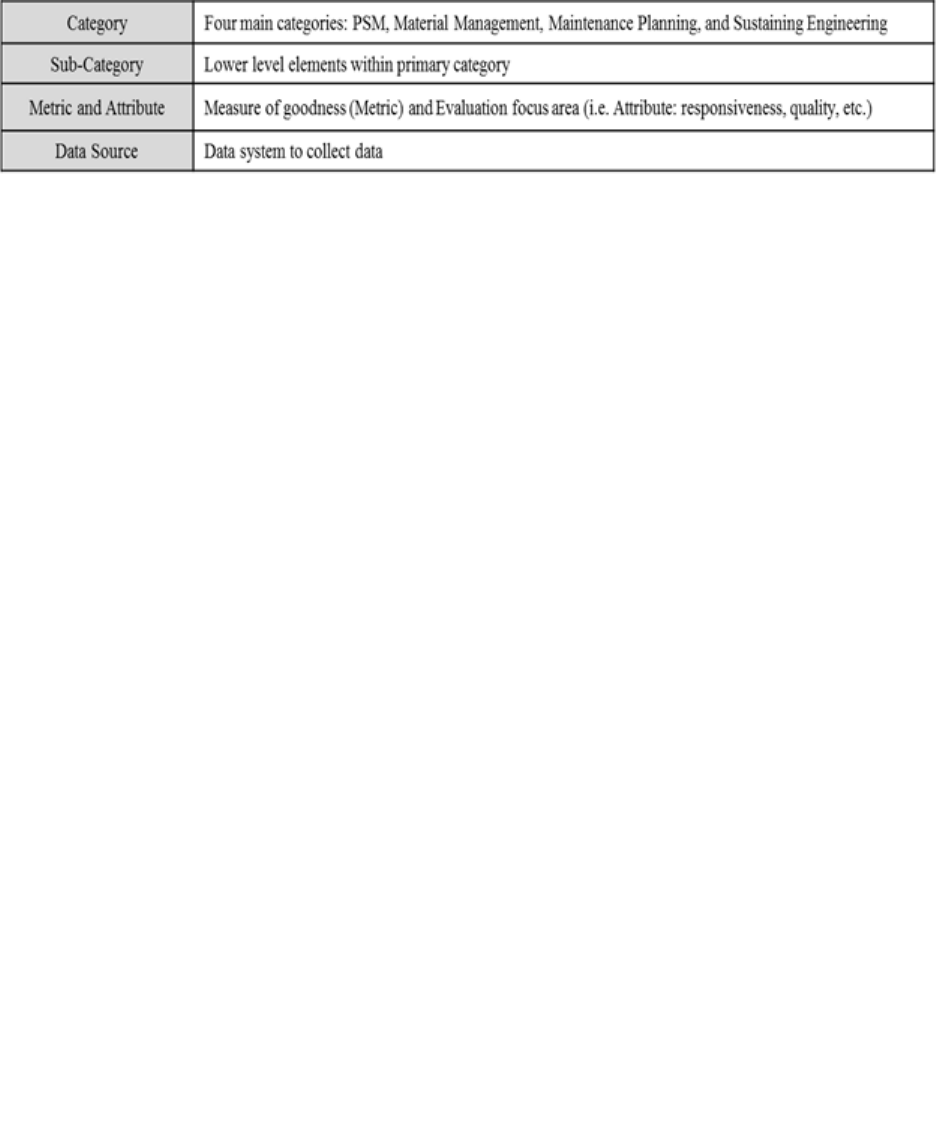
54 DAFPAM63-123 14 APRIL 2022
Table 5.1. Category Metric Attribute.
5.3. Quantitative Benefits and Metrics.
5.3.1. Non-monetary Factors. These factors are non-monetary, but quantifiable in terms other
than dollars. Examples of non-monetary, quantifiable benefits include AA, parts
supportability, system sustainability, etc. Benefits are the overall criteria selected of “measures
of goodness” of the COAs under consideration. PS-BCA IPTs should take care to fully use
quantitative benefits, if data permits, rather than a subjective benefit that is intended to measure
the same factor.
5.3.2. Metric Evaluation. Metrics are the data elements used in the evaluation of the benefits
categories. For example, a benefit selected by the team under the Supply Support Category
may be Issue Effectiveness. Existing metrics of the program under study, or an analogous
program for new programs with no history, provides a starting point for determining the most
important outputs of a particular project or program. There is no precise “right number” of
benefits or supporting metrics. However, benefits should be limited to those most important
in meeting the requirements established in the problem statement. Evaluating an excessive
number of benefits tends to dilute the impact of any one benefit and may result in inconclusive
results.
5.3.3. COA Comparison. All feasible COAs considered in the analysis should be evaluated
against the same set of benefits categories and metrics. If a particular COA does not provide
a stated benefit, it should be scored zero in the weighting and scoring process (Section 8.0,
Weighting and Scoring).
5.3.4. Wash Benefits. Benefits not expected to differ across COAs are wash benefits, just as
costs that are the same across COAs are wash costs, and can be excluded from the benefits
analysis. Excluded benefits should be discussed in the GR&As, so that it does not appear that
the omission was accidental.
5.3.5. Metrics supporting PSS. Metrics are the means by which the PSM and PS-BCA team
gain understanding of the PSS and identify potential gaps between required and actual
performance. There is no perfect metric, but selecting an appropriate set of metrics should
promote the desired behavior and outcome for executable COAs. Benefits criteria should be
coordinated with the O-6/GS-15 IAP.
5.3.6. Value-Add Metrics. Metrics should be selected or constructed to encourage
performance improvement, effectiveness, efficiency, and innovation. These metrics should be
applicable to “as is” state and should be the starting point for the PS-BCA. The metrics should
effectively align with the warfighters’ mission, contribute to meeting requirements, ensure on-
time delivery of a quality product, and reduce costs. It is important to exercise caution when

DAFPAM63-123 14 APRIL 2022 55
selecting a combination of metrics to ensure that they are not redundant, confounding, or
counteractive. Multiple metrics can reinforce desired behavior or create undesirable conflicts.
5.3.7. Metric Documentation. The PS-BCA Team should document the reasoning/rationale
for using the specific metrics. The sources and derivation of quantitative benefits must be
documented in the same level of detail as costs, and should include all interim calculations as
appropriate. The stakeholders and advisors should understand and agree to this rationale.
Below are examples of some quantitative benefits and associated metrics:
Table 5.2. Quantitative Benefits and Associated Metrics.
Category
Subcategory
Metric
Attribute
Data Source
Supply Chain
Management
Components
Issue
Effectiveness
Responsiveness
LIMS-EV
Supply Chain
Management
Components
Fill Rates
Responsiveness
LIMS-EV
Supply Chain
Management
Components
MICAP Hours
Responsiveness
LIMS-EV
Supply Chain
Management
Components
Customer Wait
Time (CWT)
Responsiveness
SBSS
Maintenance
Planning &
Management
DLRs/PDM/C-
check/ACI
PQDR
Quality
Joint Deficiency
Reporting
System
Maintenance
Planning &
Management
DLRs/PDM/C-
check/ACI
Flow days
Responsiveness/
Schedule
MP&E,
LIMS-EV
Sustaining
Engineering
Sustaining
Engineering
107 Requests
Engineering
Response Times
Program Office
Sustaining
Engineering
Sustaining
Engineering
202 Requests
Engineering
Response Times
Program Office
Sustaining
Engineering
Sustaining
Engineering
339 Requests
Engineering
Response Times
Program Office
5.4. Qualitative Benefits and Metrics. Qualitative benefits are intangible benefits that are not
easily quantified, but are nonetheless important. This might include factors such as capability
enhancements, environmental benefits (use of renewable energy resources, lower or less toxic
emissions, etc.), morale/quality of life, and safety. Strategic organizational benefits may be
difficult to quantify or may be unquantifiable/intangible in some situations, but are often very
critical when developing a business case. These benefits may be very important to the organization
because of law, policy, or strategic objectives that direct the result or because of other
organizational goals. A well done qualitative benefit analysis is as valid as a quantitative analysis.
Definition and explanation of benefits are important to give the analysis credibility and to help
readers understand their importance. Thorough definition and explanation of weighting and
scoring rationale go a long way in balancing the inherent subjectivity associated with a qualitative
analysis, and assuring decision makers that the benefit evaluation was based on sound reasoning
and represents stakeholder/advisor consensus on the methodology.

56 DAFPAM63-123 14 APRIL 2022
5.4.1. Financial Management Compliance. Compliance with AFI 65-501 and AFMAN 65-506
states analysis, inputs and rationale must be fully documented as part of the BCA, so that it is
traceable and repeatable.

DAFPAM63-123 14 APRIL 2022 57
Chapter 6
COST AND FINANCIAL ANALYSIS
6.1. PS-BCA Cost Estimates. This section states the requirements for developing credible,
defendable, and high quality PS-BCA cost estimates. The intent is to construct cost estimates for
all considered COAs which appropriately account for platform maturity and which can be
thoroughly documented, easily replicated, and utilized to effectively inform the MDA. Cost
methodologies must be thoroughly documented so the analysis can be replicated if necessary
(AFMAN 65-506, Paragraph 4.1.3.) Below are the criteria for completing credible, defendable,
and high quality PS-BCA cost estimates:
6.1.1. GR&As are reasonable and properly documented.
6.1.2. Guided by the problem statement.
6.1.3. Properly utilizes comparative analyses methods.
6.1.4. Data is normalized, projected and used in the estimate correctly.
6.1.5. The PS-BCA model and cost estimates accurately represent the PSS for each COA.
6.1.6. Ensures cost risk is handled consistently for each COA.
6.1.7. Enables the decision maker to make the most informed decision possible.
6.2. Criteria 1 – Guided by the Problem Statement. The cost analysis is guided by the problem
statement which is explained in section 3.2.6.1 of this pamphlet. If the problem statement is a best
value determination such as “The F-XX PS-BCA will determine the best value COA long-term
sustainment strategy for the F-XX unique items consistent with Air Force objectives,” then both
costs and benefits are evaluated and the cost estimates should include only F-XX unique items. If
the problem statement is a cost effectiveness analysis such as “The T-XX PS-BCA will look at all
strategies that reduce cost while keeping performance the same,” then cost is the only variable and
the estimates should keep performance the same across all COAs. If the problem statement is a
fixed budget optimization, such as “maximize performance of the B-XX while not exceeding a
$XXM threshold,” then the performance criteria should be adjusted until the corresponding cost
estimate is under the dollar threshold. The problem statement clearly defines the purpose of the
decision that the cost analysis is intended to support. The data collected and analyses performed
are focused on providing the decision maker as much information as possible for the problem being
addressed and the criteria being used to make the decision.
6.3. Criteria 2 – GR&As are Reasonable and Documented. The GR&As for the cost analysis
should be reasonable, documented, and constructed to aid the PS-BCA IPT in building credible,
defendable, and high quality cost estimates. Relevant GR&As should: (1) address elements that
drive a cost delta between COAs; (2) ensure the PS-BCA is fair, balanced, and a realistic
comparison across all COAs; and (3) have coordination from the IAP member organizations. The
rationale and source for each GR&A should be included.
6.3.1. Example: When transitioning from contractor maintained components to government
maintained components, it would be reasonable to assume that Interim Contract Support (ICS)
may be required for a few years while organic capabilities are being prepared. The

58 DAFPAM63-123 14 APRIL 2022
corresponding ground rule might be: For COAs standing up additional government repair,
assume four years of ICS, then transition to government.
6.4. Criteria 3 – Properly Utilizes the Various Types of Analysis. The PS-BCA is a
comparative analysis. The categories of costs included in a comparative analysis are governed by
OMB Circular A-94, Guidelines and Discount Rates for Benefit-Cost Analysis of Federal
Programs, and differ from the categories of costs included in other program cost estimates.
6.4.1. Comparative Analysis: A comparative analysis is any type of analysis examining the
costs, benefits and risks of alternative ways of achieving a given objective or fulfilling a need.
6.4.1.1. For comparative analyses, OMB Circular A-94 requires an “incremental” cost
approach.
6.4.1.2. The cost analysis will only include costs for which funds have not yet been
expended or irrevocably committed. Do not include sunk costs, as these costs do not factor
into the decision. When the magnitude and timing of a cost or benefit is identical for all
alternatives, they can be considered as “common costs” (also called “wash costs”) or
benefits. Common costs that do not add any additional information to the decision-making
process may be excluded from the comparison. Caution should be taken when identifying
common costs to confirm that costs or benefits excluded are identical for all alternatives.
Additionally, common costs should not be excluded when there is a requirement to reflect
the total program costs.
6.4.1.3. Caution. Other program estimates based on the total cost of the program won’t
match the cost estimate used for comparative analysis in the PS-BCA. Typical examples
include the Life Cycle Cost Estimate (LCCE) generated to support milestone decisions or
generated for budget purposes. While an LCCE can be the starting point of a PS-BCA cost
estimate, adjustments must be made to ensure that only incremental costs are included, that
sunk and wash costs are removed, and any other relevant changes (e.g., Labor Rates – see
below) are made to meet the requirements for a comparative analysis (AFMAN 65-506,
Paragraph 4.4.2).
6.4.1.4. Pitfall. The cost estimates used in the PS-BCA for comparative analysis do not
include all the costs necessary for understanding the implementation cost of an alternative
or for making a budget comparison. Adjustments should be made to these estimates for
use in any context outside the PS-BCA.
6.4.2. Labor Rates. Labor rates required for the PS-BCA should be different than those needed
for full or total cost of the program estimates. For organic depot labor calculations (to include
any civilian personnel not directly working at the depot but are necessary manpower increases
for these COAs), the PS-BCA IPT utilizes the incremental labor rate portion of the sales
rate/price to customers to identify the cost of implementing the final chosen alternative. The
change in the workload distribution as a result of the PS-BCA decision could change the
organic cost recovery sales rate/price and/or contractor labor rates.
6.4.2.1. For instance, if additional work is taken on by an organic depot, more mechanics,
engineers, floor supervisors and material would be needed in order to complete the task.
These incremental costs would be included in the organic depot incremental and full sales
rates. An organic depot sales rate includes both labor and material. However, the cost of
the base commander, while part of the burdening and cost to a customer, is not an

DAFPAM63-123 14 APRIL 2022 59
incremental cost and would not change with the decision to add workload to a depot.
Therefore, the base commander cost would be excluded in an incremental rate for a
comparative analysis. In most cases, the incremental cost rate uses the full cost to recover
Sales Rate as the baseline, and then removes all of the General & Administrative Costs, as
well as most of the Production Overhead costs – only leaving the Indirect Production
Material costs and the Shop Operating Material costs in the Production Overhead category
for Organic Depot Maintenance.
6.4.3. Workload Impacts. The last part of the analysis would be to determine if the decrease
in workload impacts other customers. For example, if the decision was made to move full
maintenance support for weapon system (A) from organic depot maintenance support to a
contractor, organic labor rates may increase due to the change in workload being supported
through the Air Force Working Capital Fund.
6.4.3.1. Similarly a change in workload for a contractor could impact a contractor’s
business base and labor rates, though this type of impact could be difficult to determine
without a contractor’s help or assistance from the Defense Contract Management Agency.
6.4.3.2. In addition to changes in direct costs, the PS-BCA IPT should be aware that a
change in workload could drive price changes to unrelated commodities or services. This
will definitely impact the taxpayer and should be taken into consideration.
6.5. Criteria 4 – Properly Utilizes the Highest Quality Data Available. Section 9 of this
pamphlet specifically addresses data selection, collection and assessment for PS-BCAs.
6.6. Criteria 5 – Data is Normalized, Projected and Used Correctly. Gathering relevant data
is vital to having a high quality cost estimate. Document completely the source/origin of all data
collected. Since data can be gathered from a variety of sources, it is often in many different forms
and needs to be adjusted before being used to enable apples-to-apples comparisons (i.e., so COAs
can be compared without unintended bias) or as a basis for projecting future costs. The process of
adjusting the data to enable an apples-to-apples comparison is called normalization. The analyst
should thoroughly document the normalization process and adjustments performed throughout the
cost estimating process. Data requires normalization for a number of reasons, some of which are
discussed below.
6.6.1. Inflation and Price Escalation. Inflation and price escalation are important and
necessary in developing a credible cost estimate and in normalizing existing data. They should
not be used interchangeably.
6.6.1.1. AFMAN 65-502, Inflation, defines inflation as the increase in general price level
over time or the decreasing purchasing power of the dollar over time. In application, this
means that, for a given number of dollars, less goods could be purchased 10 years in the
future than today. As a result, in order to utilize cost data from an antecedent platform, the
cost estimating team should need to adjust the source data to remove the effect of inflation
to ensure that all dollars, regardless of time, have the same value (i.e., purchasing power).
Collected data should be analyzed to determine the base year of the data. If the base year
of the data differs from the base year of the PS-BCA, then the data should be adjusted to
the PS-BCA’s base year before proceeding.
6.6.1.2. Escalation refers to the total change in price of specific goods or services over a
specific period of time. It includes both inflation and the “real price change” of the good
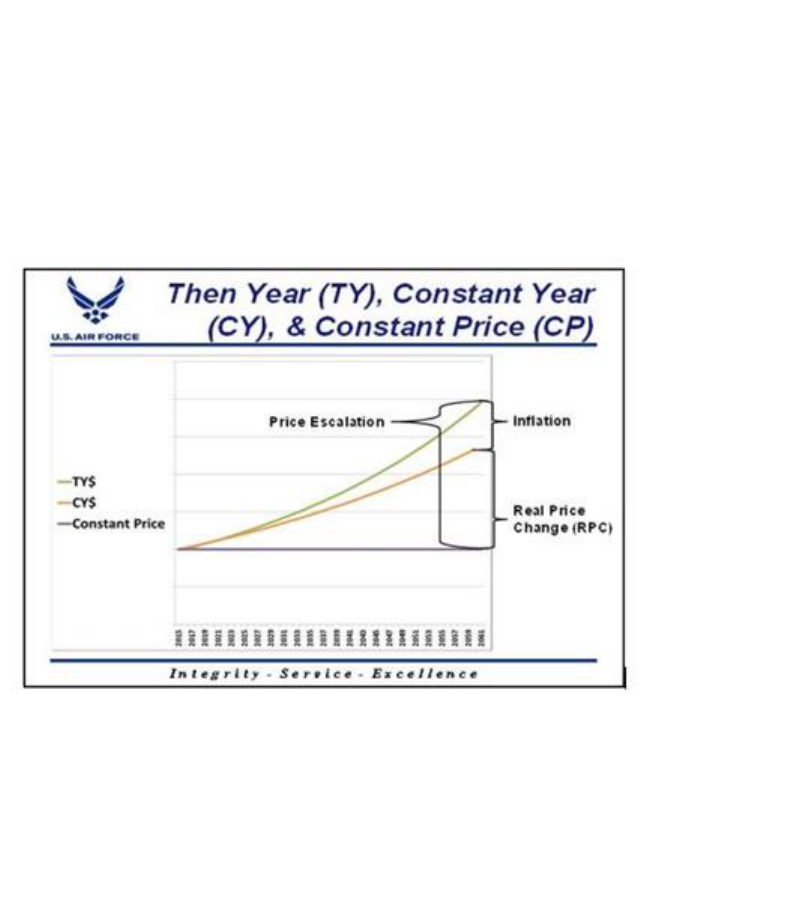
60 DAFPAM63-123 14 APRIL 2022
or service. The “real price change” is the difference between inflation and the total change
in price, and is caused by changes in the market (supply and demand). The ‘real price
change’ is the remaining price change after normalizing for inflation. The term “constant
dollar” implies currency has been normalized for inflation only. The term “constant price”
implies prices have been normalized for both inflation and market forces. In application,
care has to be taken to ensure that all alternatives are normalized for inflation, price
escalation, or both.
6.6.1.3. Escalation should be accounted for in the PS-BCA estimates for cost elements
whose prices are volatile or change at a significantly different rate than inflation (e.g., fuel,
specialized labor, etc.). Escalation rates deserve special consideration in order to properly
normalize data for use in an estimate. The Air Force specifies price escalation indices for
fuel, medical and government employee (military and civilian) pay and provides access to
Global Insight indices for other goods and services (see the SAF/FMCE website). The
escalation index used must be documented.
Figure 6.1. Illustration of Inflation, Price Escalation, and Real Price Change.
6.6.1.4. Best Practice: Assume the same escalation rate beyond known periods for all
estimates. Do not assume that one COA will escalate in a vastly different manner in the
far future unless the basis for that assumption can be firmly documented.
6.6.1.5. Caution/Pitfall: Setting unrealistic escalation assumptions or picking an
escalation rate “out of the air.” Because of the compounding nature of such rates,
unrealistic assumptions could drive or bias results. Utilize formal price indices and
forecasts (e.g., Global Insight indices, AF indices on SAF/FMCE website) as the basis for
the escalation assumptions.
6.6.1.6. Cost (e.g., content of cost, currency conversions). Units – Cost data needs to be
converted to equivalent units before being used in a data set. That is, costs expressed in
thousands, millions, or billions of dollars must be converted to the same format or
denomination.
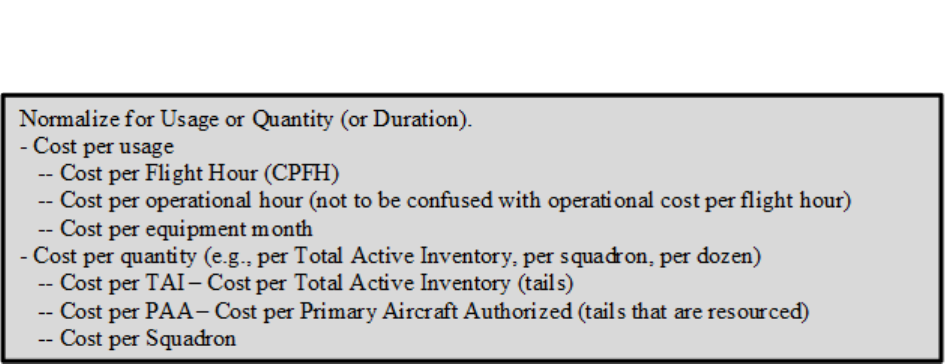
DAFPAM63-123 14 APRIL 2022 61
6.6.1.7. Content of Cost – The cost estimator needs to understand what the cost data
includes and ensure the content matches the support strategy being estimated. For example,
does it only include direct labor or does it include overhead and the contractor’s profit as
well?
6.6.1.8. Currency Conversion – Similarly, if costs are reported in different currencies, they
must be converted into U.S. dollars in order to have a like comparison. The cost analysis
portion of comparative analyses will be performed in United States dollars.
6.6.1.9. Sizing: Sizing normalizes data to a common qualitative and quantitative metric.
When normalizing data for size, it is important to define exactly what the item represents:
What constitutes a software line of code? Does it include carriage returns or comments?
The main point is to clearly define what the sizing metric is so the data can be converted
to a common standard before being used in the estimate.
6.6.1.10. Normalizing data for usage or quantity is another example of sizing to ensure a
common standard before including the data in an estimate. Figure 6.2 lists some of the
common usage or quantity normalizations seen in PS-BCAs.
Figure 6.2. Considerations When Normalizing Data for Usage or Quantity (or Duration).
6.6.1.10.1. Key Groupings: Key groupings normalize data by similar missions,
characteristics, or operating environments by cost type or work content. Products with
similar mission applications have similar characteristics and traits, as do products with
similar operating environments. For example, space systems exhibit characteristics
different from those of submarines, but the space shuttle has characteristics distinct
from those of a satellite even though they may share common features. Costs should
also be grouped by type. For example, costs should be broken out between recurring
and nonrecurring or fixed and variable costs.
6.6.1.10.2. Life-Cycle Effects/Productivity and Technology Maturity: Life-cycle
effects should be considered when comparing data from different programs. For
example, entering technology typically follows a reliability improvement curve and
would require normalization to be compared to steady state data. Likewise, technology
improves over time, so historic cost data may need to be normalized to adjust for
productivity or quality improvements resulting from technological advancements over
time.
6.6.1.10.3. All normalization actions must be documented. Price indices are often hard
to find, so it is important that the source of the indices are documented. If the cost

62 DAFPAM63-123 14 APRIL 2022
analysis team constructed a price index for use in the PS-BCA cost estimate, the
reasoning and process used in constructing the index must be documented as well. For
additional information on data collection and the reason to use certain data sources
(especially if multiple sources exist), refer to Section 9 of this pamphlet which
specifically addresses data collection.
6.6.1.10.4. For additional guidance on inflation and price escalation and how to apply
them properly in cost estimates, refer to AFMAN 65-502, Inflation.
6.7. Criteria 6 – Cost Estimates Accurately Represent the PSS for Each COA. The PS-BCA
model is a decision-support tool used to produce cost estimates for each COA. In order to
effectively support the decision maker, it needs to represent the PSS relationships. To do this, the
cost analyst requires clear technical and programmatic direction to properly construct the model
so that it produces cost estimates that reflect the PSS for each COA as accurately as possible. In
addition, the PS-BCA IPT should have a basic understanding of how the cost model works to
ensure that it accurately represents the PSS for all alternatives.
6.7.1. Vector Checks. While developing the cost estimating model, the PS-BCA IPT should
seek periodic vector checks early and often to ensure the model being constructed accurately
represents the PSS programmatic and technical content for each COA, not the COA’s “cost
behavior.”
6.7.1.1. In addition to cost personnel, include technical and functional personnel in the
vector checks to provide a fresh perspective on the cost model and to review its consistency
with the PSS.
6.7.2. Cost Review Process. Do not wait until the estimate is near completion before starting
the cost review process. This can lead to the realization that the entire PS-BCA estimating
framework is incorrect which would require a considerable amount of rework and delay the
already lengthy process to complete the PS-BCA.
6.7.3. Productivity Gains and Cost Avoidance. Efficiencies produced by an alternative that
result only in additional time for personnel to perform other duties, but will not result in
reduced manning or operating costs are defined as cost avoidances and should be addressed in
the benefits analysis of the EA, not the cost analysis since costs won’t change. For additional
detail on productivity gains and cost avoidance, reference AFMAN 65-506, Paragraph
5.3.2.1.4.
6.8. Criteria 7 – Ensure Cost Risk is Handled Consistently for Each COA. Cost risk needs to
be evaluated, and each PS-BCA should be consistent in how it handles cost risk for each COA.
The importance of providing comparable cost estimates that include the appropriately associated
cost risks cannot be overstated. In example, if a range and confidence levels are provided for one
COA, then a range and confidence levels should be provided for all COAs. Where appropriate, all
alternatives should be evaluated at similar confidence levels. For additional guidance specifically
on cost risk, refer to the Joint Agency Cost Schedule Risk and Uncertainty Handbook.
6.8.1. Cost Risk. An example of cost risk is the risk of funding technical data collection which
should be included in the risk analysis. If the risk can be quantified, it should be included in
the cost estimate section. Stochastically modeled risk in the cost model should not be double
counted by including it in the PS-BCA’s risk analysis (section 7.0).

DAFPAM63-123 14 APRIL 2022 63
6.9. Criteria 8 – Enables Decision Maker to Make the Most Informed Decision Possible. The
cost estimates for each COA need to be informative to the decision maker. The most precise cost
estimate that assumes away critical incremental costs that differ among the COAs or that does not
align with the intended PSS for that COA is not providing information that is essential. In the
end, a high quality PS-BCA cost estimate is one that informs the decision maker with relevant cost
information.
6.9.1. Present Value. Additionally, cost estimates have to be presented in a manner that the
COAs can be compared. To make a meaningful comparison of COAs, all costs intended to be
compared must be expressed in PV terms (AFMAN 65-506, Paragraph 4.4.2). Using PV
allows decision makers to consider future money streams in relation to the current value of
money. OMB Circular No. A-94 includes additional information and guidance, including
discount rates and formulas for computing NPV. AFMAN 65-506 provides additional
guidance on business case analysis and how to properly incorporate present value into a
product support business case.

64 DAFPAM63-123 14 APRIL 2022
Chapter 7
RISK ASSESSMENT
7.1. Introduction to Risk Assessment. After risks are identified, each risk factor should be
defined in detail to ensure all PS-BCA IPT members are interpreting the risk in the same way.
Care should be taken in this step to ensure there is no duplication or overlap in risk factors. Any
duplication will inappropriately skew the risk analysis and invalidate the results. If methodologies
that aggregate cost, benefit and risk (such as Analytical Hierarchy Process (AHP)) are used in the
PS-BCA, it is particularly important to ensure elements of cost, benefit and risk are mutually
exclusive. Any distortion in individual category results is amplified due to the weighting and
scoring algorithms used with these methodologies. The process of comparing different COAs is
not complete until a risk assessment is performed on each COA. DAFPAM 63-128, Integrated
Life Cycle Management, Chapter 12 provides the AF standard for risk assessment, and this
document adds fidelity to the subject as it relates to PS-BCAs. Risk should be treated separately
from cost and benefits. The analysis of risk should be based on probability and the impact of an
event. One COA may be the most cost effective but could be assessed as high risk due to technical,
operational or other risk classifications.
7.2. Defining Risk. It is difficult to discuss risk without discussing and defining the distinction
between risk and uncertainty. Risk, in its simplest sense, is the chance (probability) of loss or
injury. Uncertainty is the indefiniteness about the outcome of a situation in which both favorable
and unfavorable events can occur. Risk is then the probability of an unfavorable event occurring
that is the result of our uncertainty about a situation. In the sustainment of a weapon system, risk
can be defined as an uncertain event or condition that, if it occurs, can have negative effects on the
implementation of the PSS. It addresses the potential variation in the planned approach and its
expected outcome. While such variations could include positive as well as negative effects, this
pamphlet emphasizes the negative future effects (i.e. risk, not uncertainty). Risk management for
a PS-BCA involves the identification of potential risks for each COA, assessing probability and
impact of identified risks, developing a response to the risks, and finally monitoring risks over
time. As defined in the DoD Product Support Guidebook, risk can be classified as Business or
Programmatic, Operational, Suitability, Process, Technical, Schedule, Organizational,
Sustainability, Safety, and Environmental. Risks should exhibit three key components.
7.2.1. Future Root Cause. A future root cause (yet to happen), which, if eliminated or
corrected, would prevent a potential consequence from occurring.
7.2.2. Probability. A probability (or likelihood) assessed at the present time of that future root
cause occurring.
7.2.3. Consequence. The consequence (or effect) of that future occurrence.
7.3. Progression of Risk. Risk identification and analysis should evolve and mature over the life
cycle of the system as a result of learning more about the aspects of the program and thus
decreasing the uncertainty. At MS-B, system design is still preliminary and consequently product
support planning depends heavily on comparison to like systems as will modeling and simulation.
Identifying probability and impact at this phase may involve more qualitative analysis due to the
lack of actual performance data or dependence on analogous systems that is not a complete
representation of the new system in development. Identifying and mitigating moderate and high

DAFPAM63-123 14 APRIL 2022 65
risks early in the system’s life cycle helps to avoid cost growth later. For example, the use of
proprietary software could increase risk in the area of sustainability due to dependence on a sole
source versus using open source code capable of being supported by multiple providers. As system
design matures, the data and GR&As should also mature by aiding with the identification and
management of risk involving different product support COAs. As a system moves through the
acquisition life cycle, data availability should improve the ability to assess performance and better
identify potential sources of risk. Risk management processes should continue to monitor
identified risks and be watchful for new risks as the system progresses through each life cycle
phase.
7.4. Classifications of Risk. When assessing risk, it is important to differentiate between risks
that are of short or temporary duration, and those which are expected to continue throughout the
system life cycle. For example, a short-term risk, such as schedule risk due to a transition delay,
should not be considered to be of the same severity as a long term risk that will continue throughout
the service life of the system. Remember that risk assessment is analyzing risk over the entire
analysis period. Alternatives with short-term transition risk should not be automatically labeled
“high” or “moderate” risk, due to a transition risk that might cease to be a factor in a few years,
and which would constitute a fraction of the service life of the system. The potential for mitigation
and the additional effort required to mitigate the risk should also be considered in the risk
assessment.
7.5. Risk Management Planning. Risk management planning is the foundation of a continuous
process that is accomplished throughout the system’s life cycle, and it is the first step in the risk
management process. It is an organized methodology for continuously identifying and measuring
unknowns; selecting, planning, and implementing appropriate risk mitigations; and tracking the
implementation to ensure successful risk reduction. Risk Management Planning should follow a
standard process model through all phases of the system’s life cycle. It links a program’s risk
management effort to life cycle planning by answering “who, what, where, when, and how” risk
management should be performed.
7.6. Risk Identification. Risk identification is the second step in the risk management process.
The best method for completing this step is to assemble a team of SMEs and relevant
stakeholders/advisors. The team should generate a list of all the possible risks that could affect a
COA and clearly provide rationale or basis why this is considered a risk. Brainstorming and other
similar techniques should be used to identify potential problems. Later the list can be analyzed
and filtered to eliminate unreasonable risks. Risk identification is the activity that examines each
element of the program to identify associated root causes, begin their documentation, and set the
stage for their successful management. Examination of a PSS is accomplished through
decomposition into relevant elements, tasks or areas. Decomposition may be oriented to
requirements, processes, functional areas or technical baselines. The team should guard against
focusing on objectives versus the events that could produce the consequences. For example, the
team may identify failing to meet maintenance stand up schedule instead of the events that could
cause this to happen (lack of manpower, missing technical data, lack of required tools/support
equipment).
7.7. Risk Analysis. Risk Analysis is the third step in the risk management process. Once a list
of risks has been developed, the list needs to be analyzed to eliminate redundant risks or those
risks whose impact is inconsequential. Risk management resources should be focused on risks
that have the highest potential impact. Risk can be assessed in terms of probability and impact,

66 DAFPAM63-123 14 APRIL 2022
the combination of these two factors determines which risks are the highest threats to a particular
COA. For example, a provider of spare parts may be in poor financial state resulting in a credible
risk of going out of business. However, if the part is also available from several other vendors,
the potential impact is minimal since other sources are available. On the other hand, if a part is
rare, sensitive to damage in shipping, is a long-lead item and has few sources, the risk of losing an
asset could be assessed as high as could the impact due to inability to replace. The bottom line for
risk analysis is the process should critically examine both the probability and impact of each risk
so sufficient planning can take place to reduce either the exposure or the impact.
7.7.1. Risk Matrix. A common approach for assessing both the probability and impact of risk
is the use of the risk matrix. The risk matrix prioritizes uncertainties that could negatively
impact program cost, schedule and performance. SMEs, typically engineers, PMs, logisticians
and others familiar with the program, define the risk factors, probabilities, and resulting impact
to cost, schedule, performance or a combination thereof.
7.7.2. Best Practice: Continuously monitor risks to ensure awareness of events that may
change either the risk likelihood or risk impact. Additionally, mitigation plans should be
reviewed to ensure they are still valid.
7.8. Risk Handling Planning & Implementation. Risk Handling Planning & Implementation
is the fourth step in the risk management process. This step identifies, evaluates, and selects
options to set risk at acceptable levels given program constraints and objectives. Risk Handling
Planning & Implementation is intended to enable program success. It includes the specifics of
what should be done, when it should be accomplished, who is responsible, and the funding required
to implement the risk mitigation plan. The level of detail depends on the program life-cycle phase
and the nature of the need to be addressed. However, there should be enough detail to allow a
general estimate of the effort required and technological capabilities needed based on system
complexity.
7.8.1. Risk Mitigation. Furthermore, risk handling planning & implementation focuses on
either reducing the likelihood that a risk event will occur and/or reduce the impact should the
risk be realized. In many cases, the more cost effective option is to reduce the likelihood of a
risk occurrence. In the example of the vendor with financial troubles this may be mitigated by
setting up an indefinite-delivery indefinite-quantity type contract with multiple vendors, thus
reducing risk from sole source and adding opportunity for lower cost through competition.
Similarly, the choice to use open source software versus proprietary code would mitigate the
risk of depending on the original software manufacturer to provide follow-on support. In both
cases the likelihood of the risk event happening was reduced through planning and design
changes early in the system life cycle. However, not all risks can be addressed solely though
reducing the likelihood of occurrence, so risk mitigation plans should be developed to reduce
their impact. The exercise of developing risk mitigation plans is also a useful exercise in
helping to identify the root cause of a risk event. In the example of the item sensitive to
shipping, having limited sources and long lead time may be mitigated by improving packaging,
shipping method or adding more robust materials in the design. Deciding which mitigation
approach is most appropriate depends on knowing the root cause of damage during shipping.
Is it packaging, shipping, poor quality parts or a combination of each? Knowing this from the
risk assessment phase helps with developing the most appropriate and cost effective risk
mitigation plan.

DAFPAM63-123 14 APRIL 2022 67
7.8.2. Risk Avoidance and Transfer. Two other approaches to risk mitigation are risk
avoidance and transferring of risk. In risk avoidance, if a proposed PSS has an unacceptable
level of risk that mitigation planning cannot reduce to an acceptable level (taking into account
impacts to cost, schedule, performance), it may be best to avoid that COA. Unfortunately,
this is not always possible. If a new weapon system is dependent on a new technology that is
critical to the operation, then it cannot be avoided even if there are significant risk issues. This
leads to the option of transferring risk.
7.8.3. Risk Transfer. Transferring risk does not eliminate the risk but if done properly, it could
help reduce the likelihood or impact of such risk. One example is using fixed price contracts.
If production costs are higher than projected due to poor quality, a fixed price contract could
place part of the cost burden onto the contractor. Additionally, the potential for this cost burden
could motivate the contractor to improve its production quality, and thus reduce the likelihood
of increased costs. This is a very simple example only meant to point out that part of the risk
can be transferred or shared helping to build in greater incentives to reduce the likelihood or
impact of a risk event. The team responsible for completing the risk management process
should thoroughly understand the risk to include its root cause to help plan for the best
mitigation approaches.
7.9. Risk Tracking. Risk tracking is the fifth and final step of the risk management process.
Once risk management planning has identified the risks, assessed the probability and impacts, and
developed mitigation plans, it is necessary to monitor and adjust the risk management plan as
appropriate. Early in the life cycle, monitoring is more focused on developmental planning and
adjusting to changes in design, schedule or requirements. However, as the system matures, product
support shifts from planning and developing to executing. Risk management is a continuous
process and should include a periodic review of risk to ensure no new risks have emerged and
existing ones have not increased or decreased in probability or impact. If a risk condition has
changed this does not mean the PS-BCA should be re-accomplished, it should instead drive
implementation of risk mitigation or contingency plans depending on the most appropriate course
of action. Monitoring risks should be an ongoing activity to remain aware of changes to the
environment that may change either the likelihood or impact of risks.
7.10. Risk Management Summary. The purpose of risk management is to address uncertainty
in product support planning and provide the information required for decision makers to
understand the tradeoffs between COAs. In addition, risk planning provides the methods necessary
to determine likelihood and impact of each risk and facilitates completing mitigation planning to
reduce or avoid a risk occurrence. Completing the process thoroughly and thoughtfully will assist
with product support planning and ensure mission support requirements are executed at an
acceptable cost level.
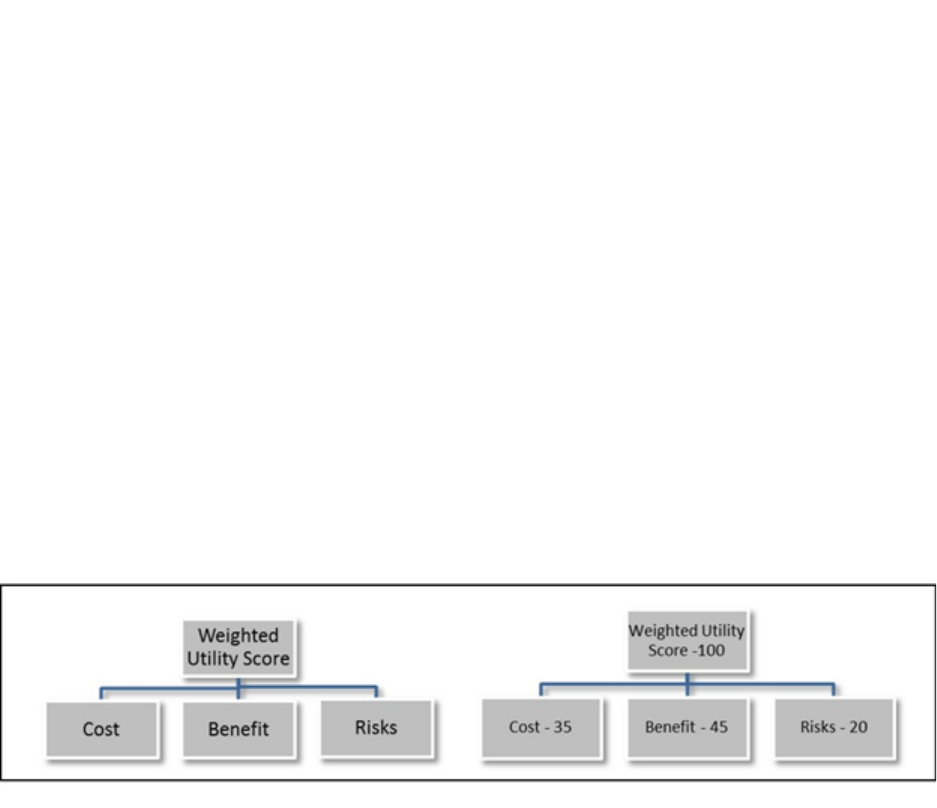
68 DAFPAM63-123 14 APRIL 2022
Chapter 8
DETERMINING EVALUATION FRAMEWORK, WEIGHTING, AND SCORING
8.1. Weighted Utility Score (WUS) and Multi-Objective Decision Analysis (MODA). The
preferred methodologies for evaluating COAs are the Weighted Utility Score (WUS) and the
Multi-Objective Decision Analysis (MODA). The two methodologies have similar steps but the
level of information, calculation of results, and displays of results differ. If an alternate method is
used, it should be fully documented and coordinated with the Executive IAP (refer to the Roles
and Responsibilities for the PS-BCA governance structure in Section 2).
8.2. COA Evaluation. This section addresses the approach for evaluating various COAs with
respect to the top-level categories of cost, benefit, and risks. The first requirement in using the
WUS framework is to give relative importance/value (weighting) between cost, benefit, and risks
and receive approval of the weighting from the Executive IAP. The relative balance in weighting
is used to frame the PS-BCA assessment of the various COAs. In a fiscally constrained
environment it cannot be “benefits/performance” at any cost or “lower cost” with inadequate
“benefits/performance.” The Executive IAP prevents the perception of gaming and safeguards the
integrity of the results by approving weighting before collecting data. The goal is to make the
COA assessments unbiased.
8.2.1. WUS. The WUS is a summation of the weighted top-level categories of cost, benefit
and risk, based on a 100-point scale. For the notional example below, the relative balance
(weighting) is: cost = 35, benefit = 45, and risks = 20.
Figure 8.1. Weighted Utility Score (WUS).
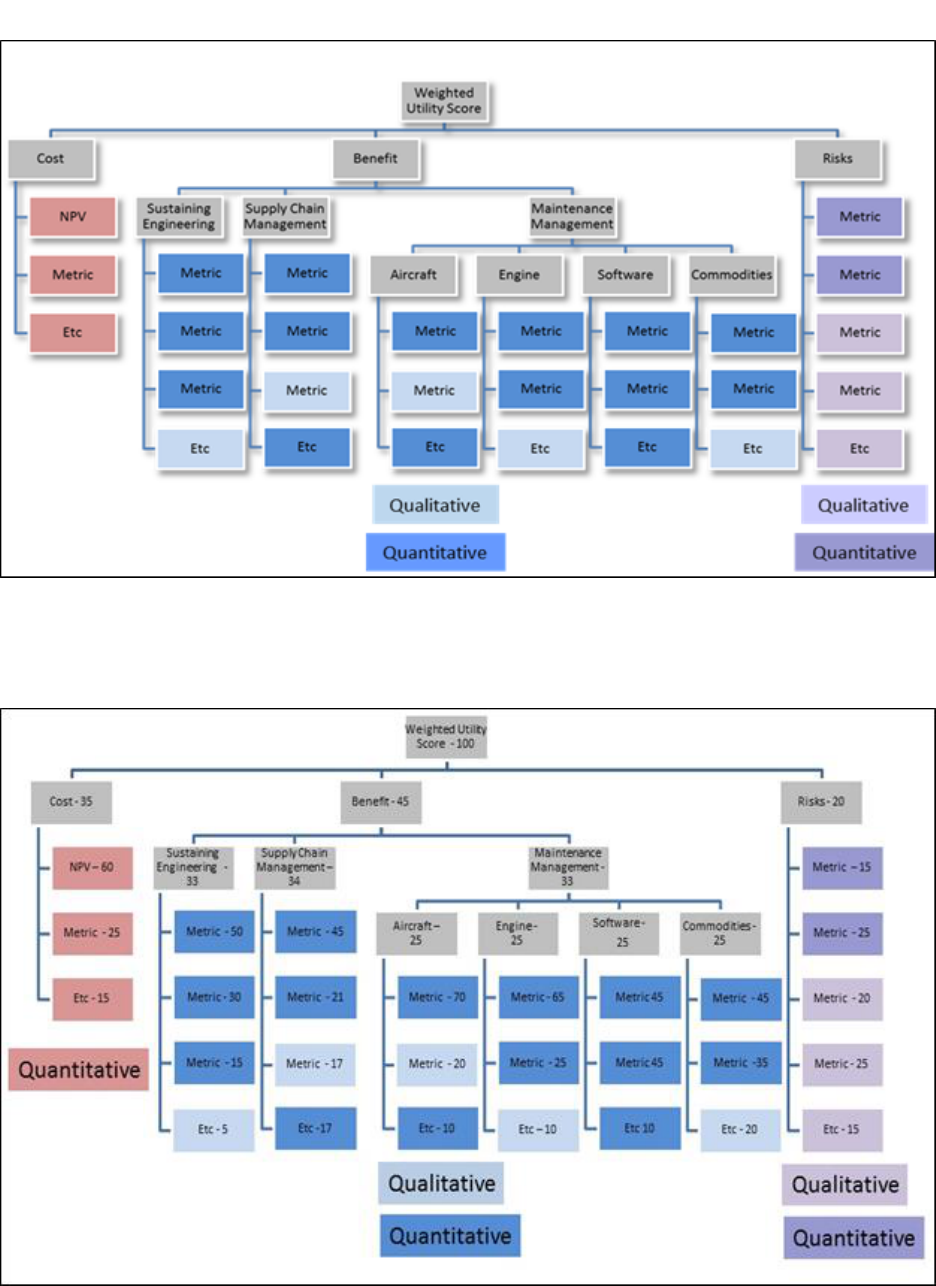
DAFPAM63-123 14 APRIL 2022 69
Figure 8.2. WUS Framework - No Weighting Assigned.
8.2.1.1. An example of the initial WUS framework with all the weightings assigned is
shown in
Figure 8.3. WUS Framework – Criteria Weighting (Notional Data).
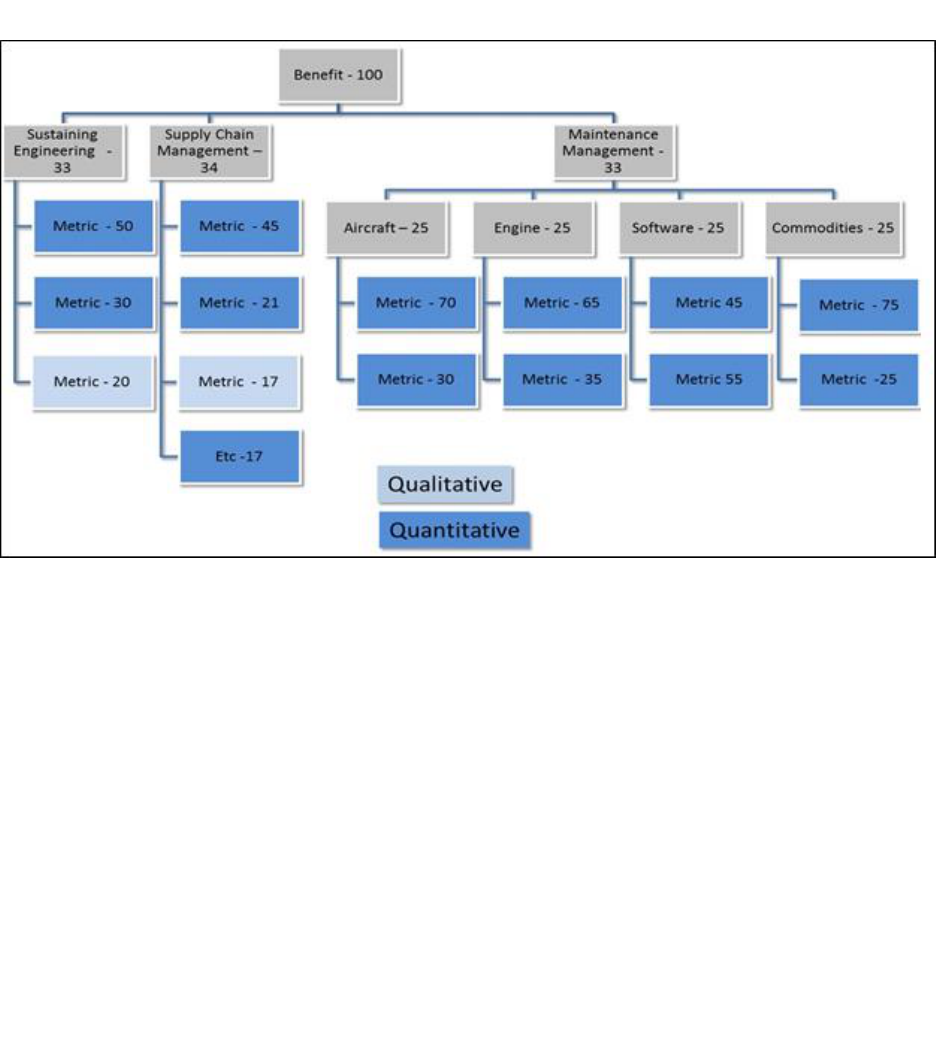
70 DAFPAM63-123 14 APRIL 2022
Figure 8.4. MODA Framework – Criteria Weighting (Notional Data).
8.2.1.2. When using the MODA framework, the benefits hierarchy focuses on benefits and
cost remains independent. The benefits hierarchy in MODA is different than the one in
WUS.
8.3. Steps to Build the WUS or MODA Framework. Identify sub-categories under each top-
level category for cost, benefit, and risks. If appropriate, include any additional sub-category
levels. In the example above, sub-categories under “Benefit” are SE, SCM, and Maintenance
Management. For the sub-category Maintenance Management, there are four additional sub-
categories (Aircraft, Engine, Software, Commodities).
8.3.1. Cost. Identify sub-categories under cost, however, they are not always required as
demonstrated in the above example.
8.3.2. Benefit. The sub-categories should be consistent with those defined in the scope for
IPS elements or grouping of IPS elements. For example, the benefits which may have been
identified are SE, SCM, and Depot Maintenance Management.
8.3.3. Risks. The sub-categories should match those identified in the previous Risks section.
Examples of the risk sub-categories are Transition (complexity, manpower, time, etc.),
Environmental (political), Compliance with 50-50 or core laws, Investment, etc.
8.3.3.1. Identify metric(s) to measure the last/lowest category (if no sub-category) or
last/lowest sub-category level.
8.3.3.2. After identifying the levels of sub-categories, determine the metrics that will
measure each category level. As each metric is identified, document the rationale for
selecting the metric for stakeholder/advisor understanding.

DAFPAM63-123 14 APRIL 2022 71
8.3.3.3. Although multiple cost metrics can be considered when determining the preferred
alternative, the cost analyses for the alternatives will be compared using dollars that have
been discounted to present value.
8.3.3.4. Questions that can assist in identifying metrics include:
8.3.3.4.1. Is the metric objective/quantitative or subjective/qualitative (Use
objective/quantitative when available)?
8.3.3.4.2. Is the metric a direct measurement or will it be a surrogate measurement?
8.3.3.4.3. Is the metric data auditable?
8.3.3.4.4. Is the metric consistent across all sources (OEM, organic, and 3rd Party)? If
not, what is the mitigation plan?
8.3.3.4.5. Is the metric a discriminator? For example, the result from a metric under
SCM sub-category will discriminate (which is better) between organic, OEM, or 3
rd
Party suppliers.
8.3.3.5. These metrics should be applicable to the “as-is” COA since the “as-is” COA is
the starting point for the PS-BCA. The metrics should effectively align with the mission
and contribute to meeting the PS requirements. It is important to exercise caution when
selecting a combination of metrics to ensure they are not redundant or counteractive. It is
recommended to use the SMART approach to measure metrics in the last/lowest sub-
categories.
8.3.3.5.1. S = Specific: The value of the metric should be clear to avoid
misinterpretation and it specifies the allowable range or threshold.
8.3.3.5.2. M = Measurable: The unit of measure is specified and tied to the underlying
data that allows for meaningful statistical analysis.
8.3.3.5.3. A = Attainable: For the “as-is” COA and the “to-be” COAs, the metric
should be achievable, reasonable, cost-effective, and credible.
8.3.3.5.4. R = Relevant: The metric should be valued to the program and “as-is” state
of the program’s PSS. This metric should already be tied to mission and PS-BCA
requirements and appropriate to a specific level of scope and responsibility.
8.3.3.5.5. T = Timely: The required data can be collected and analyzed within the
established time frame.
8.3.4. Determine Data Sources. Determine data sources for each metric and ensure all sources
have the same parameters and definition. For metrics, any difference in the parameters and
definition (i.e., differences between organic data collected and contractor data collected)
should have a mitigation plan before scoring or weighting. The data sources should be
documented with the rationale for each metric from above (See example for CWT below in the
section “Written Common Understanding and Frame of Reference”).
8.3.5. Determine weighting and scoring plan. As previously stated, only use the benefit sub-
category for weighting within the MODA framework.
8.3.5.1. The weighting and scoring plan should be developed by a select group of critical
experts (CEs). Any stakeholder or advisor who is a CE with a business interest in the PS-
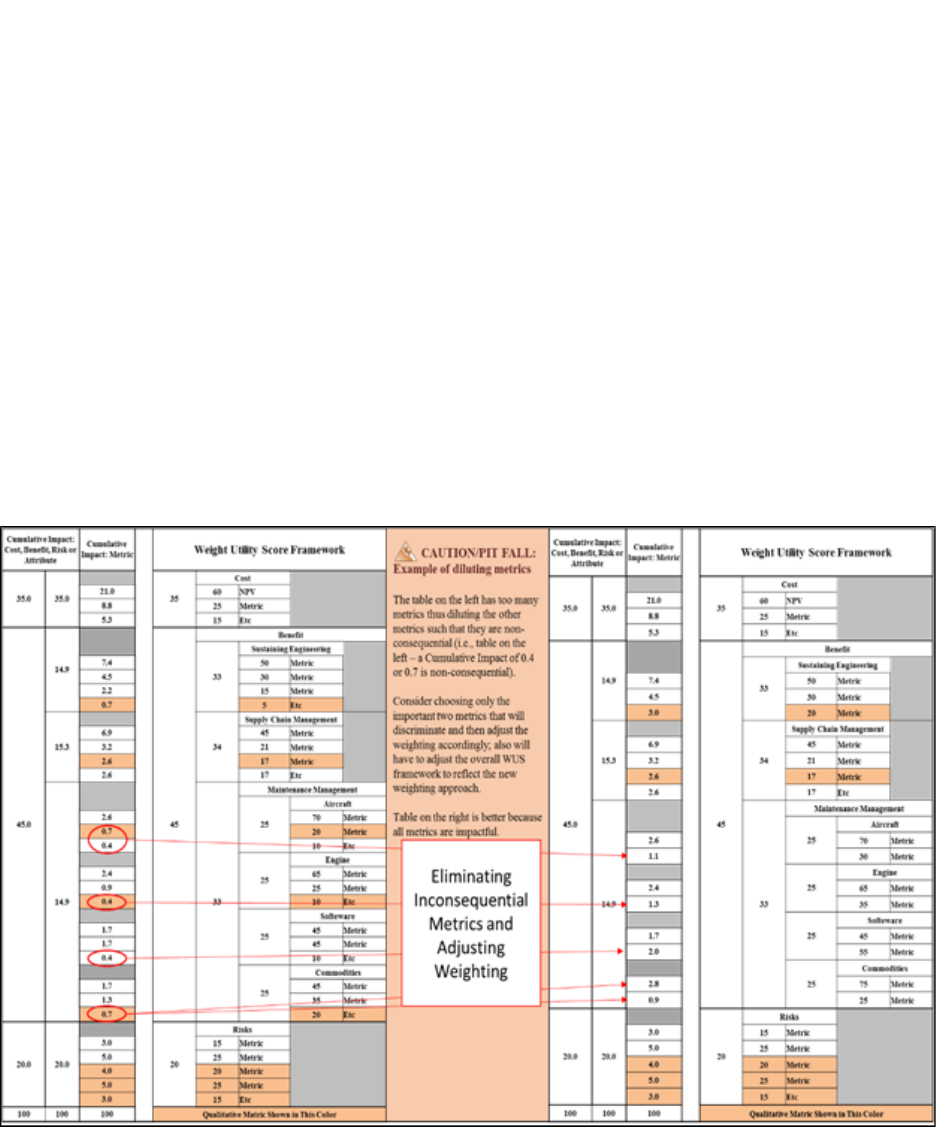
72 DAFPAM63-123 14 APRIL 2022
BCA result should not be included in the select group which determines the weighting and
scoring plan to prevent a product support provider conflict of interest or an organizational
conflict of interest. For MODA, only use the benefit sub-category for weighting.
8.3.5.2. The scoring and weighting methodology should be approved by the Executive
IAP. The scoring plan should be completed prior to data collection. It is recommended
that until the data is collected, the scoring and weighting methodology not be shared outside
the select group and the Executive IAP. Not sharing this methodology preserves the
integrity of data collection, weighting, and scoring processes.
8.3.5.3. Weighting Approach: The select group of CEs should begin to determine the
weighting values for each category, sub-category, and metric.
8.3.5.4. It is very important that for each sub-category/metric to ensure the cumulative
impact is appropriate as determined on WUS (especially if sub-category/metric is used
more than once).
8.3.5.5. In the Figure 8.5, the cumulative impacts are shown in the first three columns.
The weightings and metrics shown are examples only.
Figure 8.5. Cumulative Impacts of WUS.
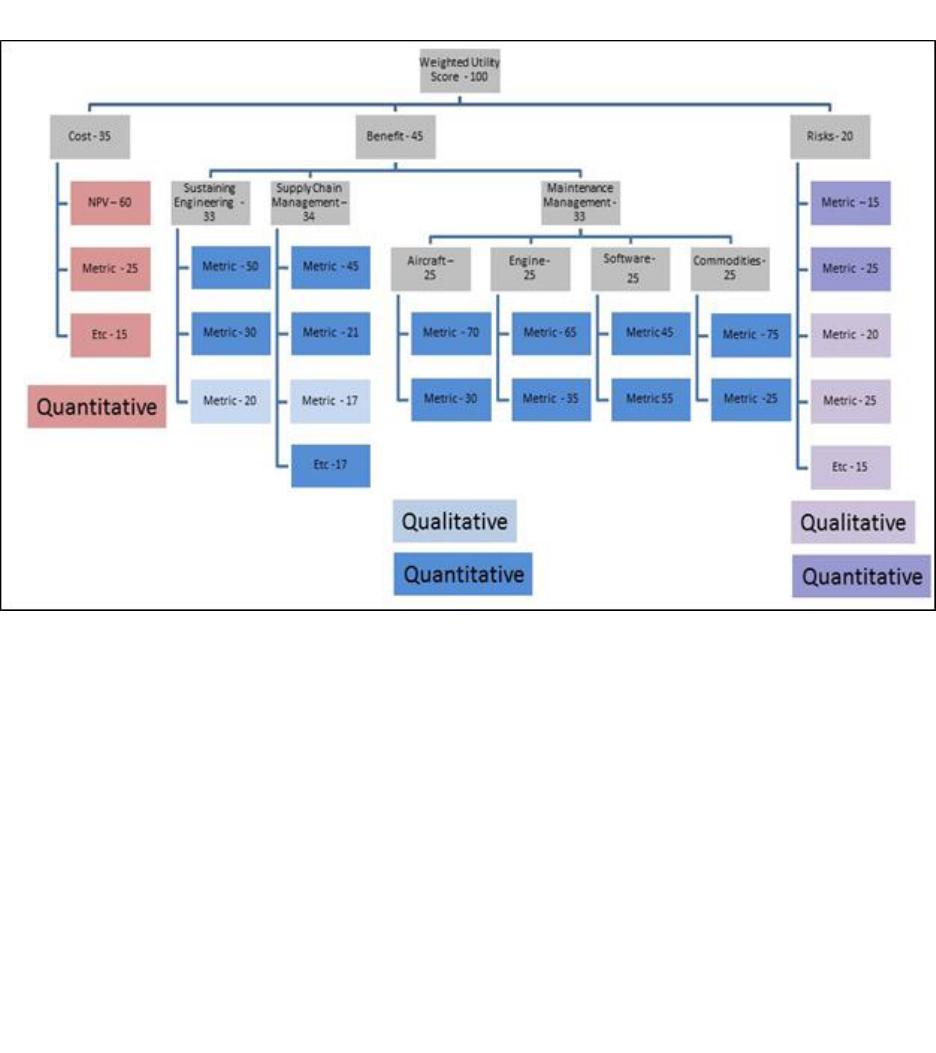
DAFPAM63-123 14 APRIL 2022 73
Figure 8.6. Updated WUS Framework.
8.3.6. Critical Expert Considerations. Based on the revised weighting, the updated WUS
framework for assessing cost, benefit, and risks. To prioritize the values for weighting across
sub-categories or metrics, CEs need to have a common understanding of reference for each
sub-category and metric. Below are some, but not all, considerations to be provided to the
CEs.
8.3.6.1. Written parameters and definitions for each sub-category and metric to be
weighted. The SMEs should understand any difference in the metric parameters and
definition (i.e., differences between the organic metric collected and the contractor metric)
and the mitigation plan to enable equity before scoring or weighting.
8.3.6.2. Example: CWT for the government is defined as the time between when the unit’s
request for a part was initiated to when the part was delivered to the unit. CWT for a
contractor may be defined as the time between when the contractor gets the request from
the government for the part to when it delivers the part to a port. In this example, the
parameters and definition for CWT is not the same. A mitigation plan is required before
using CWT as a sub-category or metric. The mitigation can be an actual correction or an
estimate correction, but if possible, an actual correction is preferred and should be weighted
more.
8.3.6.3. Whether the sub-category or metric is an objective/quantitative or
subjective/qualitative measure. Objective/quantitative is preferred.
8.3.6.4. Whether the sub-category or metric is a direct measurement or an indirect
measurement for the desired outcome. Direct measurement is preferred.

74 DAFPAM63-123 14 APRIL 2022
8.3.7. Additional Considerations. The following is a list, but not an all-inclusive list, of
additional considerations that needs addressing when using CEs to accomplish the weighting:
8.3.7.1. CEs’ inputs should only apply to their areas of expertise.
8.3.7.2. Retain the ability to identify each CE’s input for later sensitivity analysis.
8.3.7.3. Ensure equitable CE impact – one CE, or one organization CE group, should not
be able to independently influence results.
8.3.7.4. Ensure CEs are of an appropriate level and expertise (consideration of experience
and position).
8.3.8. Scoring Approach: After identifying the quantitative and qualitative categories and
metrics, the selected group of SMEs then determine the scoring plan for each category and
metric. Below are some examples of some common “how to” methods to score responses
mathematically.
8.3.9. Numerical Responses. Numerical responses are normalized using either the maximum
or minimum score across a metric. The following is how this scoring can be determined:
8.3.9.1. Highest Number is desired. The highest number for all the responses across all
the COAs receives the maximum points. The numbers for the remaining responses should
be scored by linear normalization to the highest number.
8.3.9.2. Lowest Number is desired. The lowest number for all the responses across all the
COAs receives maximum points. This approach should be adjusted accordingly if
averages of the numbers are used to determine the score.
8.3.9.3. Other Scoring. Any other scoring approaches used are explained for that metric.
8.3.9.4. “Yes” or “No” Responses. Where “Yes” response is desired. Scoring: “Yes”
answer receives all the points.
8.4. Displaying the Results – WUS and MODA (Cost Capability Analysis). Choosing how to
display the results is important. Some decision makers prefer seeing “numbers” (WUS), while
others prefer a more visual display (MODA) of the results, and yet others prefer seeing both
displays. Both methods are discussed in the following sub-sections.
8.4.1. Displaying WUS Results. When assessing the WUS results, one should understand what
a higher score represents. For example, take the Internal Rate of Return (IRR) and investment
cost metrics - a higher IRR is better, while a lower investment is better. Therefore, a higher
IRR and a low investment cost will each result in a higher WUS number/value, however, this
scoring method sometimes may be counter intuitive. To help understand the WUS
number/value for both cost and risk, these areas are also colored (high cost or high risk is
colored Red; medium cost or medium risk is colored Yellow; low cost or low risk is colored
Green). The “color coding” for each cost and risk is independently determined based on the
sub-categories and metrics for each area. Documenting the rationale for the color coding of
each area is required.
8.4.1.1. In the example, total WUS weighting for risk is 20. Using the risk cube framework
(Figure 8.7): High risk has a score of 4 or less, medium risk a score between greater than
4 and less than 10, and low risk has a score greater than equal to or greater than 10.
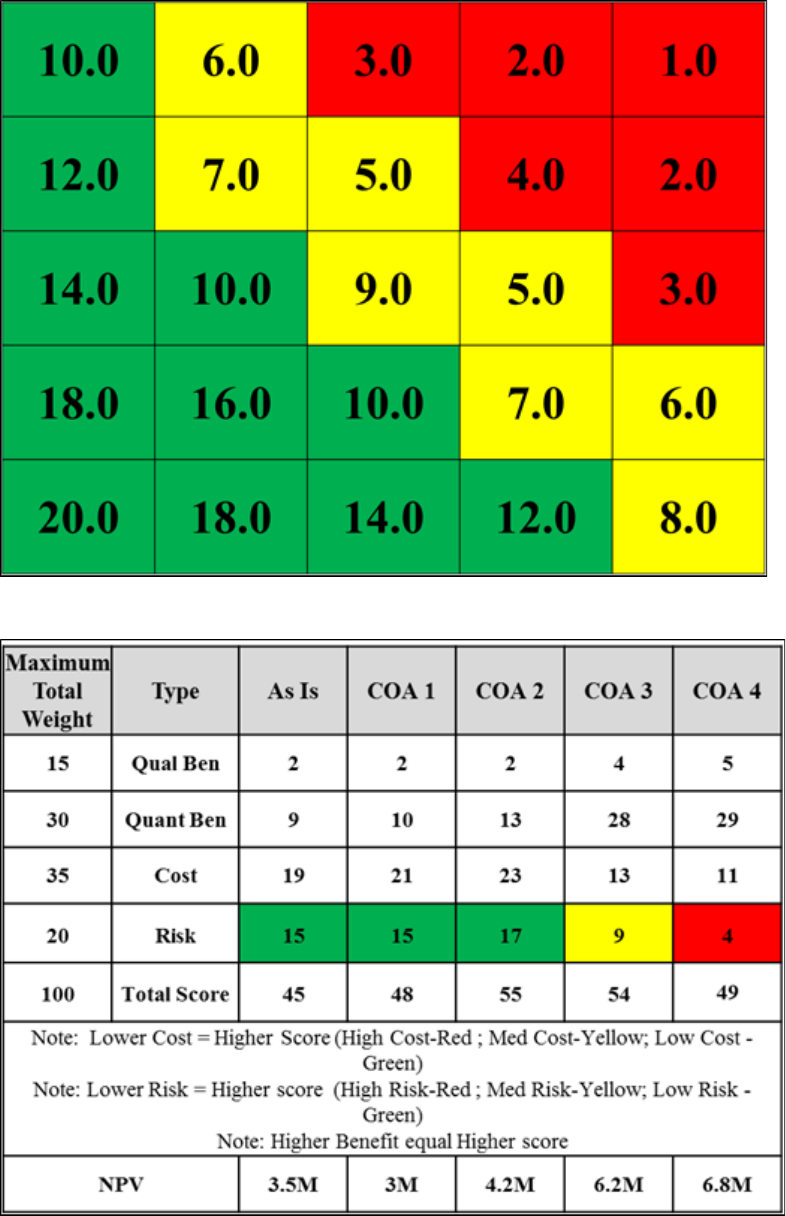
DAFPAM63-123 14 APRIL 2022 75
Figure 8.7. Risk Cube.
Figure 8.8. COA Weighting.
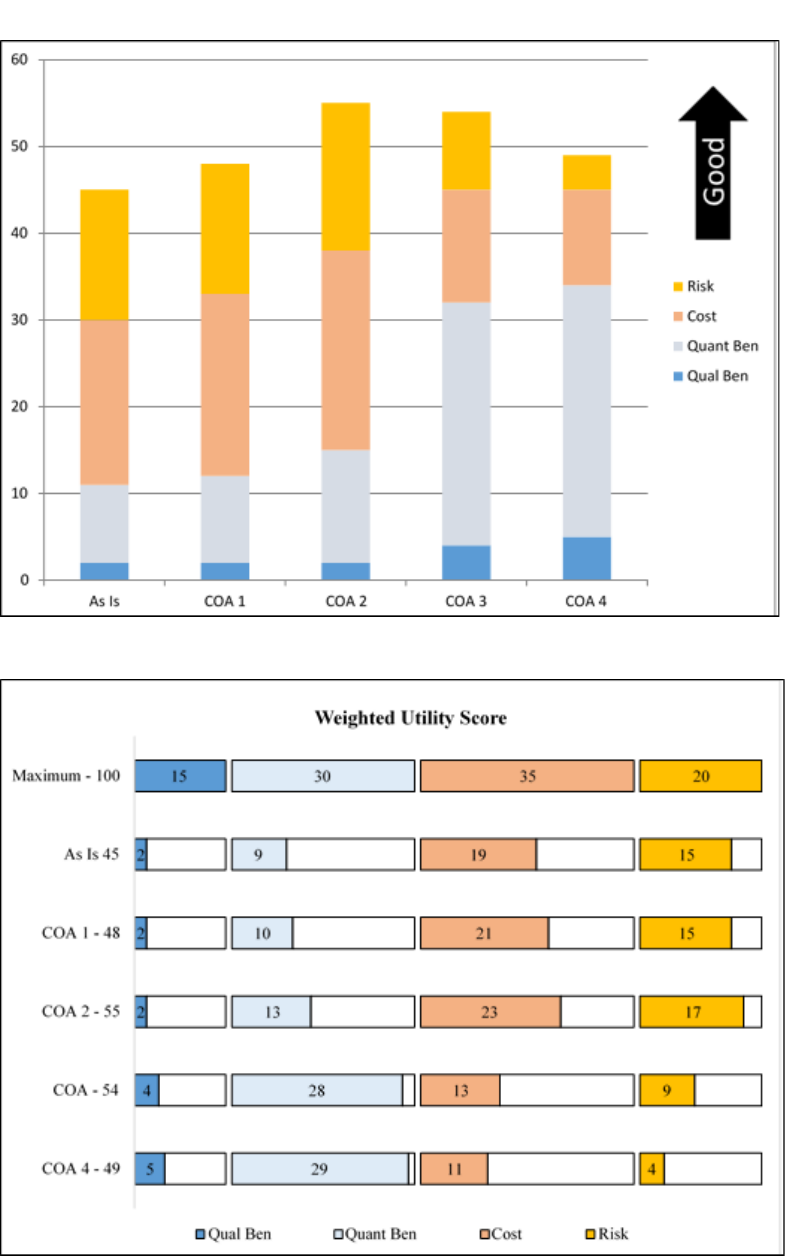
76 DAFPAM63-123 14 APRIL 2022
Figure 8.9. WUS Display (Example 1).
Figure 8.10. WUS Display (Example 2).

DAFPAM63-123 14 APRIL 2022 77
8.4.1.2. WUS Assessment.
8.4.1.2.1. Assessing the total score across the COAs, COA 2 and COA 3 have the
highest scores, 55 and 54 respectively. These values are almost the same, however, the
components (Cost, Benefit, Risks) of the score should also be assessed for the complete
context and understanding.
8.4.1.2.2. Assessing benefits between COA 2 and COA 3, COA 3 (WUS = 32) has
more than twice the benefits compared to COA 2 (WUS = 15); therefore, COA 3 is
better than COA 2 based on benefits.
8.4.1.2.3. Assessing the cost between COA 2 and COA 3, COA 2 (WUS = 23) scored
almost twice as high as COA 3 (WUS = 13); therefore, COA 2 is better than COA 3
based on cost. Also, COA 3’s NPV is $2M more than COA 2.
8.4.1.2.4. Assessing the risk between COA 2 and COA 3, COA 3 (WUS = 9) has
almost twice the risk score compared to COA 2 (WUS =17), therefore COA 2 is better
than COA 3 based on risk.
8.4.2. Displaying MODA Results.
8.4.2.1. When using MODA, benefits are plotted against the NPV rather than just against
the single cost of implementing a COA. Comparing benefits only to cost can be misleading
in determining best value. For example, COA 1 can have low one-time implementation
costs with high recurring costs with little savings over the life-cycle; while COA 2 can have
high one-time implementation costs with lower recurring costs and high savings over the
life-cycle.
8.4.2.2. Converting WUS benefits for MODA graphing. In the example, the total WUS
weighting for benefits is 45 (Qualitative plus Quantitative). Therefore, for each COA the
associated WUS benefit score is converted to a total benefit scale of 100 point resulting in:
COA 1 = 26.7, As Is= 24.4, COA 2 = 33.3, COA 3 =71.1, and COA 4 = 75.6. Each COA
is plotted where the benefit score is on the Y-axis and the NPV is on the X-axis. The risk
color for each COA is then overlaid on the graph. Using the NPV for the COAs takes these
costs and savings into consideration. Thus, plotting benefits against NPV for each COA
and then overlaying risk for each COA helps decision makers determine which COA is the
best value. In the example, for each COA the benefits are given a weighted score and then
plotted against NPV. The risk is color coded and displayed. The size of the risk area shown
is directly related the WUS for risk.
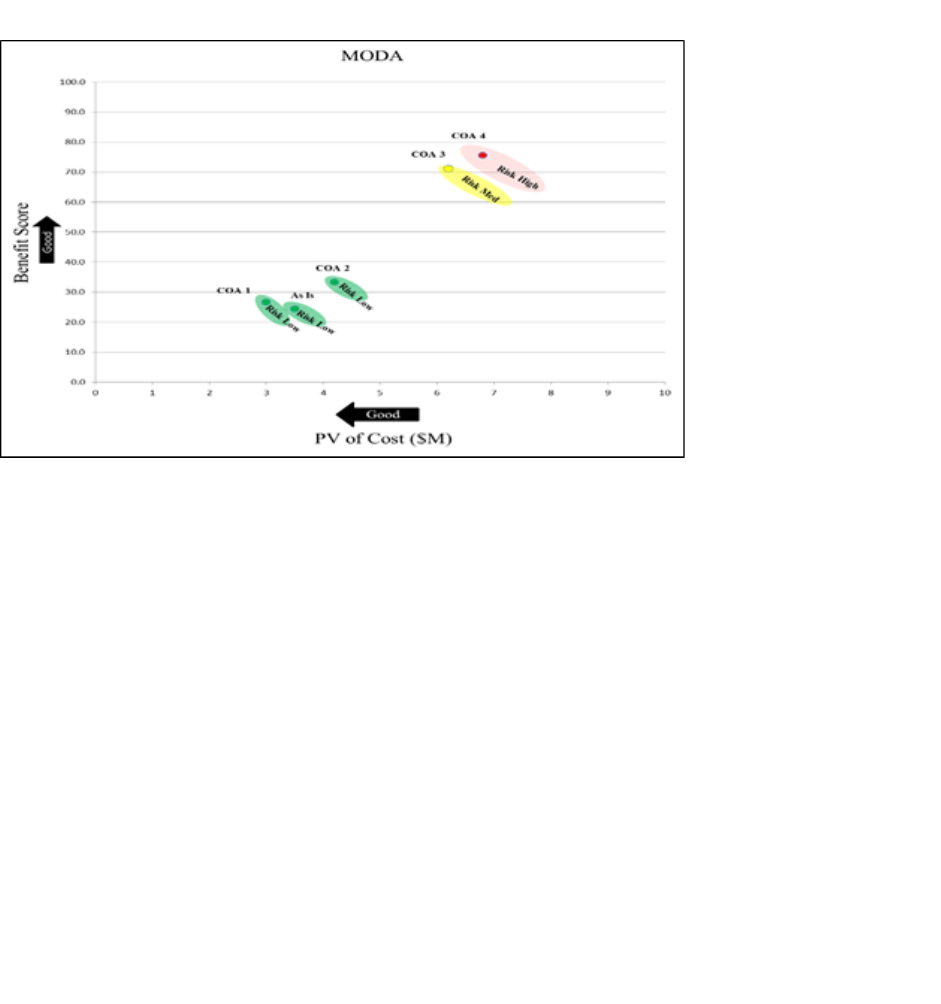
78 DAFPAM63-123 14 APRIL 2022
Figure 8.11. MODA.
8.4.2.3. Both COA 3 and COA 4 have higher benefits (over twice the benefit score
compared to the other COAs). COA 3 has medium risk while COA 4 has high risk.
8.4.2.4. COA 1, COA 2, and “as-is” have low risks and lower benefits.
8.4.3. Both the WUS and MODA Overall Assessment. The tradeoff for the decision maker
between COA 2 and COA 3 is what is more important: Higher benefits or lower cost and/or
lower risk. If high benefits is the most important and the medium risk is acceptable, then COA
3 is the better COA. If lower costs and/or lower risk are more important, then COA 2 is the
better COA. The decision makers conducts the tradeoff evaluation and selects the better COA
accordingly.
8.4.4. Summary of Key Points.
8.4.4.1. As each sub-category and metric is identified, document the rationale for its
selection.
8.4.4.2. Ensure that for each sub-category/metric, the cumulative impact is appropriate as
determined (especially if a sub-category/metric is used more than once).
8.4.4.3. In order to prioritize the values for weighting across sub-category or metrics,
SMEs need to have a common understanding and frame of reference for each sub-category
and metric. Therefore, provide written documentation to the SMEs.
8.4.4.4. Display the results in a clear format that can be easily understood by decision
makers.

DAFPAM63-123 14 APRIL 2022 79
Chapter 9
DATA SELECTION, COLLECTION AND ASSESSMENT
9.1. Quality Data Collection. Within the PS-BCA process, quality data collection is often one
of the most difficult and time consuming activities. In order to perform a quality PS-BCA, the PS-
BCA IPT should clearly understand what data is required and ensure it is available and acceptable
to support the analysis. Even though a program may technically comply with various DoD
Instruction and other sustainment cost reporting requirements, the data collected may not be of
sufficient fidelity to effectively accomplish a cost estimate. Therefore, before any data is collected,
the PMO should document, in a data collection and management plan (data plan), how the team
will locate, collect, verify, and use data to ensure the data is collected at a sufficient level for
effective use in the PS-BCA. The data plan should focus on strategy early in the acquisition
lifecycle. This information is important because it helps the PMO to determine what data is
required for future analysis (e.g., BCAs) and long-term sustainment. This should also assist the
program office in determining which data rights to include in future contracts. The data collection
should include quantitative and qualitative data to support benefit, cost, and risk analyses. The
resulting data plan should be coordinated through the IAP structure to ensure reasonable
expectations are agreed upon by all stakeholders and advisors. PMO should ensure proper
agreements are in place not only for data, but to include acceptable delivery per PMO
requirements.
9.2. Data Selection. For the purposes of the PS-BCA, data selection is defined as the process of
determining the appropriate data type and source to support the analysis. There are two key
components of the data selection process: 1) identification of data requirements and 2) quality
assessment of potential data sources.
9.2.1. Identification of Data Requirements. The first step in developing the data plan is
identifying potential data requirements (both financial and non-financial). The product support
framework, documented in the LCSP, should be the basis for the PS-BCA and data
requirement. During MS-A/B in the life cycle, the intent of the PS-BCA is more closely tied
to creating the initial product support framework and identifying potential data requirements
such as technical data and data rights that will support a more detailed PS-BCA later in the life
cycle. However, for MS-C and beyond, data is more detailed and system specific, and is
collectively agreed to be the most applicable and representative data to support the PS-BCA as
further discussed in the following sections.
Table 9.1. Milestone Data Maturity.
Data Prior to MS-B
Prior to MS-B, the program office ensures the information and data
needed is being captured and be delivered to the government by the
developing contractors.
Data Between MS-B
and MS-C
Between MS-B and MS-C, the program office use the COAs for the
PSS, the proposed methodology, and the delivery of information and
data developed and determined prior to MS-B.
Data Post MS-C
Once MS-C is reached, the program office should have actual data and
the focus should be on identifying any new, updated, and/or changed
data.

80 DAFPAM63-123 14 APRIL 2022
9.2.1.1. The data collected for the PS-BCA will usually be a direct reflection of the
platform maturity but should be reviewed periodically throughout the life cycle to ensure
the data being collected supports the objectives of the PS-BCA. As the system matures,
platform specific data should become more readily available. When completing a PS-BCA
early in the platform lifecycle, specific platform data may not be available. During this
time in the lifecycle, it is an accepted practice to use data from an analogous platform (see
“Using Data from Analogous Systems” tip below). However, when available, more
detailed cost data provides more confidence in the distinctions between COAs resulting in
a higher quality cost estimate. Too often, cost data from the contractor is collected at such
a high level it cannot be used effectively in completing an estimate without major concerns.
For example, in order to accurately estimate the SE cost for a new airframe, one needs
more detailed cost information than the total SE cost for the entire antecedent platform.
Without the break out of specific cost for SE for the airframe, engines, and Depot Level
Repairables (DLRs), a cost analyst has to make what could be a faulty assumption in an
attempt to allocate the specific cost to the airframe. The team should consider using
systems which have a predominately organic sustainment strategy as analogous data points.
9.2.1.2. If contractor data is required, the PSM works closely with cost analysts,
logisticians, and contracting officers to ensure the proper data is contracted for and
executed from the beginning of the life cycle of the program. The PMO should plan to
acquire government rights and the delivery of technical data as required by 10 USC § 2320.
However, if a platform is in the sustainment phase and is being supported by a CLS contract
worth $50M or more (and software efforts greater than $20M), the PMO needs to complete
a comprehensive Cost & Software Data Report (CSDR) plan package in accordance with
DoDI 5000.02. The data collected from the CSDR can then be used as a baseline for the
revalidation or for another study. In addition, tailoring the CSDR allows information to be
collected in a specific area of interest (e.g., airframe SE), giving analysts a quality starting
point to begin an estimate.
9.2.1.3. As data is collected, the PMO executes a cohesive plan for archiving and
efficiently providing the data as appropriate to the various stakeholders/advisors. All
parties should understand how the data choices impact the PS-BCA problem statement.
Not collecting the correct functional and cost data reduces the effectiveness of the PS-BCA
and hinders, delays, or inhibits future decision making efforts. Therefore, having a plan
and a sustained commitment in place to collect the most accurate and useable data as it
becomes available should make the current PS-BCA, and all subsequent PS-BCAs, more
informative and accurate while also minimizing uncertainty or risk.
9.2.1.3.1. The questions listed below can aid the PS-BCA IPT identify potential data
requirements to support the analysis:
9.2.1.3.2. What is the problem statement? What data is needed to properly evaluate
the problem statement?
9.2.1.3.3. What metrics are proposed to support the benefits evaluation? What type of
metric data is needed to support the evaluation of this metric?
9.2.1.3.4. What are the differentiators across the COAs selected? What level of
information/data is needed to effectively evaluate those differences? For example, if
the COA set considers organic versus contractor SCM, what type of data is needed to

DAFPAM63-123 14 APRIL 2022 81
evaluate the different cost, benefit or risks associated with the different product support
providers?
9.2.1.3.5. Are the proposed data elements easily applied across all potential product
support providers (i.e. organic or contractor providers)?
9.2.1.3.6. What are the program’s data rights and/or ease of access to data?
9.2.1.3.7. When will the data be generated? What level of data is needed to
differentiate across the COAs?
9.2.1.3.8. Is there a mitigation plan if the data is unavailable?
9.2.1.4. Quality Assessment of Potential Data Sources. The next step is examining
potential data sources and assessing the quality of the proposed data. The term “quality
data” is defined as data that achieves its purpose or use. Attributes of quality data include
accuracy, precision, completeness, consistency, timeliness, and authority. Table 9.2 and
Table 9.3 below outline the data quality tiers, along with potential PS-BCA data sources
which include corresponding tiers.
Table 9.2. Data Quality Tiers.
Tier 1:
DoD/AF Level
Authoritative Data
Tier 2:
Program or Other
Government Data
Tier 3:
Contractor Data
Tier 4:
SME Survey Data
Data from recognized
authoritative data
base
Typically collected
and tracked across
multiple weapon
systems/programs
Data has been
generated, validated
and used to support
other program level
decisions
Typically collected
and tracked only for
weapon system
program being
assessed
Data has been
validated and/or used
to support other
program level
decisions
Typically collected
and tracked only for
weapon system
program being
assessed
Typically used for
qualitative data
Table 9.3. Potential PS-BCA Data Sources.
Data Source
Tier
Types of Data
When to use?
Location of Data
(Link, POC, etc.)
Logistics
Installations and
Mission Support
- Enterprise
View (LIMS-
EV)
1
Contains historical
logistics data
Can be used in a
Benefits or Risk
analysis
Air Force Total
Ownership Cost
(AFTOC)
1
Contains historical
cost and logistics
data
1. Costing out
Depot Level
Repairables
https://aftoc.hill.af.mil/

82 DAFPAM63-123 14 APRIL 2022
2. Can be a starting
point for all CAIG
elements
smxg.aftoc.helpdesk@u
s.af.mil
Reliability &
Maintainability
Information
System
(REMIS)
1
Information on
system reliability
1. Extrapolation or
comparative
analysis
2. Cost estimate
Applicable Air Logistics
Center or Depot
Joint Deficiency
Reporting
System (JDRS)
1
Information on
material deficiency
history
Cost estimate
http://www.jdrs.mil
Life Cycle
Sustainment
Plan (LCSP)
2
Sustainment plan
and standard
Cost estimate,
defining baseline
Applicable program
office or PSM
Cost Analysis
Requirements
Description
(CARD)
2
Information on
previous cost
estimates and
decision making
Cost estimate,
defining baseline
Program office,
Command FMCE or
SAF/FMCE
Condemnation
Expense
Material
Recovery
(CEMR)
2
Rate for Organic
Supply Chain costs
Cost estimate,
defining baseline
AFSC/FM
Unit Manning
Document
(UMD)
2
Information on
organic manpower
Cost estimate
Command Manpower
Business
Overhead Cost
Recovery
(BOCR)
2
Information on
overhead cost
Cost estimate
AFSC/FM
Manpower
Estimate Report
(MER)
2
Information on
total manpower
needed to operate,
maintain and
support
Cost estimate
Command Manpower
Contractor
CDRLs
3
Potential input to
benefits, cost and/or
risk assessments
Internal Program Office
Documentation
SME Input
4
May be used to
support assessment
of qualitative data
Should only be
used if other data
sources not
available to support
assessment and
should only be used
in qualitative
metrics
SME
Survey/Questionnaire
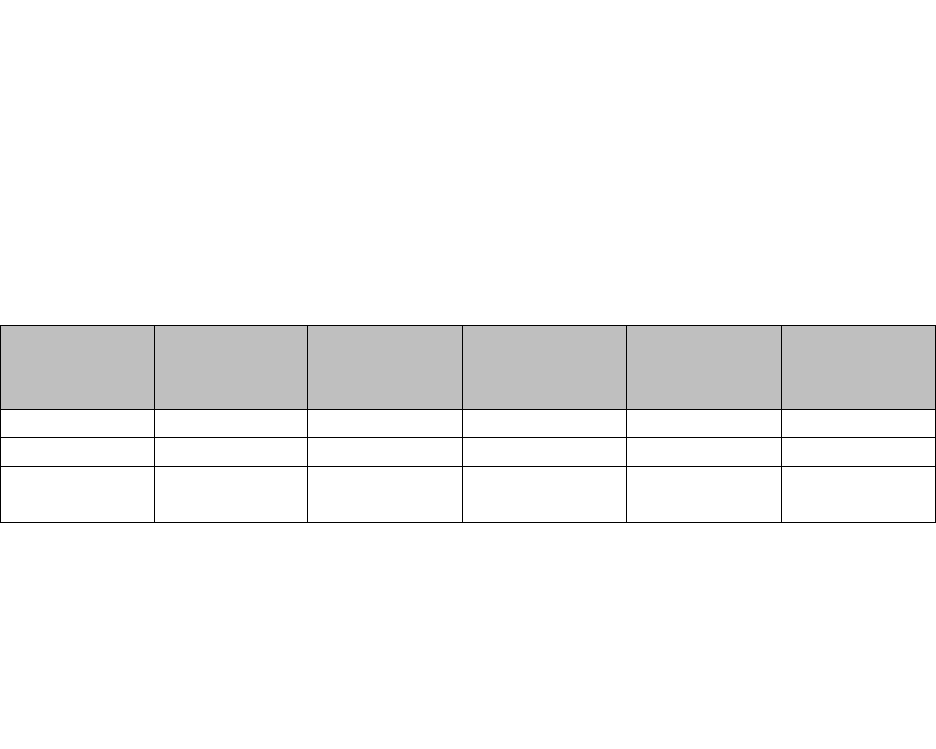
DAFPAM63-123 14 APRIL 2022 83
9.2.1.5. Additional considerations regarding data sources:
9.2.1.5.1. To the maximum extent possible, the authoritative data source should be
accurate and reliable. Manage expectations of desirable data sources to ensure
accuracy, consistency, timeliness, availability, and relevance.
9.2.1.5.2. Make efforts to only use non-proprietary data in a PS-BCA so subsequent
iterations of the PS-BCA can be accomplished or updated.
9.2.1.5.3. Interim Contract Support can be written to collect data which may then be
used for sourcing decisions and costing out Contract Logistics Support
9.2.1.5.4. At the end of the data selection process, the PS-BCA IPT should have a list
of the required data, an identified source, and documented rationale as to why that data
element was selected. Table 9.4 below provides an example format to capture this
information. The PS-BCA IPT should complete a separate table for cost, benefit, and
risks data.
Table 9.4. Example – Data Requirements and Selection.
Data element
(e.g. WBS or
IPSE)
Data Source
POC/Office
Organizational
POC
Level of Data
Quality/Tier
Reason
Source was
Selected
9.2.1.6. Data Collection. Once the necessary data has been identified, the PS-BCA IPT
develops the data collection procedures, collection schedule, entry documentation, data
protection, data access/storage, and mitigation plan if the data is unavailable. Having a
documented data plan is mandatory and is key to ensuring all PS-BCA players have the
appropriate access to data and information. When documenting sources, include the data
source, vendor, point of contact, and the date the data was obtained. Open source data
obtained from the internet should include the website address, product/report number,
contract number (if available), and CDRL (if available).

84 DAFPAM63-123 14 APRIL 2022
Table 9.5. Data Plan Considerations.
Data Plan Areas
Considerations
Data Collection
Establish rules of engagement for collecting data.
Identify who, within the PMO, will be responsible for requesting, collection
and distributing data. It is recommended that this be a single person within
the PMO responsible for the PS-BCA. This individual should be a
government employee, not a support contractor.
Identify entry/exit points for data requests within supporting
stakeholder/advisor organizations (e.g., MAJCOM POCs, Contractors,
AFSC).
If the data is pulled from an automated system, decide who is going to
validate the data pulls. Also, consider what criteria will be used for QA,
validation, etc.
Determine how non-availability of data will be addressed and how issues
will be mitigated.
Decide if data will be provided in hard copy or electronically. If
electronically, will it be in Excel or PDF? MS Office is highly
recommended not only for PMO and analytical purposes, but also for
higher level agency review and oversight.
Determine if a data call is required. It is recommended that a formal request
for data come from the senior decision maker to emphasize the importance
of timely support.
Periodically assess the data being delivered/collected supports upcoming
PS-BCAs
Note: Each functional organization providing data is responsible for the
accuracy and completeness of the data (e.g., 448 SCMW for supply chain
data, AFSC/LG for workload information, AFSC/FZ for organic rates and
cost data, and Defense Contract Audit Agency or Defense Contract
Management Agency for contract cost data).
Collection
Schedule
Determine dates the data is required to support the PS-BCA schedule.
Establish suspense dates for the data requested.
Identify what actions should occur if suspense date is not met.
What levels should this be elevated to in order to resolve missed suspense
dates?
What mitigating actions should be taken to keep the PS-BCA on schedule?
Entry
Documentation
Determine who will be responsible for documentation of data.
Determine how data will be documented:
Date Received/Retrieved
Query Parameters Utilized (if pulled from automated system)
Format Received (hardcopy, electronic, etc.)
Data Storage (SharePoint, etc.)?

DAFPAM63-123 14 APRIL 2022 85
Data Plan Areas
Considerations
Data Protection
Identify any non-disclosure, security issues.
Determine if special access or permission is required before the data is
released.
Data
Storage/Access
Determine if the data will be accessed via a web system, MS Excel, or other
means.
Determine if the data needs to be available to everyone on the PS-BCA IPT.
If not, document the rationale for any exclusion.
9.2.1.7. Provided below are common mistakes that occur in the data collection process:
Failure to be specific when requesting data or misunderstanding of data requirements
regarding the information to be collected.
Ignoring data used in previous estimates (when it applies).
Not using data from preferred or best available sources (i.e. AF or DoD derived data)
when available.
Using manufacturer data that may represent a base case scenario.
Not clearly stating the source and date of the data.
Not presenting data in a format that can be analyzed/recreated by an independent
reviewer.
9.2.2. Data Assessment. Once collected, the team needs to review the data since flawed data
can jeopardize the quality of the PS-BCA. The data received may be different than what was
expected. For example, collecting the actual incurred cost to sustain the platform may provide
better cost visibility for estimating purposes than a negotiated contract cost, although both may
be referred to as ‘actual cost data.’ Therefore, the analyst may need to consider additional data
sources if the data does not meet expectations. Some common errors with data include.
Unexplained gaps (e.g., missing periods of time).
Insufficient data points (e.g., limited use or recording of data).
Limited sample size (i.e., if the data collected was based on a sample).
9.2.2.1. However, before discarding a data source, the analyst should confer with
stakeholders/advisors to determine if a logical explanation exists for the flaw or anomaly
in the data.
9.2.2.2. Once the data is validated by the IPT, the analyst needs to determine if the data
can be used as is or if some adjustment is needed to normalize the data. If normalization
or manipulation is required, an explanation needs to be added to the documentation. For
example, contractor data may be grouped by month or quarter and then averaged, while
organic data may not be modified and is collected in real-time.
9.2.2.3. When completing a PS-BCA early in the lifecycle, specific data may not be
available. During this time in the life-cycle, it is a generally accepted practice to use data
from an analogous platform. However, analogous data is often misused in the following
ways.
An analogy is used that is not representative of the target PSS.
Assumptions are made that cannot be proven with data.

86 DAFPAM63-123 14 APRIL 2022
Incomplete data is used that does not account for all the relevant cost associated with the
COAs.
9.2.2.4. These missteps are often the result of either not having better data on hand or there
is a limited understanding on what the data represents. For new platforms, early in the life-
cycle (MS-A/B), there may not be enough reliable (platform specific) data to accurately
model or forecast future cost, so analogous estimating is acceptable. For new systems with
no clear antecedent platform, the PS-BCA team needs to have even more fidelity to
complete a quality estimate. New systems may need analyzing at the part level to identify
like-and-similar parts which can be effective in projecting the PS-BCA estimate.
9.2.2.5. In this case, it is expected that an analogous platform would be used to gather the
necessary data to complete the PS-BCA estimate. However, the data choices and how they
are applied determine the quality of the estimate. There should be a reasonable and logical
correlation between the analogous system and the targeted system under study as identified
by the PS-BCA team and associated SMEs. Those systems should also be documented in
a manner that demonstrates why the systems are analogous. It should include the rationale
for why the analogy was chosen and why it best supports a particular PS-BCA element. It
is also vital that the data collected from the analogous program be complete and normalized
to a targeted metric that will be used consistently throughout the entire analysis. This
allows for a fair comparison of data sources that can be used to make more accurate
projections. Here are some rules of thumb to keep in mind when using an analogy.
9.2.2.5.1. Is the analogy being applied in a logical and sensible way?
9.2.2.5.1.1. Effective: Using the engine reliability data from Platform A (a turbo
fan engine maintained organically), to predict the engine reliability for Platform B
(which is also a turbo fan engine maintained by a contractor). Both Platforms have
similar engines in size, parts, and capabilities and are overhauled at similar
scheduled time intervals.
9.2.2.5.1.2. Problematic: Using supply chain cost data from Platform A
(contractor), which has different PSS content than Platform B (contractor), because
they have similar engines.
9.2.2.5.2. What to do if an analogous platform is not available for the system under
study, which is common in the Space community?
9.2.2.5.2.1. Effective: Using an established supply chain and sustainment strategy
construct for Platform A that is similar to the targeted supply chain and sustainment
strategy for Platform B. Although the platform may not be an analogous hardware
solution, a successful analogy can still be applied in other creative ways to help
estimate other key elements of the PS-BCA.
9.2.2.5.2.2. Effective: Dividing the system to the part level and then looking for
existing parts that are similar while adjusting for complexity.
9.2.2.6. This approach is only as effective as the cost and technical data collected for the
programs to be utilized in the estimate. Thus, it is important that each platform is properly
documented throughout the entire lifecycle. For example, documenting the growth of the
software maintenance, along with the systems, capabilities, and cost associated with the

DAFPAM63-123 14 APRIL 2022 87
platform would help ensure estimates better project software maintenance cost for the next
generation warfighter or to satisfy the revalidation requirement of the support strategy or
for use in a PS-BCA for a follow-on weapon system. The subjective nature of analogous
estimating drives risk into the estimate. The PS-BCA team should expect to update this
type of estimate with platform specific data in future PS-BCAs.
9.2.2.7. If the data requires special protection (e.g. classified or proprietary), the PS-BCA
team may need to obtain Non-Disclosure Agreements prior to starting the data collection
process. Once data is collected, the team needs to review the quality and quantity of the
data. Data that is not representative of the targeted platform has the potential to jeopardize
the quality of the PS-BCA. The team needs to understand how the data was compiled and
whether there are any known limitations.

88 DAFPAM63-123 14 APRIL 2022
Chapter 10
SENSITIVITY ANALYSIS AND EVALUATION
10.1. Sensitivity Analysis Defined. Estimates of costs and benefits contain uncertainties. Since
estimating errors can be introduced into the analysis because of the uncertainty, the potential
impact of these errors must be analyzed. A sensitivity analysis assesses the extent to which COA
costs and benefits are sensitive to changes in GR&As and data. Every comparative analysis must
have a separate sensitivity analysis (AFMAN 65-506, Paragraph 6.1.2.3).
10.2. Risk and Uncertainty. Risk and uncertainty cannot be avoided because the future is
unknown. While we may have a belief or opinion of what the future value of a variable (i.e.,
assumption, data item) may be, we don’t know for sure, even if our opinion is based on data and
analysis. Therefore, it is necessary to identify how “sensitive” the different COAs are to changes
in GR&As and data. In the case of a PS-BCA, a sensitivity analysis attempts to isolate the effect
of changing a variable’s value across all COAs. Sensitivity analyses should be performed one
variable at a time to see which variables drive large changes in cost and benefits. While adjusting
multiple variables can be done to see their combined effects, this is generally referred to as scenario
analysis rather than sensitivity analysis.
10.3. Variables. A sensitivity analysis is performed for each COA to determine cost and benefit
behavior over the range of key variables’ possible values. Some variables may be GR&As,
weights, or data items. The variables chosen for sensitivity analysis are usually those that are
thought to be cost drivers and those whose values are the most uncertain. In a sensitivity analysis,
the effect of varying the value of only one variable is analyzed at a time. A sensitivity analysis
demonstrates how strong or robust a recommended COA is. A recommendation is said to be strong
or robust if it does not change over the wide range of a variable’s possible values. A sensitivity
analysis may yield one or several cost “cross-over” or “breakeven” points, but a “breakeven
analysis” is not sufficient to be called a sensitivity analysis. A sensitivity analysis is not sufficient
to quantify cost risk.
10.4. Steps in Conducting a Sensitivity Analysis.
10.4.1. Identify the Key Variables to Test. Key variables could be ground rules, assumptions,
benefits rankings/weightings, cost drivers, risks, programmatic objectives, and raw
data/scores. It is also important to address known politically sensitive assumptions and issues.
10.4.1.1. Rankings and weightings can be independent in a PS-BCA. The ranking can be
the order of the benefits in terms of importance, whereas the weighting can be the percent
(%) weight given the benefits in relation to cost and risk.
10.4.2. Perform a Sensitivity Analysis on a Selected Variable (Note: this step should be
repeated for each variable). This step uses two approaches and each approach provides
different information. The first approach, called “graduated” sensitivity analysis, is to vary the
value of the variable and record the results (i.e., output) of the model. This provides insight to
the COA’s cost behavior over the broad range of a variable’s possible values. The second
approach, called “break-even” analysis, identifies the point(s) at which the order of the COAs
change. In other words, this analysis looks at how much each variable can change before there
is a change in the ranking of COAs. Both approaches are valuable to the analysis and provide
the MDA important information.

DAFPAM63-123 14 APRIL 2022 89
10.4.3. Document the Process and the Results. The methodology needs to be documented in
enough detail to enable a reader to replicate the analysis. The analyzed variable, the way it
was varied during the analysis, and the changes to the model’s results (i.e., cost and benefits)
as the value changed should be documented. Document results in the most understandable
format (e.g., table, graph, bar chart, pie chart, etc.). That is, the format in which the results are
presented should clearly convey the “big picture” and the implications for costs, benefits, and
risks.
10.4.4. Repeat. Repeat steps 10.4.2 and 10.4.3 until all key variables identified in Step 10.4.1
have been tested independently.
10.4.5. Evaluate the Results. Sensitivity analysis provides decision makers with a better
understanding of what drives change in costs, benefits, and risks. It can provide information
that can lead to choosing a different COA from that based solely on initial results. If minor
changes in a variable’s value change the recommended COA, the PS-BCA should describe the
circumstances under which the various COAs would be recommended, as well as the
recommended alterative under different objectives (e.g., minimize cost, minimize risk, and
maximize benefits). The goal is to provide the decision maker an understanding of the
circumstances that would lead to the different recommendations under the various different
objectives.
10.5. Examples for Using Sensitivity Analysis.
10.5.1. Example 1 (Graduated Sensitivity Analysis)
10.5.1.1. Scenario: The PS-BCA IPT is attempting to address the risk regarding the
programmatic variable of annual fleet flight hours. The current planning factors are 10,000
hours of historical fleet flight usage.
10.5.1.2. Issue: A steep increase in flight hours will increase the number of scheduled
engine overhauls, which requires maintenance every 1,000 hours.
10.5.1.3. Impact: Organic only option, while previously was the preferred option, may
not be able to handle the anticipated increase in demand to overhaul engines. $350M might
be needed for additional CLS support.
10.5.1.4. Graduated Sensitivity Analysis Technique: What is the effect on maintenance
hours/costs if the flight hours are increased to 15,000 hours? What is the effect on
maintenance hours/costs if the flight hours are decreased to 8,000 hours?
10.5.2. Example 2 (Break-Even Point Analysis).
10.5.2.1. Scenario: Contractor labor rates are not yet known and a generic contractor labor
rate is used.
10.5.2.2. Issue: The contractor labor rate is a highly uncertain variable.
10.5.2.3. Impact: The PS-BCA IPT completes sensitivity analysis and discovers a 35%
increase in contractor labor rates, above organic labor rates, changes COA rankings.
10.5.2.4. Break-Even Point Technique: Changing one variable (in this case contractor
labor rates) across COAs to ascertain the effect on the COA rankings. How much does the
labor rate have to change to affect the COA rankings? What is the impact of the other
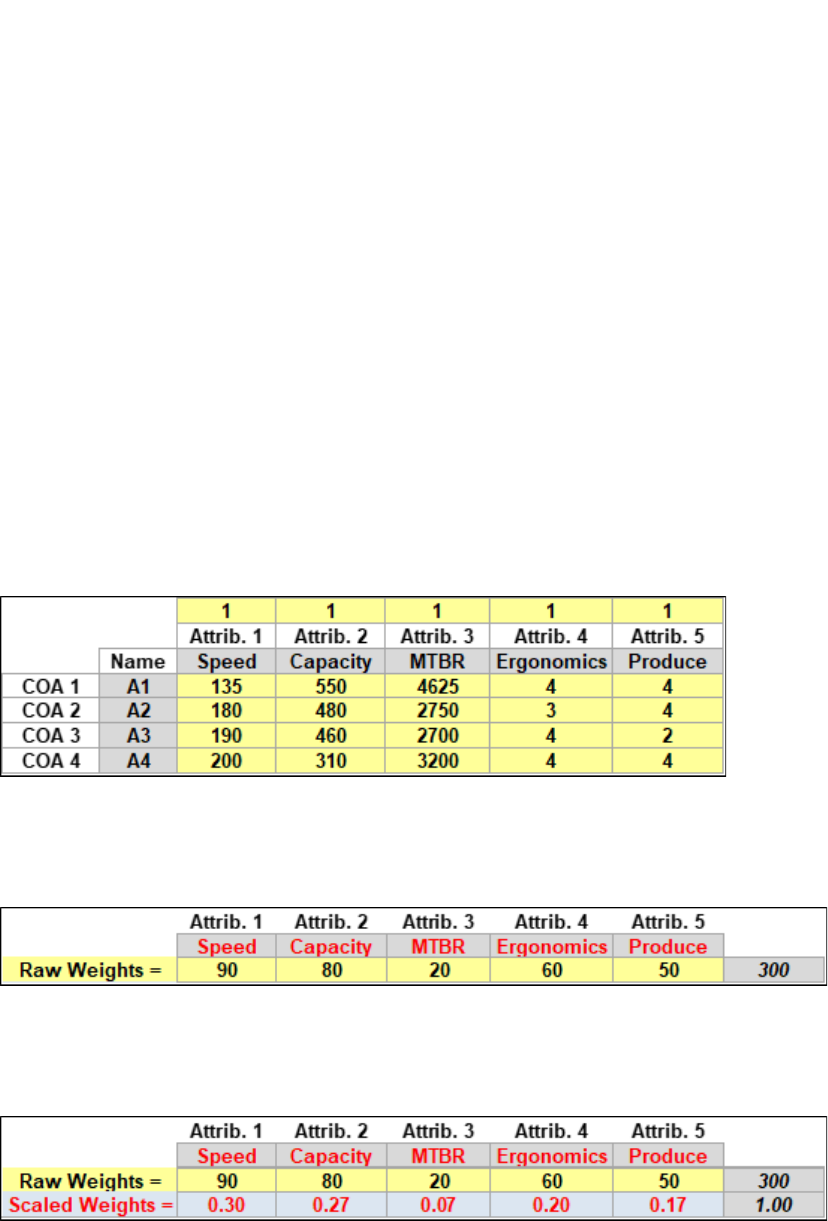
90 DAFPAM63-123 14 APRIL 2022
variables as a result of this change? What does the sensitivity analysis results imply about
the relative COA rankings?
10.5.3. Sensitivity Analysis Articulation. Sensitivity analysis should explain what happens to
costs and benefits if an underlying assumption changes or is wrong, or how changes in inputs
(i.e., variable values) impact the output (i.e., order of COAs). Sensitivity analysis should
identify the “what if” scenarios and the confidence range for your analysis results.
10.6. Applying Sensitivity Analysis to Weighting and Scoring of Benefits. While the use of a
disciplined technique for weighting and scoring benefits for the PS-BCA, the process is permeated
by subjectivity due to its inherent nature. As such, the use of sensitivity analysis upon the
weighting factors should be treated as a best practice to determine the margin of variance until the
weighting of benefits warrant a different ranking of results. Sensitivity analysis is designed to
determine if the “solution” is applicable over expected ranges of critical parameters. Those critical
parameters, more specifically, are the weights assigned by SMEs through the weighting and
scoring process of the PS-BCA. The ultimate “solution” between multiple COAs that are very
close in respective benefits can easily be flipped if the rankings are sensitive to marginal value
changes.
10.6.1. Example. As a notional example, assume we have a production line that has
quantitative and qualitative benefits of speed (amount of time to process an end item), capacity,
meantime between repairs, ergonomics, and ability to produce.
Table 10.1. COAs and Attributes.
10.6.1.1. Through the SME weighting process, each attribute or benefit receives a score
between 0-100. Through this process, the following raw weights are derived:
Table 10.2. Raw Weights.
10.6.1.2. Creating a total raw weight score of 300, the respective weights were then
divided by the total raw weight score (300) to develop the proportional weight.
Table 10.3. Scaled Weights.
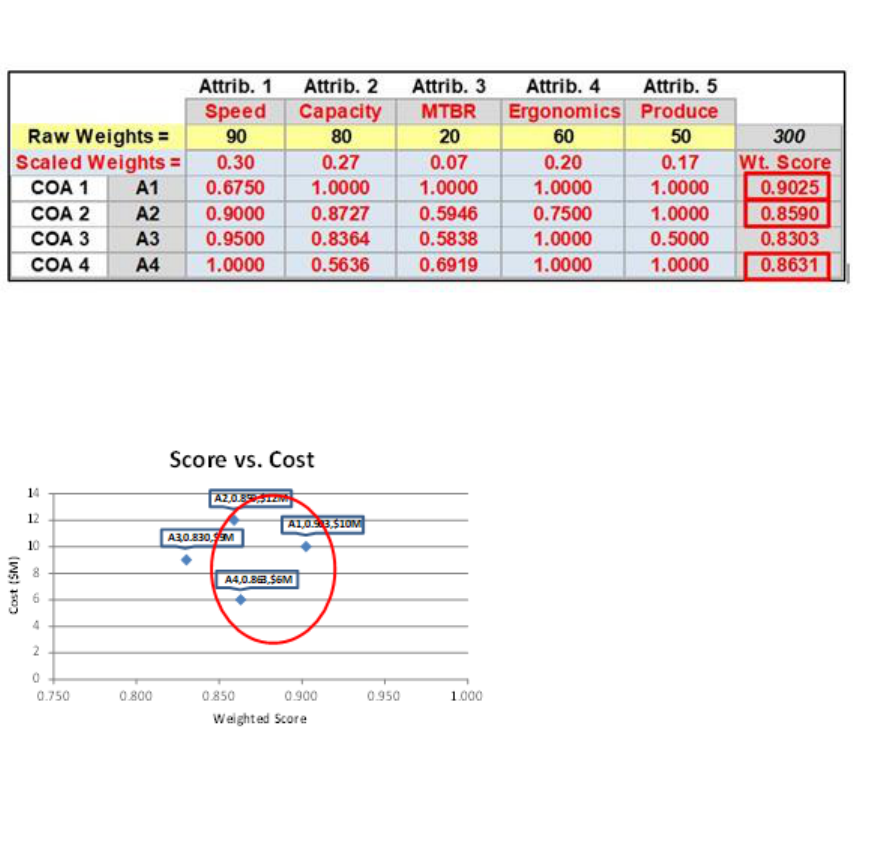
DAFPAM63-123 14 APRIL 2022 91
10.6.1.3. In this specific scenario, each attribute seeks to maximize the attribute’s value
(i.e., higher qualitative/quantitative values are better). Thus, the attribute value is then
divided by the max attribute value. Example is highlighted below:
Table 10.4. COAs, Attributes, Raw and Scaled Weights.
10.6.1.4. As can be seen in Table 10.4, COA 1 has the highest weighted benefit score,
with COAs 4 and 2 being almost the same, but a distant second and third.
Figure 10.1. COAs Weighted Benefit Scores vs Their Cost.
10.6.1.5. Once the benefits framework has been developed and a weighted score for each
COA has been achieved, the analyst should begin determining the sensitivity of the
weighted score. With sensitivity analysis, we discover that the “solution” COA 1 (ALT 1),
is surpassed in score by COA 4 (ALT 4) when the raw weight for “capacity” is decreased
from 80 to 52 (a change of 35%). The example below highlights this change:
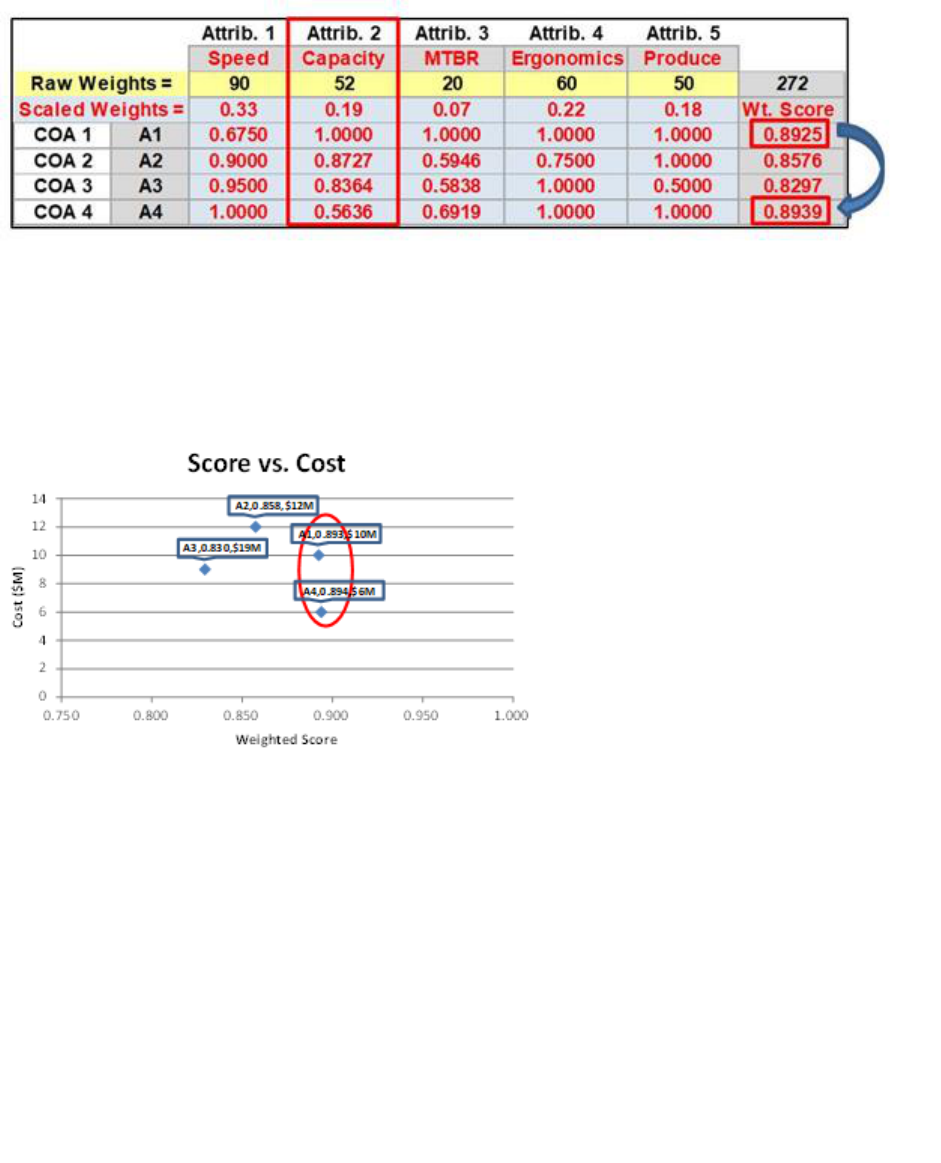
92 DAFPAM63-123 14 APRIL 2022
Table 10.5. Sensitivity Analysis Adjustment.
10.6.1.6. The result of the sensitivity analysis on Attribute 2 would provide a final
“solution” of a weighted score of .8939 for COA 4 (ALT 4) versus .8925 for COA 1 (ALT
1). An important note to make, however, is that when the COAs are compared, COA 4
(ALT 4) is $4M less expensive than COA 1 (ALT 1).
Figure 10.2. COAs Weighted Benefit Scores vs Their Cost after Weight Changes.
10.6.2. Alternative Methods to Preliminary Assessment of Sensitivity. Another approach to
identifying possible criterion that may be sensitive to changes in scoring/weighting is through
the visual analysis of the parameters that make up each COA’s weighted score.
10.6.3. Sensitivity Analysis Display. Figure 10.3 on the left hand side shows the weighted
scores of each of the four COAs. By reviewing the chart, one will find the points scored for
each of the COAs broken out by the scoring criterion. In short, one can visually see the factors
that are driving the total point score. By reviewing this chart, one can see that COA 1’s score
is greatly affected by the second criteria (capacity). It can also be quickly observed that COA
4’s score is not as sensitive to capacity as COA 1’s. As a result, since the weight given to
capacity affects the overall score each COA earns for capacity, a component of the overall
weighted score, the overall weighted score might be sensitive to the weight given to capacity.
The below chart on the right hand side shows the result of applying sensitivity analysis by
changing the weighting factor for capacity from 80 to 52. It is ultimately the analyst and the
PS-BCA IPT’s responsibility to determine sensitivity as it relates to weighting and scoring of
both quantitative and qualitative benefits.
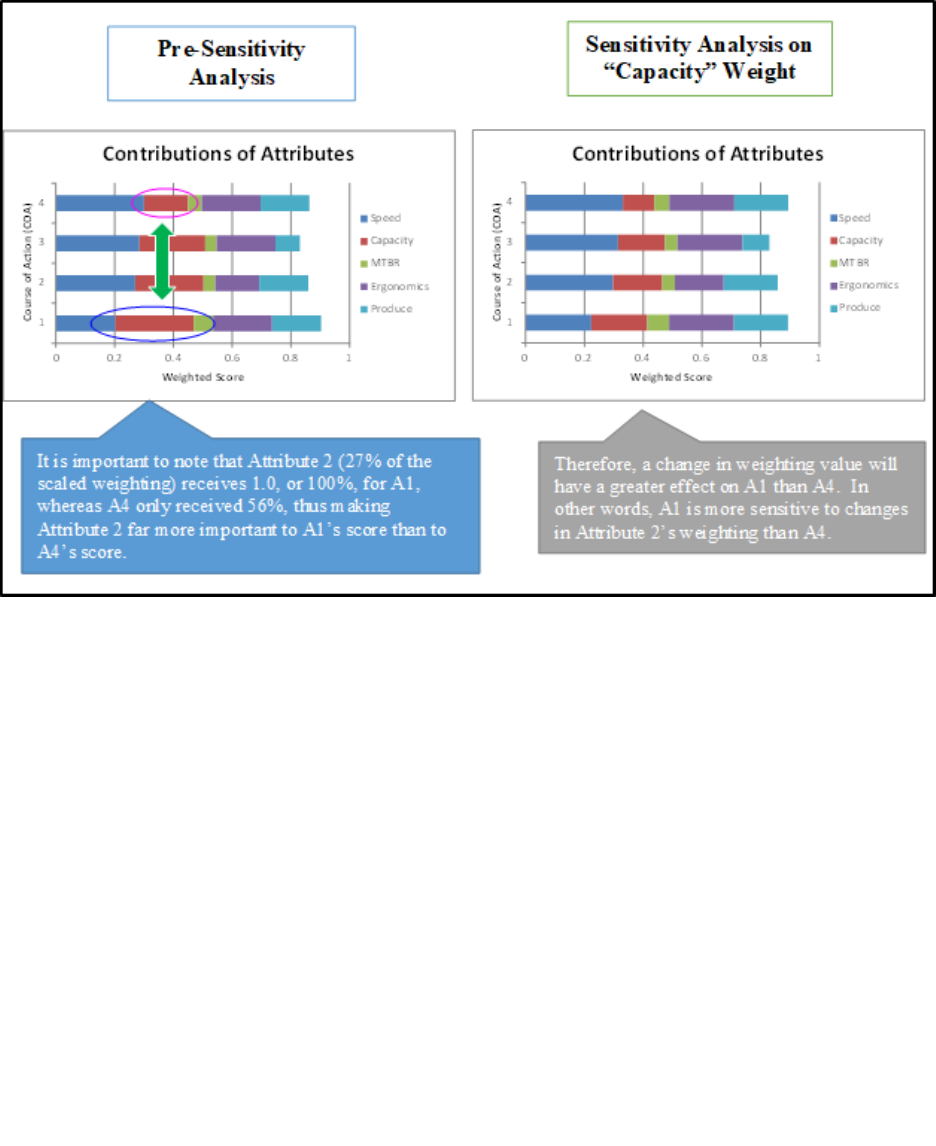
DAFPAM63-123 14 APRIL 2022 93
Figure 10.3. Sensitivity Analysis Displays.
10.7. Applying Sensitivity Analysis to Benefits. The purpose of sensitivity analysis is to test
how robust the results are.
10.7.1. Remove one stakeholder’s/advisor’s vote (or group of stakeholder’s/advisor’s votes)
one at a time and then recalculate the global weights and final COA scores to identify a driver
among the votes.
10.7.2. From the recalculated results, if the order of the COAs change by removing the one
stakeholder’s/advisor’s vote (or group of stakeholder’s/advisor’s votes), then further
investigation should be accomplished to understand why that vote (or group of votes) is a
driver.
10.7.3. If removing stakeholder’s/advisor vote (or group of stakeholder’s/advisor’s votes) one
at a time does not change the order of COAs, then no one vote (or group of votes) has an undue
influence on the results in ranking the COAs.
10.8. Shifting Attribute Scores. Shifting attribute scores between the minimum and maximum
values (e.g., from 0 to 100). The score for each major benefit (e.g., SCM, Maintenance, etc.) is
shifted from the minimum value (0.0) to the maximum value (1.0) and the COA scores
recalculated. Note: For scoring, the maximum value can be shown as 1.0 or as 100 points. Graph
the results of the analysis. The charts below show the results for the major benefits of Supply
Support (SS) and SE where the maximum value is 1.0.
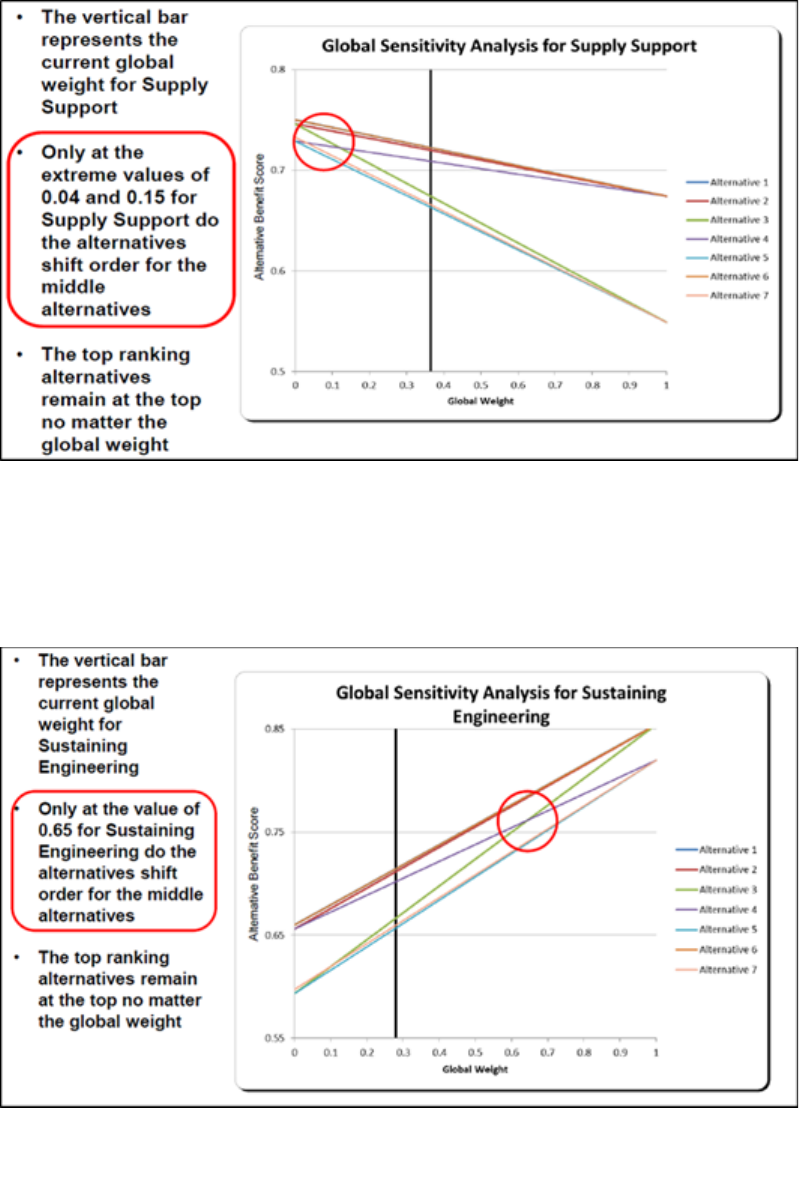
94 DAFPAM63-123 14 APRIL 2022
Figure 10.4. Global Sensitivity Analysis for Supply Support.
10.8.1. What is the likelihood that the values of 0.04 and 0.15 could occur in the data assessed?
If the likelihood is great, then the decision between COAs 7 and 4 is sensitive to the score used
to assess SS. Also, the decision between COAs 3 and 4 is sensitive to the score used for
assessing SS.
Figure 10.5. Global Sensitivity Analysis for Sustaining Engineering.
10.8.2. What is the likelihood that the value of 0.65 could occur in the data assessed? If the
likelihood is great, then the decision between COA 3 and COA 4 is sensitive to the data used
to assess SE.

DAFPAM63-123 14 APRIL 2022 95
10.9. Tipping Point. The purpose of sensitivity analysis is to determine what will happen to the
expected outcome if a key variable were to change.
10.9.1. If the sensitivity analysis does not reveal a change to the PS-BCA recommendation,
then the PS-BCA IPT can be confident that the recommended COA will remain so over the
broad range of values the variable could take on. In other words, the decision maker should
not be concerned over the uncertainty involved with the variable.
10.9.2. If, however, the sensitivity analysis indicates the expected ranking of COAs will
change with relatively small changes in key variables, then the PS-BCA recommendation
would not be stable. If the ranking of the PS-BCA COAs change as a result of changing a
variable’s value, understanding the sensitivity of the element and its relative importance to the
recommended COA is crucial information in the decision support process. The team would
need to focus on understanding the dynamics of this particular variable to address the
uncertainty in the estimate or be ready to have a detailed discussion with the decision maker
as to the likelihood the variable will take on the values that lead to different recommendations.

96 DAFPAM63-123 14 APRIL 2022
Chapter 11
FINDINGS, RECOMMENDATION, APPROVAL AND IMPLEMENTATION FOR THE
FINAL PRODUCT SUPPORT BUSINESS CASE ANALYSIS REPORT
11.1. PS-BCA Report. This section provides guidance on initial findings, recommendation,
governance and MDA approval, and implementation plan for the final PS-BCA report.
Table 11.1. PS-BCA Report Process.
PS-BCA Findings
PM
Recommendation
Governance
Approval
MDA Approval
Program Office
Consolidate Initial
Findings
Program Office
Conduct Findings
Cross Check
Program Office
Document Preliminary
PS-BCA Report
Program Office
Develop and Evaluate
Other Business
Considerations
Program Office
Develop Preliminary
Transition Plans
PM select and Brief
Initial
Recommendation and
Document Rationale
to PS-IPT (minus
PSPs)
Program Office
Develop and Evaluate
Other Business
Considerations
Program Office
Develop Preliminary
Transition Plans
PM select and Brief
Initial
Recommendation and
Document Rationale
to PS-IPT (minus
PSPs)
Approve and
Document Final
Decision and
Implementation Plan
Sign PS-BCA Final
Report
11.2. PS-BCA Findings. The PS-BCA initial findings are data driven results from the analysis.
At this point, the PMO understands the overarching results of the PS-BCA as well as performs a
cross-check to validate the integrity and overall soundness of the PS-BCA.
11.2.1. Findings Summary. At this stage, costs, benefits, and risks need to be evaluated
together either through a MODA or WUS approach.
Table 11.2. Findings Summary.
Work Streams
Benefit
Score
Risk
Cost
(NPV
$M)
PSM
Supply
Mx
Sustain
Eng
1
GOV
GOV
GOV
GOV
0.75
MED
$3,500
2
GOV
GOV
GOV
Contract
0.80
LOW
$3,750
3
GOV
Contract
GOV
GOV
0.70
HIGH
$4,000
4
GOV
Contract
Contract
GOV
0.65
MED
$3,800
5
Contract
Contract
Contract
Contract
0.60
MED
$3,600

DAFPAM63-123 14 APRIL 2022 97
11.2.2. Cross-Check. A cross-check ensures the integrity and overall soundness of the PS-
BCA is maintained. Usually, after the initial findings are collected and displayed, the PMO
identifies outliers and/or key drivers in the analysis. Once outliers and/or key drivers are
identified, the IPT (minus the PSPs) then determines if there are steps that need to be taken
either through sensitivity analysis, additional data samples, etc. to validate the quality of the
data that is causing the outlier and/or key driver. Based on the example in Table 11.2, next
steps could include:
11.2.2.1. What are the key drivers within each of the COAs across costs, benefits, and
risks?
11.2.2.2. What is the driver behind COA 2 having the highest benefit score?
11.2.2.3. What was the quality/certainty in the data that supports that driver?
11.2.2.4. What are key differences in costs between COA 3 and COA 1?
11.2.2.5. Are there any confidence bounds on any of the key drivers? (For example, COA
X projected to have an AO increase of 2% (+/- 1%))
11.2.2.6. Based on the initial findings, are there areas where additional sensitivity analysis
is required?
11.2.2.7. Based on the initial findings are there data procurement recommendations that
would benefit the next PS-BCA?
11.2.2.8. Are there any potential excursions that would aid the decision maker in making
a decision?
11.2.3. Review and Coordination. SAF/FMC is responsible for certifying comparative
analyses meeting the criteria outlined in AFI 65-501, Section 1.5. This includes the analyses
captured in PS-BCAs. Accordingly, the PMO should have their comparative analyses
reviewed and coordinated by the MAJCOM FM and SAF/FMC for ACAT I and special
programs. MAJCOM FM offices should review ACAT II and ACAT III programs. The PS-
BCA final report should include the documented coordination.
11.2.4. PM Recommendation. The PM recommendation should take into account all of the
PS-BCA findings, other business considerations, and preliminary transition plans. The
recommendation should be documented in the preliminary PS-BCA and include detailed
rationale, justification, and supporting information to explain the COA recommendation and
why the submitted COA is recommended over the other COAs. The preliminary PS-BCA
should also summarize the main considerations that contributed to the recommendation.
Finally, the PM recommendation should discuss whether this is a final solution, or if follow-
on projects are necessary to achieve full benefits.
11.2.4.1. Other business considerations are considerations outside the span of control of
the PS-BCA scope and subsequent findings but may be relevant data points to the
governance structure and/or decision maker in making a recommendation determination.
Examples of other business considerations include:
11.2.4.1.1. Loss of critical industrial capabilities
11.2.4.1.2. Preservation of multiple sources of product support capabilities

98 DAFPAM63-123 14 APRIL 2022
11.2.4.1.3. Geo-Political considerations
11.2.4.1.4. Additional sensitive /classified information only known by senior leaders
11.2.4.1.5. Evaluate and determine potential positive or negative impacts to 10 USC
2464 (Core workload) and 10 USC §2466 if each COA were implemented.
11.2.4.1.6. Evaluate and determine potential positive or negative impacts to Working
Capital Fund.
11.2.4.1.7. If a specific skill set is proposed to be outsourced, is there a potential for
the government skill set to atrophy over time?
11.2.4.1.8. Any potential obstacles not already considered that would impede the
implementation of the proposed COA?
11.2.4.1.9. Assessment of potential impacts (positive or negative) to organizations
involved in the transition, implementation and /or execution of the proposed COA.
11.2.4.1.10. Other political impacts that should be considered?
11.2.4.1.11. Summarize potential best practices to include any potential limitations on
the Air Force implementing the best practice available due to laws, regulations or DoD
policy.
11.2.4.2. Funding Impacts. The PS-BCA team should compare the proposed COAs to the
current program budget and consider the funding impact and “Cost to the Program” from
an affordability perspective Note: The Cost of the Program view should be for the total
analysis period; however, comparisons to the budget for the recommended COA would be
primarily for the FYDP. A more detailed funding plan is required for the recommended
COA.

DAFPAM63-123 14 APRIL 2022 99
Table 11.3. Cost to the Program Output Example.
11.2.4.3. Manpower Impacts. In addition to an assessment of the funding/budget, the
potential manpower impact may be a factor the decision maker should consider. While the
manpower for the PMO and user should be available from the Cost Model, quantifiable
impacts to WCF positions may not be easy to determine due to uncertainty of specific
workloads. However, the PS-BCA team may be able to annotate potential risks or
opportunities if specific COAs are selected.
Table 11.4. Alternative Comparisons.
Alternative 1
Alternative 2
Alternative 3
Alternative 4
Alternative 5
AFLCMC
+/- #
+/- #
+/- #
+/- #
+/- #
AFNWC
+/- #
+/- #
+/- #
+/- #
+/- #
SpOC/SSC/ECP
+/- #
+/- #
+/- #
+/- #
+/- #
Other PSP
+/- #
+/- #
+/- #
+/- #
+/- #
User
+/- #
+/- #
+/- #
+/- #
+/- #
11.2.5. Preliminary Transition Plans. The preliminary Transition Plan should be laid out to
show the major events/changes that are required to take place during the transition from the
“as is” to a given COA. Assess changes in work streams or “Transition events” to determine
actions required to implement proposed changes (i.e.: contract, funding/budgeting, manpower,
facilities, training, enter into data systems, etc.). Ensure PS-BCA Risk Assessment and
Mitigation Plans are reflected in transition planning.
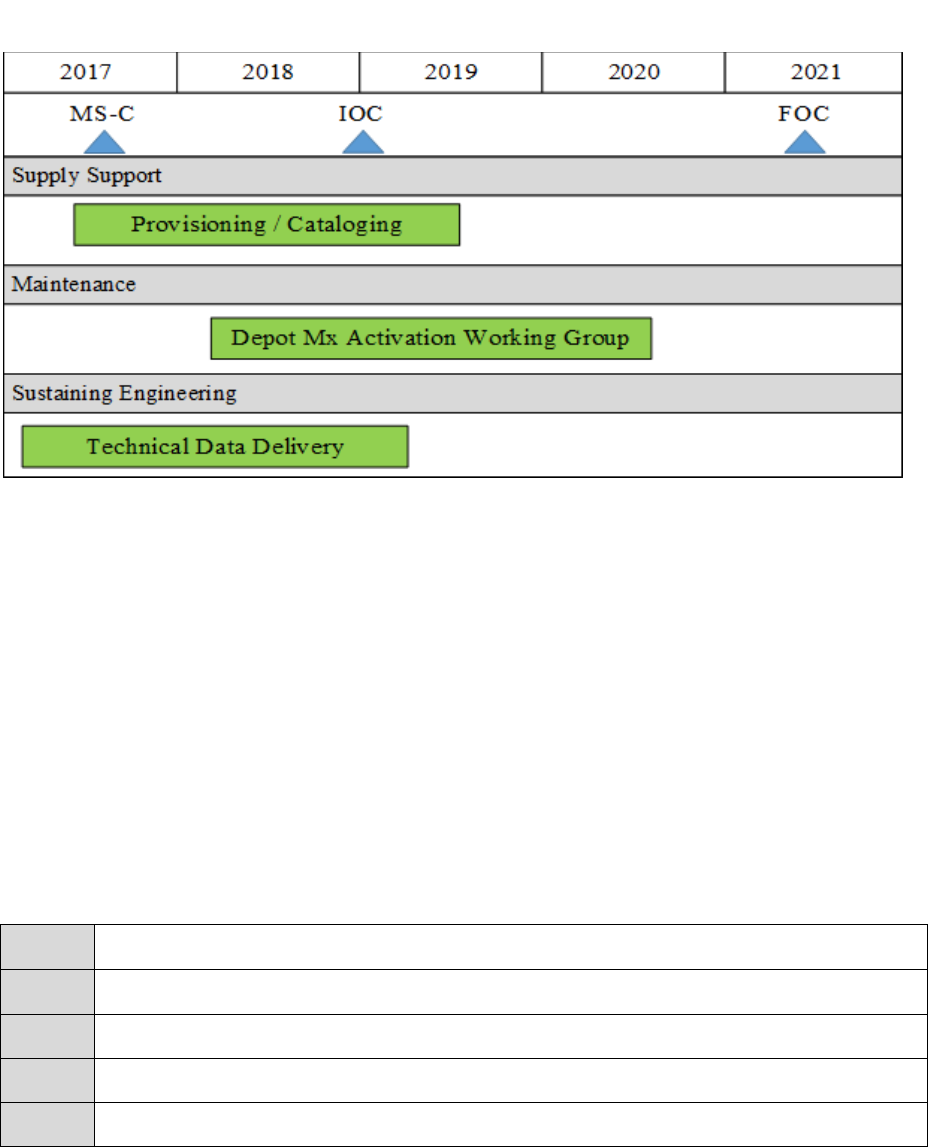
100 DAFPAM63-123 14 APRIL 2022
11.2.5.1. Evaluate cost model to ensure transition plan aligned with cost model estimates.
11.2.5.2. Identify potential critical path for implementation (may be considered an off
ramp in final implementation plan).
Figure 11.1. COA Example for Transition Plans.
11.2.6. Governance Approval.
11.2.6.1. PM Brief to Governance Structure. Through the governance structure process,
the PM should summarize the analysis methodology and approach, PS-BCA IPT (minus
PSPs) initial findings and recommended COA with supporting justification and rationale
to include other business considerations and key contributors to the PM’s recommendation.
During this time, the governance structure members should provide concurrence on 1) the
PS-BCA IPT (minus PSPs) initial findings and 2) the PM’s recommendation. If the
governance structure identifies concerns with the PS-BCA IPT’s (minus PSPs) findings,
the PS-BCA IPT (minus PSPs) may be directed to perform additional cross-checks to
ensure their findings are sound. If the governance structure agrees with the findings but
does not concur with the PM’s recommendation, the governance structure members should
provide their rationale to the PM and those concerns should be taken forward along with
“views of others” to the MDA for consideration prior to a final decision being made.
Table 11.5. Outline for PS-BCA Out-Brief.
Section
PS-BCA Out-Brief Outline
1
Bottom Line Up Front (BLUF)
2
Overview of Program
3
PS-BCA Team Membership
4
Problem Statement

DAFPAM63-123 14 APRIL 2022 101
Section
PS-BCA Out-Brief Outline
5
Scope – Product Support Elements/Grouping
Facts, Ground Rules, and Assumptions (GR&As)
Ground Rules
6
Assumptions
7
Defined COAs
8
Analysis Findings (COAs compared to “as-is”)
Costs
Benefits
Risks with Mitigation Plan
Overall Perspective
9
Methodology and Criteria
WUS and/or MODA; or Another Approved Method
Evaluation Structure and Criteria (e.g., Weighting)
Metrics
10
Sensitivity Analysis & Cross-Check
Rationale for selecting the drivers to conduct the sensitivity analysis
Driver or drivers that would change the relative ranking of COAs
Amount of sensitivity of driver or drivers (e.g., Factor of Change to Data – 2 times,
3 times, etc.)
11
Other Business Considerations (e.g., Political, Financial)
12
Finding Summary
13
Recommendation
14
Off-ramps if recommendation cannot be implemented and/or benefits cannot be
achieved
15
Way Ahead
11.2.6.2. Outline for PS-BCA Final Report. The PS-BCA final report ensures the PS-BCA
is fully documented per project objectives, including methodologies that are repeatable and
traceable, and provides formal documentation of PS-BCA analysis and findings. The PS-
BCA final report at this stage should document the overall approach, methodology and
thought process that went in to the analysis up to this point to include the initial findings
and supporting cost model. This includes Subject Matter Expert (SME) rationale for the
benefit analysis, weighting and scoring, and any other facets of the analysis where SMEs
are utilized. The PS-BCA final report should be presented in the prescribed outline with
the appropriate information that explains in detail how the PS-BCA was completed, the
methodology, define the COAs and define the associated risk and benefits used throughout
the PS-BCA.

102 DAFPAM63-123 14 APRIL 2022
Table 11.6. PS-BCA Final Report Outline.
Section
PS-BCA Final Report Outline
1
Executive Summary
2
Introduction
Problem Statement
Background
Scope
3
Desired Outcomes and Requirements
Desired Outcomes
Requirements
4
Assumptions and Methods
Facts, Ground Rules, and Assumptions (GR&As)
Analysis Methods, Tools, and Rationale
Evaluation Criteria
5
Courses of Action (COAs)
Current Baseline/Anticipated Initial Support/Status Quo
Other COAs
6
Mission and Business Impacts
Benefits and Non-Financial Analysis
Cost and Financial Analysis
7
Risk Analysis and Mitigation Plans
Risk Analysis
Mitigation Plans
8
Sensitivity Analysis & Cross-Check
9
Conclusion
Comparison of COAs
Summary of Results
10
Recommendations
Specific Actions Based on Business Objectives
Implementation Plan
11.2.6.3. Implementation Plan. In support of the MDA decision process, the PM should
develop a detailed implementation plan for the recommended COA only. The
implementation plan builds and expands upon the preliminary transition plan for the
recommended COA. The development of the PS-BCA Implementation Plan includes a
Communications Plan, Project Plan, Budget Plan, Change Management Plan (including
Stakeholder Action Plan), and Training Plan. The PMO should develop an executable
implementation plan, detailed schedule and off-ramps for implementing the approved PS-
BCA COA. The PMO should identify each task required to implement the solution and
ensure a timeline/schedule for each task is developed and that a fully integrated schedule
is established for full implementation of the approved COA. Reference AFMAN 65-506,
Section 7.8, for additional discussion on information and activities that are important for
implementing a decision.

DAFPAM63-123 14 APRIL 2022 103
Table 11.7. Implementation Plan Outline.
Section
Implementation Plan Outline
1
Management Overview
2
Description of Implementation
3
Points of Contact
4
Configuration Management
5
Major Tasks to Implement the Recommendation
Detailed Schedule
Timeline for Each Task
IMS for overall plan (integrated across all tasks)
6
Security
System Security Features
Security During Implementation
7
Implementation Support
Hardware
Software
Facilities
Material
8
Personnel Requirements/Staffing
9
Training
10
Implementation Team
11
Users if Required
12
Performance Monitoring
13
Implementation is on schedule and on cost
14
Recommendation will meet cost and performance benefits from PS-BCA
15
Off-Ramp Plan
16
Go/No Go Decision
17
Post Implementation Verification
11.2.6.4. Off-Ramps. The PMO should ensure there are off-ramps built into the plan in
case something occurs that prohibits execution of the recommended COA. Off- ramps are
decision points with potential alternate solutions that can be implemented if conditions
change (for example: if needed funding is not received, what is the alternate solution?).
Status updates, changes to the implementation plan, and any decision not to continue to
execute approved COA for any reason should be briefed through the governance structure
and ultimately approved by the MDA to ensure all parties understand the changes and
concur.

104 DAFPAM63-123 14 APRIL 2022
11.2.7. Milestone Decision Authority (MDA) Approval.
11.2.7.1. MDA Decision and Documentation. The PM is responsible to present the
recommendation, Governance approval (to include any “views of others”) and the
implementation plan to the MDA. Via an Acquisition Decision Memorandum (ADM), the
MDA should provide sufficient information so that the PM has formal documentation of
the final decision, to include implementation trigger points (i.e., off-ramps) that would
require the PM to come back to the MDA.
11.2.7.2. PM Update and MDA Sign PS-BCA Final Report. Following the MDA decision,
the PM should document the final decision and any supporting rationale in the PS-BCA
report and attach the ADM if required. If the MDA decision is different than the PM’s
recommendation, the PM should document the MDA decision and rationale and update the
implementation plan to reflect the MDA’s approved COA. At this point, the PS-BCA
report is now considered final and should be sent to the MDA for approval and signature.
Once approved, the PS-BCA final report is attached to the Life Cycle Sustainment Plan as
an annex. Implementation and execution should be monitored IAW with the approved
implementation plan.
DARLENE J. COSTELLO
Principal Deputy, Assistant Secretary of the Air
Force
(Acquisition & Logistics)

DAFPAM63-123 14 APRIL 2022 105
Attachment 1
GLOSSARY OF REFERENCES AND SUPPORTING INFORMATION
References
10 U.S.C. 2320, Rights in Technical Data
10 U.S.C. 2337, Life-Cycle Management and Product Support
10 U.S.C. 2460, Definition of Depot-Level Maintenance and Repair
10 U.S.C. 2464, Core Logistics Capabilities
10 U.S.C. 2466, Limitations on the performance of depot-level maintenance of materiel
AFI 63-101/20-101, Integrated Life Cycle Management, 16 September 2016
AFI 65-501, Economic Analysis, 29 October 2018
AFMAN 65-502, Inflation, 30 October 2018
AFMAN 65-506, Economic Analysis, 6 September 2019
DAFPAM 63-128, Integrated Life Cycle Management, 3 February 2021
DoD Directive 5000.01, The Defense Acquisition System, 9 September 2020
DoD Cost Assessment and Program Evaluation (CAPE), Operating and Support (O&S) Cost-
Estimating Guide, September 2020
DoD Product Support Business Case Analysis Guidebook, April 2011
DoD Instruction 5000.02T, Operation of the Defense Acquisition System, 07 January 2015
DoD Instruction 7041.03, Economic Analysis for Decision Making, 9 September 2015
OMB Circular A-94, Guidelines and Discount Rates for Benefit-Cost Analysis of Federal
Programs, 29 October 1992
Abbreviations and Acronyms
3PL—Third Party Logistics
50/50—Distribution of Depot – Level Maintenance
A4—Logistics Directorates
Ao—Operational Availability
ADM—Acquisition Decision Milestone
AA—Aircraft Availability
ACAT—Acquisition Category
ACI—Analytical Condition Inspection
AF—Air Force
AFCAA—Air Force Cost Analysis Agency

106 DAFPAM63-123 14 APRIL 2022
AFI—Air Force Instruction
AFLCMC—Air Force Life Cycle Management Center
AFLCMC/LG—Air Force Life Cycle Management Center Logistics Directorate
AFMAN—Air Force Manual
AFMC—Air Force Materiel Command
AFNWC—Air Force Nuclear Weapons Center
AFREM—Air Force Enterprise Risk Management
AFSC—Air Force Sustainment Center
AFSC/CC—Air Force Sustainment Center Commander
AFSC/FZ—Air Force Sustainment Center Cost Estimating
AFSC/LG—Air Force Sustainment Center Logistics Directorate
AFTOC—Air Force Total Ownership Cost
AHP—Analytical Hierarchy Process
AIS—Automated Information System
Ao—Operational Availability (Aircraft)
ATS—Automated Test System
BCA—Business Case Analysis
BLUF—Bottom Line Up Front
BOCR—Business Overhead Cost Recovery
CAE—Component Acquisition Executive
CAPE—Cost Assessment and Program Evaluation
CDD—Capability Development Document
CDRL—Contract Data Requirements List
CE—Critical Expert
CEMS—Comprehensive Engine Management System
CER—Cost Estimating Relationship
CLS—Contractor Logistics Support
COA—Course of Action
CPD—Capabilities Production Document
CSA—Commercial Service Agreements
CSDR—Cost & Software Report
CWT—Customer Wait Time

DAFPAM63-123 14 APRIL 2022 107
DAB—Defense Acquisition Board
DLA—Defense Logistics Agency
DLRS—Depot Level Repairables
DoD—Department of Defense
DoDI—Department of Defense Instruction
DSOR—Depot Source of Repair
EN—Engineering
FAR—Federal Acquisition Regulation
FM—Financial Management
GO/SES—General Officer/Senior Executive Service
GR&A—Ground Rules and Assumptions
HAF—Headquarters Air Force
HQ AFMC—Headquarters Air Force Materiel Command
IAP—Incremental Approval Point
IAW—In Accordance With
ILA—Independent Logistics Assessment
ILCM-EF—Integrated Life Cycle Management – Executive Forum
IPS—Integrated Product Support
IPT—Integrated Project Team
IRR—Internal Rate of Return
KPP—Key Performance Parameter
KSA—Key System Attribute
LCCE—Life Cycle Cost Estimate
LCL—Life Cycle Logistics
LCSP—Life Cycle Sustainment Plan
LIMSEV—Logistics Installations and Mission Support – Enterprise View
MAIS—Major Automated Information Systems
MAJCOM—Major Command
MDA—Milestone Decision Authority
MDAP—Major Defense Acquisition Program
MER—Manpower Estimate Report
MFR—Memorandum for Record

108 DAFPAM63-123 14 APRIL 2022
MICAP—Mission Impaired Capability Awaiting Parts
MOA—Memorandum of Agreement
MODA—Multi-Objective Decision Analysis
MOU—Memorandum of Understanding
MS—Milestone
NPV—Net Present Value
O&S—Operation & Support
OEM—Original Equipment Manufacturer
OMB—Office of Management & Budget
OSD—Office of the Secretary of Defense
OT&E—Organize, Train, and Equip
P/CS—Probability & Consequence Screening
PAA—Primary Aircraft Authorized
PDM—Programmed Depot Maintenance
PEO—Program Executive Officer
PK—Contracting
PM—Program Manager
PMO—Program Management Office
POAM—Plan of Actions and Milestones
POC—Point of Contact
POE—Program Office Estimate
PPP—Public-Private Partnership
PS—Product Support
PSS—Product Support Strategy
PSA—Product Support Arrangement
PSBCA—Product Support Business Case Analysis
PSM—Product Support Manager
PSP—Product Support Provider
PV—Present Value
REMIS—Reliability & Maintainability Information System
S4—Space Logistics Directorate
SAE—Service Acquisition Executive

DAFPAM63-123 14 APRIL 2022 109
SAF/AQ—Assistant Secretary of the Air Force (Acquisition)
SAF/AQD—Assistant Secretary of the Air Force / Product Support and Logistics
SAF/AQI—Assistant Secretary of the Air Force / Directorate of Information Dominance
SAF/AQP—Assistant Secretary of the Air Force / Directorate of Global Power
SAF/AQQ—Assistant Secretary of the Air Force / Directorate of Global Reach
SAF/FMC—Assistant Secretary of the Air Force / Directorate of Cost and Economics
SAF/FMCE—Directorate of Economics and Business Management
SCM—Supply Chain Management
SE—Sustaining Engineering
SLOC—Source Lines of Code
SME—Subject Matter Expert
SpOC—Space Operations Command
SSC—Space Systems Command
SSC/S4—Space Systems Command/Acquisition Logistics and Mission Sustainment
SSC/ECP—Space Systems Command/Enterprise Corps
TAI—Total Active Inventory
TY—Then Years
USAF—United States Air Force
USC—United States Code
USD (A&S)—Under Secretary of Defense for Acquisition and Sustainment
USSF—United States Space Force
USSF/S4U—United States Space Force Life Cycle Management
USSF/S4—United States Space Force Logistics, Engineering, and Force Protection
WUS—Weighted Utility Score
Terms
Best Value—Expected outcome of an acquisition that, in the Government’s estimation, provides
the greatest overall benefit in response to the requirement. (Source: Federal Acquisition Regulation
(FAR), Section 2.10.)
Best Value Analysis—An analysis that considers not only cost, but other quantifiable and non-
quantifiable factors to support a decision. This can include, but is not limited to, impact on
readiness, quality and cycle time. (Source: DoDM 4151.23)
Contractor Logistic Support (CLS)—A contractor, rather than the government, is responsible
for the integration of logistic support functions such as providing engineer support, identifying
requirements for spare and repair parts, facilities, materiel, equipment, personnel and performing

110 DAFPAM63-123 14 APRIL 2022
maintenance on weapon systems. The Original Equipment Manufacturer (OEM) often times
provides CLS as well as can provide Product Support Integration (PSI) functions.
Contractor Support—An overarching term that applies to a contractor’s materiel and/or
maintenance support for a system.
Due Diligence—Process of systematically researching and verifying the accuracy of information.
Integrated Product Support Elements (IPS Elements)—The package of support functions
required to deploy and maintain the readiness and operational capability of major weapon systems,
subsystems, and components, including all functions related to weapon systems readiness.
Life Cycle Sustainment Plan (LCSP)—A plan describing sustainment influences on system
design and the technical, business, and management activities to develop, implement, and deliver
a product support package that maintains affordable system operational effectiveness over the
system life cycle and seeks to reduce cost without sacrificing necessary levels of program support.
Milestone-A (MS-A) —Milestone-A is a Milestone Decision Authority (MDA) led review at the
end of the Materiel Solution Analysis (MSA) Phase. Its purpose is to make a recommendation or
seek approval to enter the Technology Maturation & Risk Reduction (TMRR) Phase.
Milestone-B (MS-B)—Milestone-B is a MDA led review at the end of the TMRR Phase. Its
purpose is to make a recommendation or seek approval to enter the Engineering and Manufacturing
Development (EMD) Phase. Milestone B is considered the official start of a program.
Milestone—C (MS-C) - The point at which a recommendation is made and approval sought
regarding continuing an acquisition program, i.e., proceeding to the next phase. MS-C approval
allows entry into the Production and Deployment phase. MS-C authorizes entry into Low Rate
Initial Production (LRIP) (for MDAPs and major systems), into production or procurement (for
non-major systems that do not require LRIP) or into limited deployment in support of operational
testing for Major Automated Information System programs or software intensive systems with no
production components.
Organic—Refers to U.S. government entities (principally DoD organizations) such as
infrastructure, personnel, equipment, and other sustainment capability to support a program.
Product Support Business Case Analysis (PS—BCA) - A PS-BCA is an expanded cost/benefit
analysis with the intent of determining a best value solution for product support. It assesses each
COA and weighs total cost against total benefits to arrive at the optimum solution. The PS-BCA
process goes beyond cost/benefit or traditional economic analyses by documenting how each COA
fulfills the strategic objectives of the program; how it complies with product support performance
measures; and the resulting impact on stakeholders. The PS-BCA identifies which alternative
product support options provide optimum mission performance given cost and other constraints,
including qualitative or subjective factors. The PS-BCA may result in a recommended PSS that is
hybrid blend of both Performance Based Logistics and transactional product support strategies
broken out at the component, sub-system or system level, along with a best value mix of
government and industry capabilities to deliver the 12 IPS elements in an integrated product
support package at affordable cost. (Source: Defense Acquisition University Integrated Product
Support Element Guidebook, Apr 2021).
Public—Private Partnerships (PPP) - A cooperative arrangement between an organic product
support provider and one or more private-sector entities to perform defense-related work, utilizing

DAFPAM63-123 14 APRIL 2022 111
DoD facilities and equipment, or both. There are three basic types of public-private partnership in
use within the defense sustainment community: workshare, direct sale, and lease. The bulk of the
current authorities for partnerships are focused on depot maintenance.

112 DAFPAM63-123 14 APRIL 2022
Attachment 2
LEGACY PROGRAM PRODUCT SUPPORT BUSINESS CASE ANALYSIS
SUFFICIENCY MEMORANDUM
Figure A2.1. Legacy Program Product Support Business Case Analysis Sufficiency
Memorandum.
[Date]
MEMORANDUM FOR RECORD
FROM:
SUBJECT: [program name] Product Support Strategy Assessment
References: (a) Title 10, United States Code, Section 2337
(b) Air Force Instruction 63-101/20-101, Integrated Life Cycle Management
(c) Air Force Pamphlet 63-123, Product Support Business Case Analysis
1. The purpose of this memorandum is to document that the [program name] Product Support
Strategy (PSS) is affordable and effective, and that changes to the product support strategy are
not being considered at this time.
2. The [program name] program PSS is within expected costs and performance metrics and is
achieving warfighter requirements. This determination has been validated through review of
the sustainment measurements reported in the [program name] Defense Acquisition Executive
Summary (DAES). The three measurements are: Materiel Availability, Materiel Reliability
and Operating and Support (O&S) Costs. All three Current Estimates (CE) are better than their
respective Current Baseline goals. Specifically, Material Availability CE is [xx%], well above
the Baseline goal of [xx%] and the Material Reliability CE of [xx hours] far exceeds the
Baseline goal of [xx hours]. Similarly, the O&S CE is [$XXB], under the Baseline goal of
[$XXB] (both in BY92$).
3. [Include a brief description of any assessment of the PSS that was accomplished, if
applicable]. The [program name] program office also conducted an assessment to consider
whether alternative PSS might be more affordable or effective. This assessment was
completed on [DATE], and it was found that the current PSS is the best value alternative.
4. In accordance with References (a), (b) and (c), I have determined that the appropriate
analyses have been conducted to validate the PSS and that no further analysis of the [program
name] PSS is necessary at this time.
5. For any questions regarding this memo, please contact the [program name] Product Support
Manager, [PSM Name], at DSN [XXX-XXXX].
Attachment:
[Copy of Assessment (If applicable)]
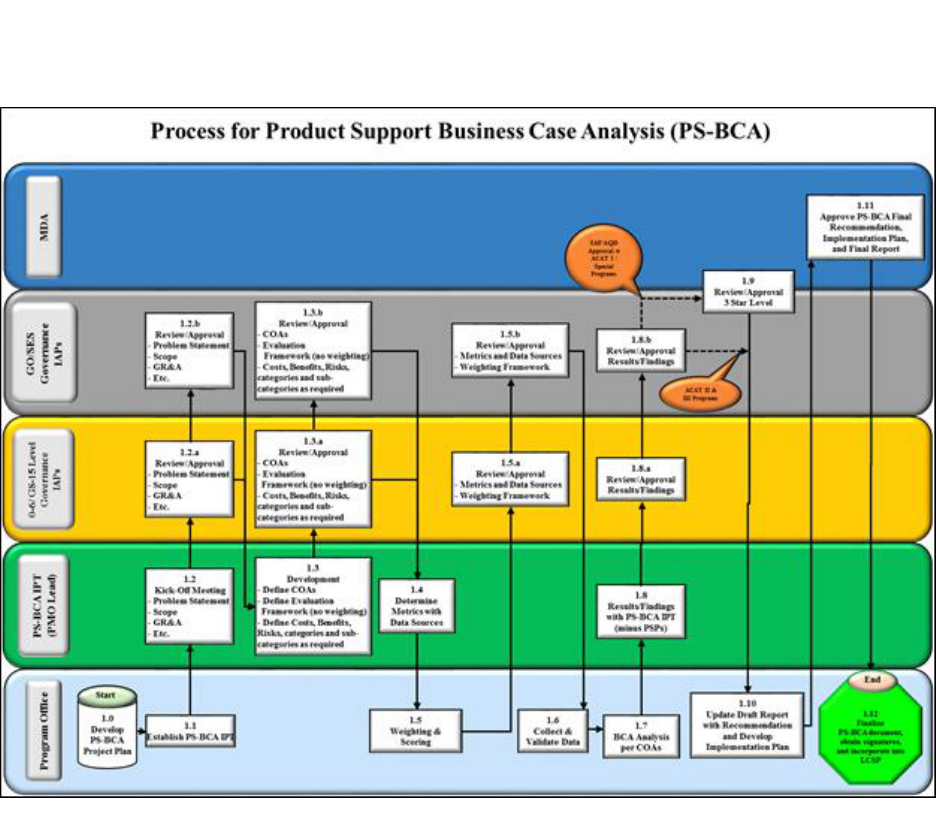
DAFPAM63-123 14 APRIL 2022 113
Attachment 3
PROCESS NARRATIVE
A3.1. The PS-BCA Process map documents the various steps to assist the PMO in working
through the individual steps of the PS-BCA process.
Figure A3.1. PS-BCA Process Overview.
A3.2. The PS-BCA process narratives consist of the following elements:
A3.2.1. Process Name: Name of process step.
A3.2.2. Process Description: Provides a concise overview of the process step.
A3.2.3. Responsible OPR: The office with primary responsibility is the organizational unit or
individual(s) responsible for ensuring the process step is completed.
A3.2.4. Inputs and Output: For every process step there is a series of inputs. Additionally,
each process step has an output. The final result of the process includes documentation,
correspondence, approvals, etc. to show the process was completed successfully.

114 DAFPAM63-123 14 APRIL 2022
Table A3.1. Develop PS-BCA Project Plan (Process 1.0).
Process Narrative
Process Name:
1.0 Develop PS-BCA Project Plan
Process
Description:
Determine if a new or revalidated PS-BCA is required and begin the
initial development of the project plan
Responsible OPR
PMO (PSM)
Inputs
Outputs
A decision tree to determine if a new or
revalidated PS-BCA is required is located in
the introduction section of the pamphlet
Decision made to conduct a new or
revalidated PS-BCA
If developing PS-BCA:
PMO PS-BCA staffing requirements
PS-BCA IPT Membership
Governance members identified (O-6 &
GO/SES levels)
Preliminary assessment of potential COAs
Draft problem statement
Draft Plan of Actions and Milestones
(POAM) if developing PS-BCA
Table A3.2. Establish Internal PMO PS-BCA Team (Process 1.1).
Process Narrative
Process Name:
1.1 Establish PS-BCA IPT
Process
Description:
Identify appropriate stakeholders/advisors and begin planning and
preparing for a kickoff meeting. The PS-BCA IPT should consist of
stakeholders, support SMEs, and advisors who have a stake or interest in
the outcome of the PS-BCA.
Responsible OPR
PMO (PSM, PS-BCA IPT Lead)
Inputs
Outputs

DAFPAM63-123 14 APRIL 2022 115
Process Narrative
Decision on new or revalidated PS-BCA
made
Initial set of stakeholders/advisors for IPT
identified
Governance members identified
Draft problem statement
Draft POAM
Establish PS-BCA IPT membership
(including contractors if required)
Refine draft problem statement
Draft scope, charter, and agenda (for kickoff
meeting)
Draft facts, ground rules & assumptions
(GR&A)
Update POAM
If revalidation, collect previous data,
assumptions, and update on implementation
of previous PS-BCA
Finalize IPT and Governance membership
Establish date and time for kickoff meeting
and invite stakeholders/advisors
Table A3.3. Kickoff Meeting (Process 1.2).
Process Narrative
Process Name:
1.2 Kickoff Meeting
Process
Description:
Review initial documents and finalize various outputs
Responsible OPR
PSM, PS-BCA IPT Lead
Inputs
Outputs
IPT members received advance copies of the
following draft documents
Kickoff meeting agenda
Charter
Problem statement
Scope
GR&A
Updated POAM
IPT and Governance members identified
If revalidation, collect previous data,
assumptions, and update on implementation
of previous PS-BCA
Charter
Problem statement
Scope
Facts, GR&As
Updated POAM
Schedule O-6 level Governance Incremental
Approval Point (IAP) meeting
Table A3.4. O-6/GS-15 level IAP (Process 1.2a).
Process Narrative
Process Name:
1.2a O-6/GS-15 level IAP

116 DAFPAM63-123 14 APRIL 2022
Process Narrative
Process
Description:
Review and approve IPT’s first incremental work (e.g. Problem
Statement, Scope, GR&A, POAM)
Responsible OPR
PMO (PSM, PS-BCA IPT Lead)
Inputs
Outputs
Problem statement
Scope
Facts, GR&As
Updated POAM
O-6 level Governance approved:
Problem statement
Scope
Facts, GR&As
POAM
Guidance from O-6 level Governance
Schedule Executive level Governance IAP
meeting
Table A3.5. Executive (GO/SES) level IAP (Process 1.2b).
Process Narrative
Process Name:
1.2b Executive (GO/SES) level IAP
Process
Description:
Review and approve IPT’s first incremental work (e.g. Problem
Statement, Scope, GR&A, POAM)
Responsible OPR
PM
Inputs
Outputs
O-6/GS-15 IAP approved:
Problem statement
Scope
Facts, GR&As
POAM
GO/SES level Governance approved:
Problem Statement
Scope
Facts, GR&As
POAM
Guidance from Executive level Governance
Table A3.6. PS-BCA Development (Process 1.3).
Process Narrative
Process Name:
1.3 PS-BCA Development

DAFPAM63-123 14 APRIL 2022 117
Process
Description:
Conduct analysis to develop COAs, evaluation framework, and break
down of categories and sub-categories for each: Costs, Benefits, and Risks
as appropriate
Responsible OPR
PSM, PS-BCA IPT Lead
Inputs
Outputs
Approval from GO/SES level Governance:
Problem Statement
Scope
Facts, GR&As
POAM
Guidance from O-6 and GO/SES level
Governance members
Defined COAs
Defined evaluation framework (no weighting)
Defined costs, benefits, risks categories and
sub-categories as required
Schedule O-6/GS-15 level Governance IAP
meeting
Table A3.7. O-6/GS-15 level IAP (Process 1.3a).
Process Narrative
Process Name:
1.3a O-6/GS-15 level IAP
Process
Description:
Review and approve IPT’s incremental work (e.g. COAs, Defined
Evaluation Framework, Defined Costs, Benefits, Risks categories and sub-
categories as required)
Responsible OPR
PMO (PSM, IPS-BCA IPT Lead)
Inputs
Outputs
Defined COAs
Defined evaluation framework (no weighting)
Defined costs, benefits, risks categories and
sub-categories as required
O-6/GS-15 level Governance approved:
COAs
Evaluation framework (no weighting)
Costs, benefits, risks categories and sub-
categories as required
Guidance from O-6/GS-15 level Governance
Schedule Executive level Governance IAP
meeting
Table A3.8. Executive (GO/SES) level IAP (Process 1.3b).
Process Narrative
Process Name:
1.3b Executive (GO/SES) level IAP

118 DAFPAM63-123 14 APRIL 2022
Process
Description:
Review and approve IPT’s incremental work (e.g. COAs, Defined
Evaluation Framework, Defined Costs, Benefits, Risks categories and sub-
categories as required)
Responsible OPR
PM
Inputs
Outputs
Approval from O-6/GS-15 level Governance:
COAs
Evaluation framework (no weighting)
Costs, benefits, risks categories and sub-
categories as required
Guidance from O-6/GS-15 level Governance
GO/SES level Governance approved:
COAs
Evaluation framework (no weighting)
Costs, benefits, risks categories and sub-
categories as required
Guidance from Executive level Governance
Table A3.9. Metrics Determination (Process 1.4).
Process Narrative
Process Name:
1.4 Metrics Determination with Data Sources
Process
Description:
Define and identify metrics with rationale to assess for costs, benefits, and
risks Note: IPT can reach back to SMEs as required
Responsible OPR
PMO (PSM)
Inputs
Outputs
GO/SES level Governance Approved:
COAs
Evaluation framework (no weighting)
Costs, benefits, risks categories and sub-
categories as required
Guidance from Executive level Governance
Defined metrics and rationale to assess the
lowest level of category or sub-category for:
costs, benefits, and risks
Identified authoritative data sources for each
metric
Schedule O-6/GS-15 level Governance IAP
meeting
Table A3.10. Weighting & Scoring (Process 1.5).
Process Narrative
Process Name:
1.5 Weighting & Scoring
Process
Description:
PMO utilizes a select group of CEs from appropriate sustainment
commands to develop the weighting and scoring plan

DAFPAM63-123 14 APRIL 2022 119
Note: Identified SMEs should have non-disclosure statements. CEs are
those stakeholders, advisors, and/or selected SMEs with an enterprise
view and have expertise across multiple areas.
Responsible OPR
PMO (PSM)
Inputs
Outputs
Defined metrics and rationale to assess the
lowest level of category or sub-category for:
costs, benefits, and risks
Identified authoritative data sources, scoring
approach, and normalization plan if required
for each metric
Weighting for categories and/or sub-
categories for costs, benefits, and risks
Weighting and scoring approach with
normalization plan for each metric
Table A3.11. O-6/GS-15 Level IAP (Process 1.5a).
Process Narrative
Process Name:
1.5a O-6/GS-15 level IAP
Process
Description:
Review and approve PMO’s weighting and scoring plan
Responsible OPR
PMO (PSM)
Inputs
Outputs
Weighting for categories and/or sub-
categories for costs, benefits, and risks
Weighting and scoring approach with
normalization plan for each metric
O-6/GS-15 level Governance approved:
Weighting for categories and/or sub-
categories for costs, benefits, and risks
Weighting and scoring approach with
normalization plan for each metric
Guidance from O-6/GS-15 level Governance
Schedule Executive level Governance IAP
meeting
Table A3.12. Executive (GO/SES) level IAP (Process 1.5b).
Process Narrative
Process Name:
1.5b Executive (GO/SES) level IAP

120 DAFPAM63-123 14 APRIL 2022
Process
Description:
Review and approve PMO’s weighting and scoring plan
Responsible OPR
PM
Inputs
Outputs
O-6/GS-15 level Governance approved:
Weighting for categories and/or sub-
categories for cost, benefits, and risk
Weighting and scoring approach with
normalization plan for each metric
Guidance from O-6/GS-15 level Governance
GO/SES level guidance for the PM and PS-
BCA IPT
Executive level Governance approved:
Weighting for categories and/or sub-
categories for cost, benefits, and risk
Weighting and scoring approach with
normalization plan for each metric
Table A3.13. Collect & Validate Data (Process 1.6).
Process Narrative
Process Name:
1.6 Collect & Validate Data
Process
Description:
Obtain data from authoritative sources and determine effectiveness of data
for analysis
Responsible OPR
PMO (PSM)
Inputs
Outputs
Identified authoritative data sources for each
metric
Guidance from Executive level Governance
Authoritative data with normalization plan as
required (resultant data will have same
parameters and definition from each source)
Table A3.14. PS-BCA Analysis per COA (Process 1.7).
Process Narrative
Process Name:
1.7 PS-BCA Analysis per COA
Process
Description:
Utilize data to conduct PS-BCA analysis for each COA

DAFPAM63-123 14 APRIL 2022 121
Responsible OPR
PMO (PSM)
Inputs
Outputs
Selected CEs for weighting/scoring
Weighting for categories and/or sub-
categories for costs, benefits, and risks
Weighting and scoring approach with
normalization plan for each metric
Authoritative data with normalization plan as
required
Scoring of COAs
Sensitivity analysis
Results/Findings (relative rankings of COAs)
Prepare PS-BCA IPT meeting
Table A3.15. Results/Findings with PS-BCA IPT minus PSPs (Process 1.8).
Process Narrative
Process Name:
1.8 Results/Findings with PS-BCA IPT minus PSPs
Process
Description:
Share results/findings with IPT. IPT lead should ensure PSPs do not have
access to results and findings.
Responsible OPR
PMO (PSM, PS-BCA IPT Lead)
Inputs
Outputs
Scoring of COAs
Sensitivity analysis
Results/Findings (relative rankings of COAs)
IPT comments and guidance
Prepare for O-6/GS-15 level Governance IAP
meeting
Schedule O-6/GS-15 level Governance IAP
meeting
Table A3.16. O-6/GS-15 level IAP (Process 1.8a).
Process Narrative
Process Name:
1.8a O-6/GS-15 level Governance IAP
Process
Description:
Share results/findings with O-6/GS-15 level Governance resulting in
approval
Responsible OPR
PMO (PSM, PS-BCA IPT Lead)
Inputs
Outputs

122 DAFPAM63-123 14 APRIL 2022
IPT developments:
Scoring of COAs
Sensitivity analysis
Results/Findings (relative rankings of COAs)
Approved scoring of COAs
Approved sensitivity analysis
Concurrence on PS-BCA IPT’s initial
findings and PM’s recommendation (if
Governance non-concurs with PM’s
recommendation, incorporate changes or note
“views of others”)
Guidance from O-6/GS-15 level Governance
Sufficient information/feedback to prepare
GO/SES level Governance IAP meeting
Schedule Executive Governance IAP meeting
Table A3.17. Executive (GO/SES) level IAP (Process 1.8b).
Process Narrative
Process Name:
1.8b Executive (GO/SES) level IAP
Process
Description:
Share results/findings with GO/SES level Governance resulting in
approval
Responsible OPR
PM
Inputs
Outputs
O-6/GS-15 level Governance approved:
Scoring of COAs
Sensitivity analysis
Results/Findings (relative rankings of COAs)
Guidance from O-6/GS-15 level Governance
Approved scoring of COAs
Approved sensitivity analysis
Concurrence on PS-BCA IPT’s initial
findings and PM’s recommendation (if
Governance non-concurs with PM’s
recommendation, incorporate changes or note
“views of others”)
Guidance from Executive level Governance
Schedule 3-star level board and determine
participants
Table A3.18. 3-Star Level Review/Approval (Process 1.9).
Process Narrative
Process Name:
1.9 3-Star Level Review/Approval (ACAT I & Selected Programs)
Process
Description:
Share results/findings with 3-star board
Responsible OPR
PEO / PM
Inputs
Outputs

DAFPAM63-123 14 APRIL 2022 123
GO/SES level approved:
Scoring of COAs
Sensitivity analysis
PS-BCA IPT’s initial findings and PM’s
recommendation (or “views of others”)
Guidance from Executive level Governance
3-star level approved:
PS-BCA IPT’s findings
PM’s recommendation (or “views of others”)
Guidance from 3-star level board for input to
Milestone Decision Authority (MDA)
decision
Table A3.19. Final Report Developments (Process 1.10).
Process Narrative
Process Name:
1.10 Final Report Developments
Process
Description:
Develop Draft Final Report and Implementation Plan
Responsible OPR
PMO (PSM)
Inputs
Outputs
3-star level approval on:
PS-BCA IPT’s findings
PM’s recommendation (or “views of others”)
Guidance from 3-star level board
Draft final report to include:
PS-BCA IPT’s findings
PM’s recommendation
Governance approval (or “views of others”)
Implementation plan on directed COA with
detailed schedule and off-ramps
Table A3.20. Approve Recommendations/Draft Final Report (Process 1.11).
Process Narrative
Process Name:
1.11 Approve Recommendation, Implementation Plan, and Draft Final
Report
Process
Description:
MDA Review and Decision
Responsible OPR
PEO
Inputs
Outputs

124 DAFPAM63-123 14 APRIL 2022
Draft final report to include:
PS-BCA IPT’s findings
PM’s recommendation
Governance approval (or “views of others”)
Implementation plan on directed COA with
detailed schedule and off-ramps
MDA decision on the following:
PS-BCA IPT’s findings
PM’s recommendation (to include any “views
of others”)
Implementation plan
Identify any additional implementation off-
ramps noted by the MDA
Rationale for the final recommendation
Sufficient information to finalize PS-BCA
Table A3.21. PS-BCA Document Finalization (Process 1.12).
Process Narrative
Process Name:
1.12 PS-BSA Document Finalization
Process
Description:
Finalize PS-BCA report based on MDA decision and incorporate into
LCSP
Responsible OPR
PMO (PSM)
Inputs
Outputs
MDA decision on the following:
PS-BCA IPT’s findings
PM’s recommendation (to include any “views
of others”)
Implementation plan
Identify any additional implementation off-
ramps noted by the MDA
Rationale for the final recommendation
Sufficient information to finalize PS-BCA
Finalized PS-BCA with supporting rationale
(including Acquisition Decision
Memorandum if required)
If MDA differs from PM’s recommendation,
update implementation plan to reflect MDA’s
guidance
Send finalized PS-BCA report to MDA for
approval and signature
Once signed, attach to LCSP as an annex
